Allison Collection Photos
October, 1942
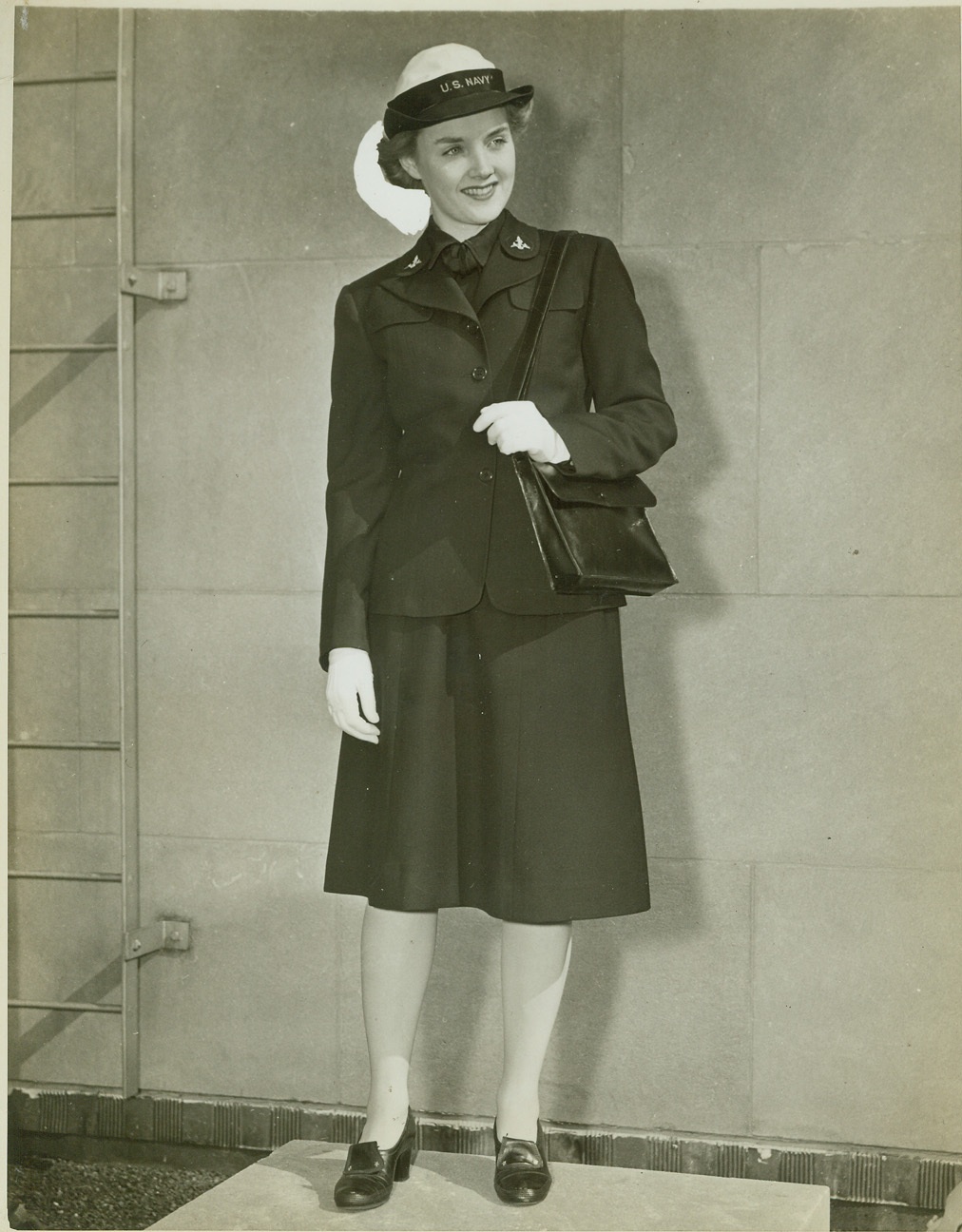
Uniform of WAVES’ Enlisted Personnel, 10/1/1942. NEW YORK – The enlisted personnel of the WAVES will wear a uniform exactly like that of their commanding officers’ except that black buttons take the place of gold, and rating marks on the upper sleeve supplant gold braid. The skirt is exactly the same, and the hat has a six section crown with wide stitched brim and a white crown for summer wear, replaced by a blue crown for winter. Both hats have a black band with “U.S. Navy” in gold. The Mainbocher designed uniform is modeled by Miss Ellen Allardice. Credit: (ACME);
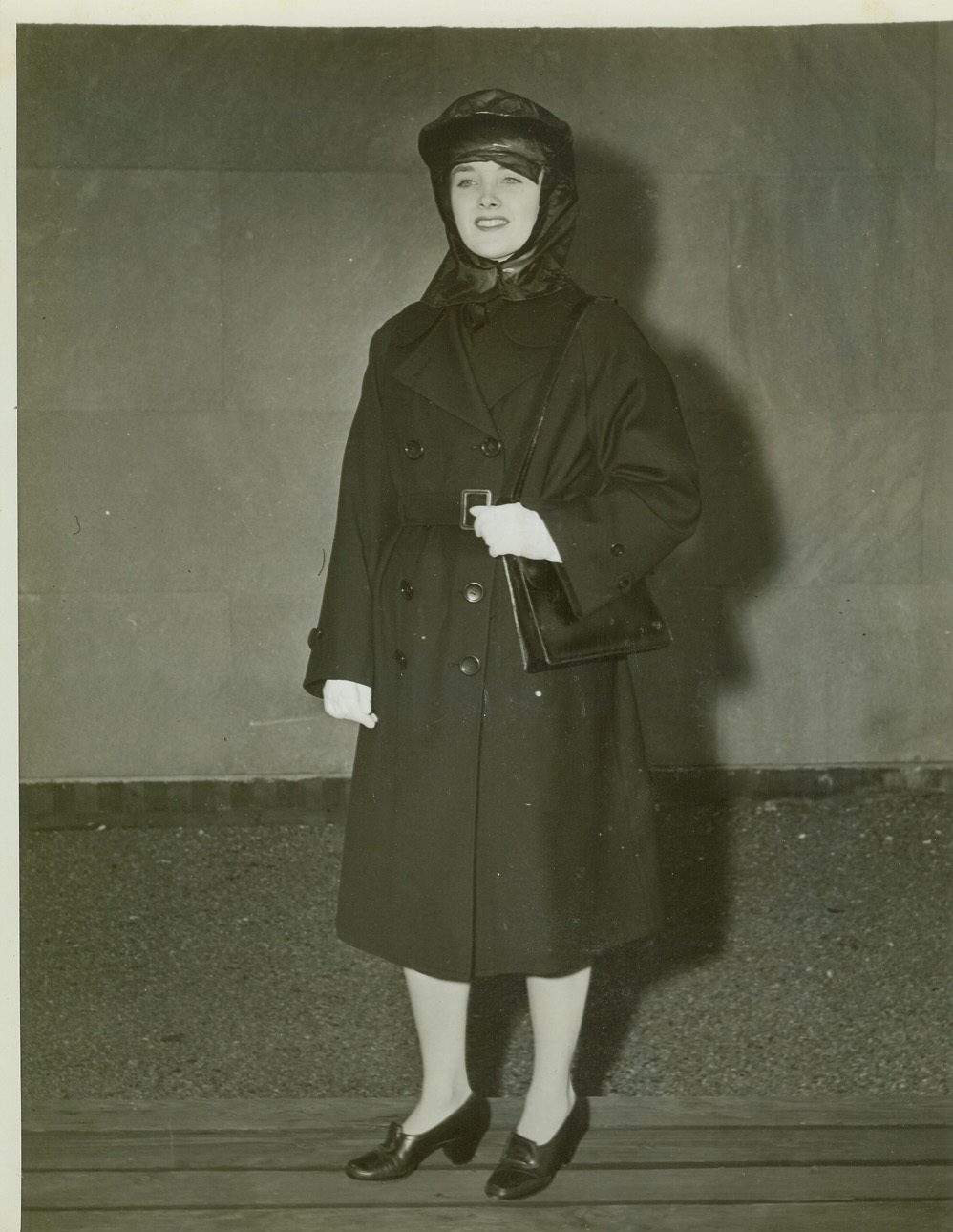
Uniform of Enlisted Wave, 10/1/1942. NEW YORK – Mainbocher designed this navy blue rain outfit that keeps its enlisted wearer as snug against the rains as her commanding officer in the WAVES. Underneath, the Navy enlistee wears a uniform designed like the officers’, except that buttons are black instead of gold, and rating marks on the upper sleeve replace gold braid. The new uniform is modeled by Miss Ellen Allardice. Credit: (ACME);
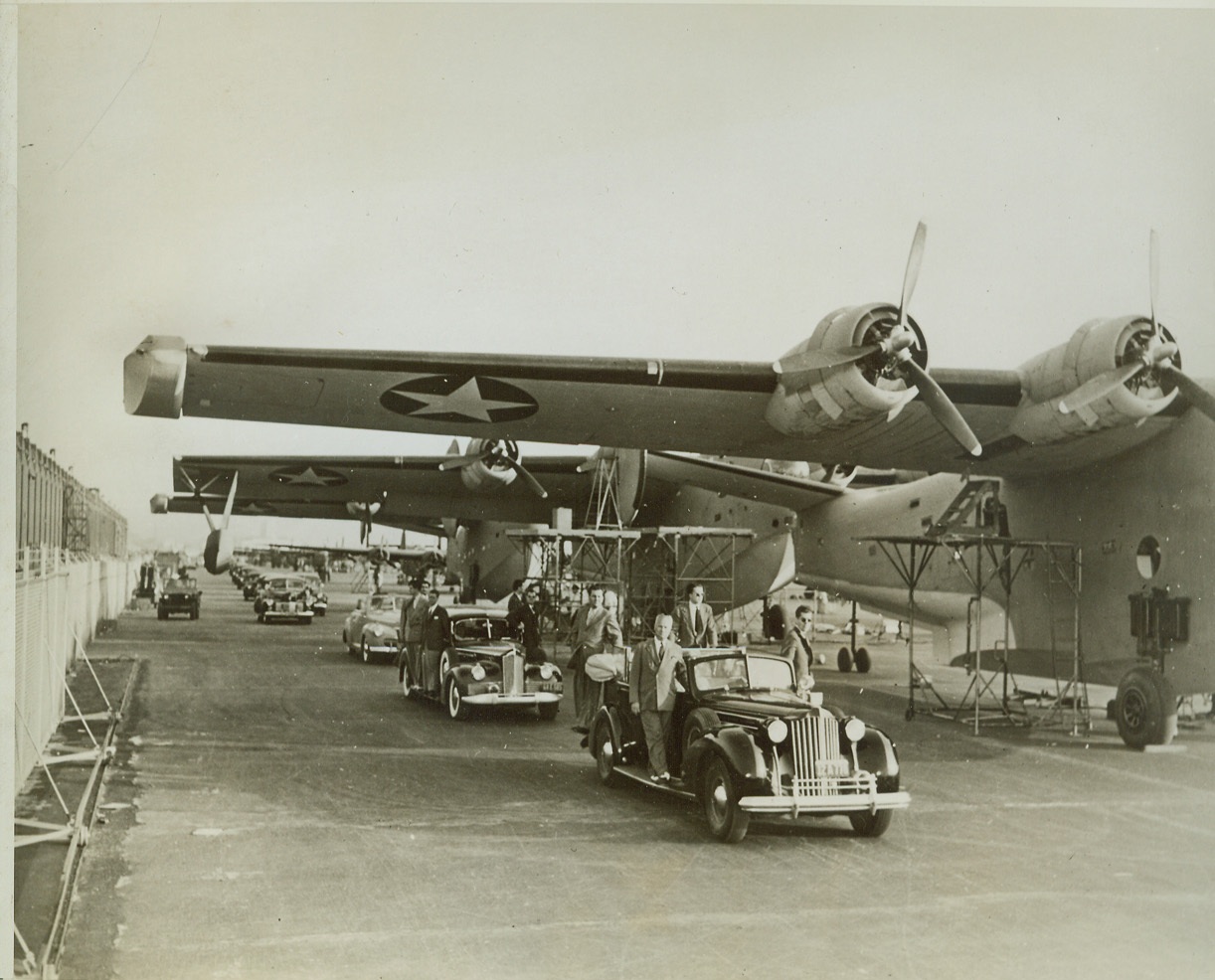
President Views Navy’s Giant Planes, 10/1/1942. San Diego, Calif.—During his tour of the nation’s defenses and war factories, President Roosevelt visited the consolidated aircraft plant in San Diego. Here, he is shown with his party inspecting huge Navy PB2Y patrol bombers. Credit: U.S. Navy photo from ACME.;
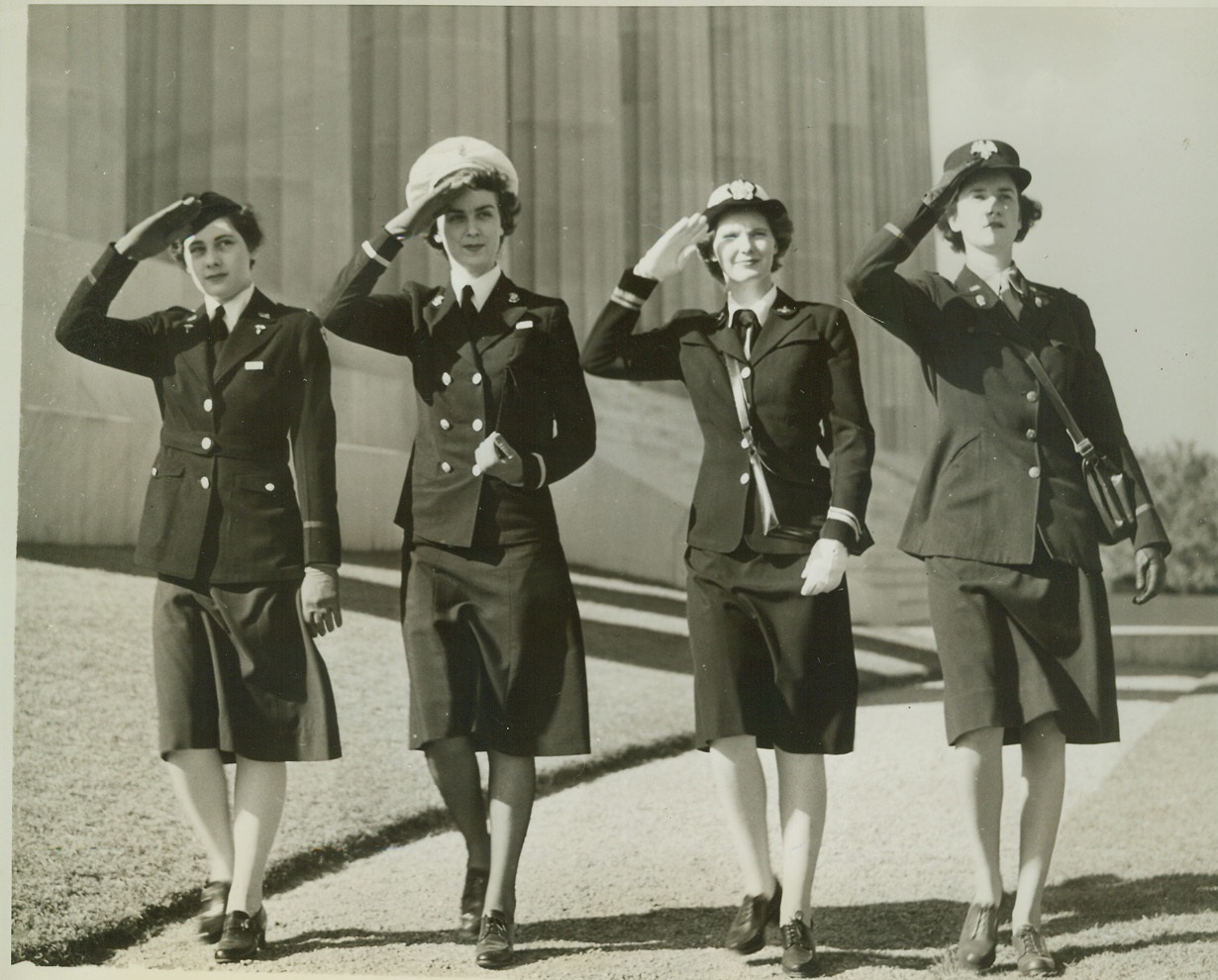
FEMININE SERVICE UNIFORMS, 10/10/1942. WASHINGTON—Attractive, Utilitarian, and Modern are the uniforms that have been approved for wear by the women who are members of the auxiliaries of the U.S. Armed Forces. Here the outfits of the Army Nurse, Navy Nurse, WAVE, WAAC, (Left to Right)- are displayed respectively by Lt. Doris Hyde of Lancaster, PA., Ensign Mary E. Hill of Elizabeth City, N.C., Lt. (JG) Marion Enright of Forest Hills, NY and Third Officer Alberta Holdsworth of Boston, NY. Credit: OWI Radiophoto from ACME;
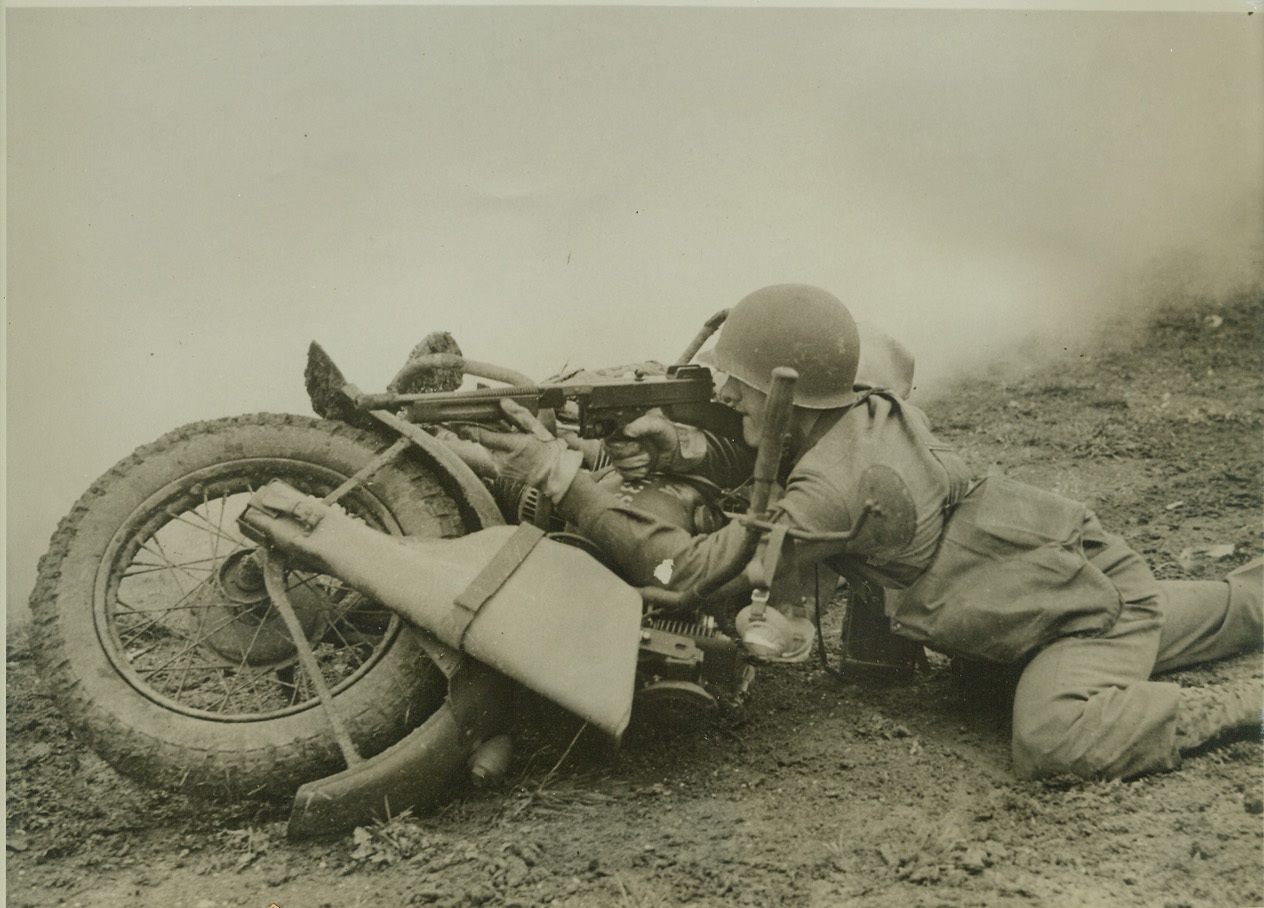
Two Uses for Motorcycle, 10/13/1942. ENGLAND -- Corp. Francis Rivers, of Cambridge, Mass., one of scouts of "attacking" forces during maneuvers of American troops in England, uses his motorcycle as a shield while firing at the "enemy." During these maneuvers, the use of chemical warfare was stressed for the first time. Credit: (ACME);
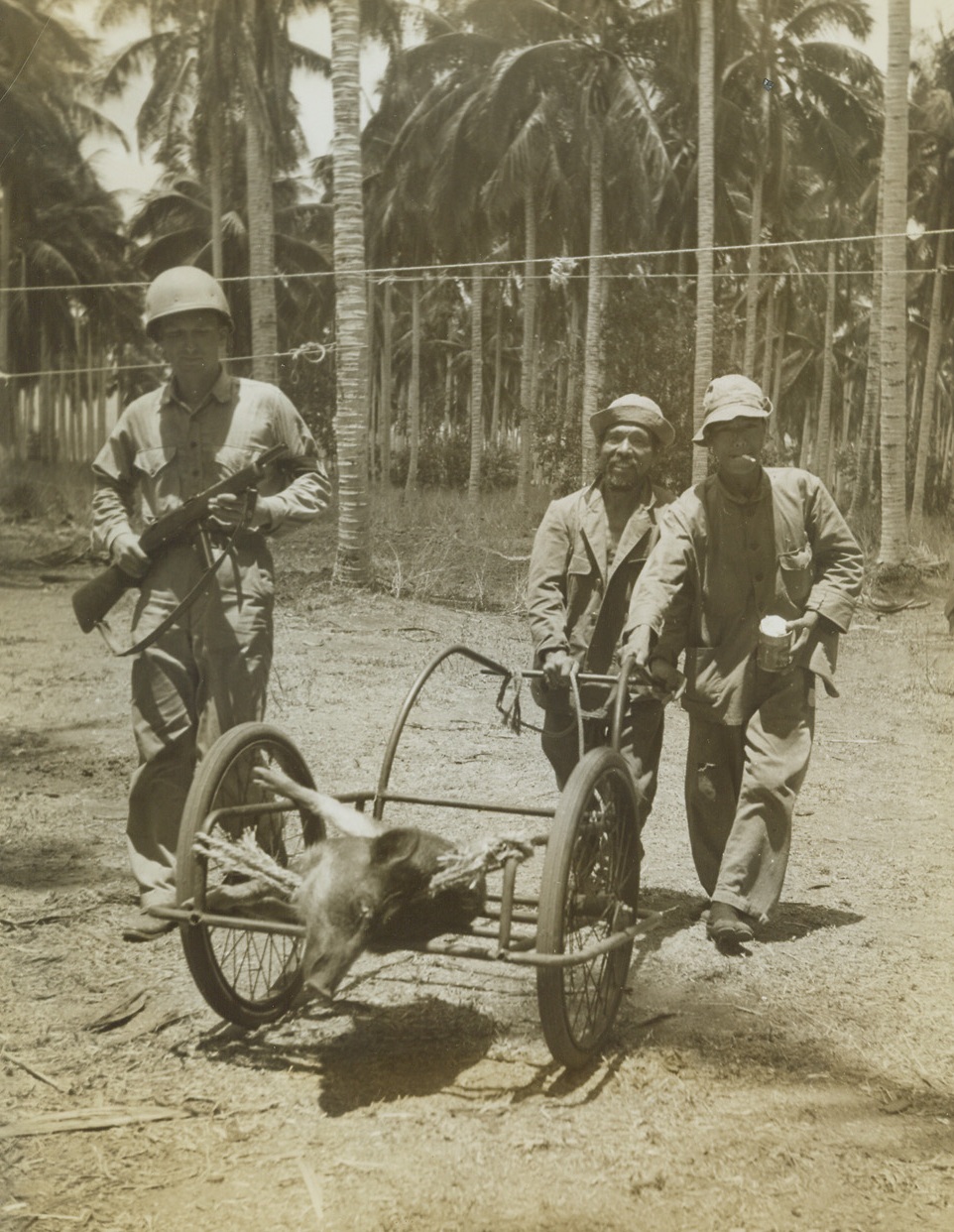
GUADALCANAL MARINES BRINGING HOME THE BACON, 10/14/1942. GUADALCANAL, SOLOMON ISLANDS—This remarkable photo indicates something of the daily life of U.S. Marines tenaciously defending their gains and advancing still more on Guadalcanal. Private M. G. Wiggins provides an armed escort for this wil pig, which he bagged near the Marine camp here. It provided his mates and himself with a welcome feed of fresh meat. Credit: Acme;
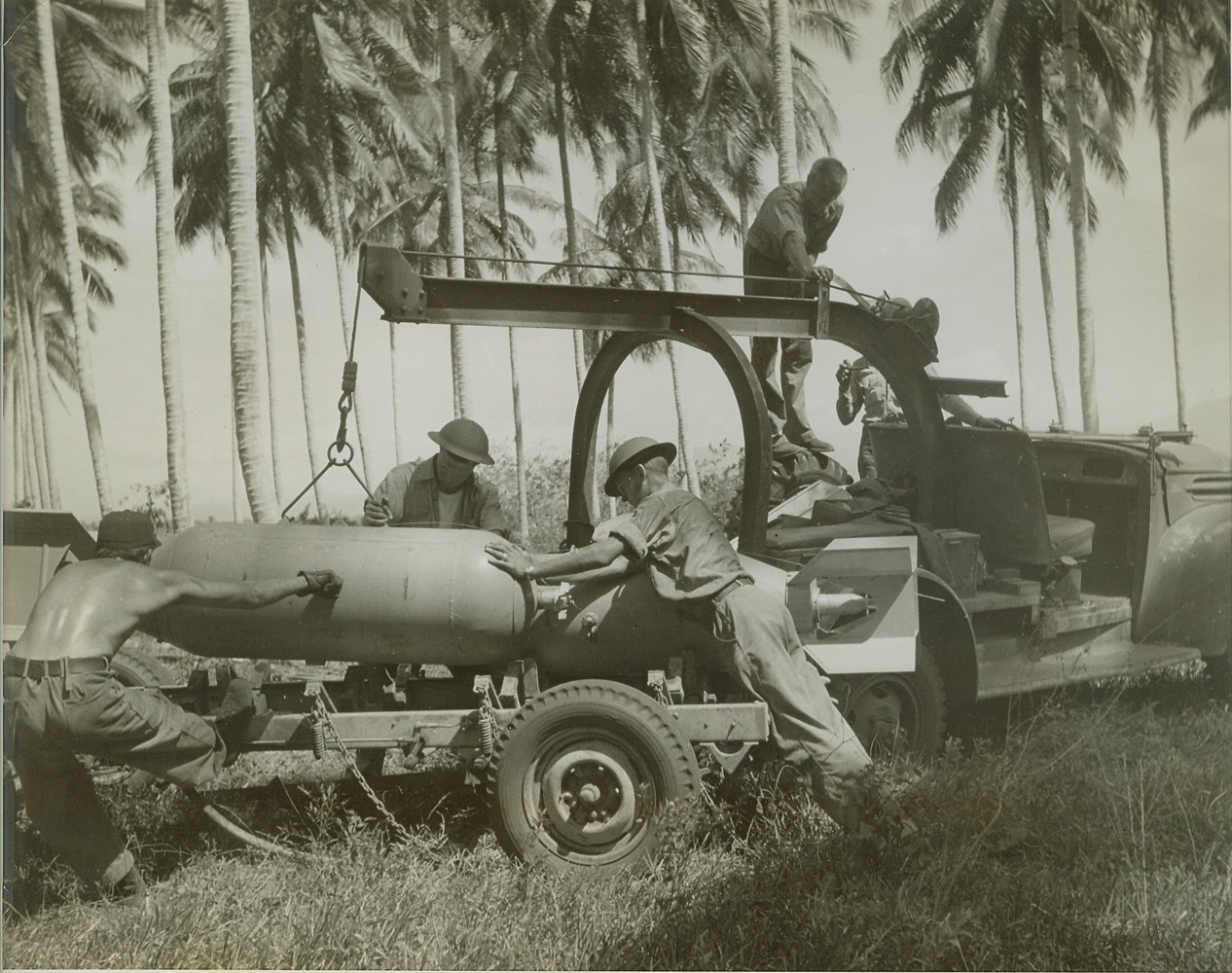
For Tojo -- Bad News from Guadalcanal, 10/14/1942. GUADALCANAL, SOLOMON ISLANDS -- With operational flights against Japanese ships and bases almost a daily affair, bomb loading crews of Marines on Guadalcanal airport are a busy lot. In this remarkable photo, bombs are being taken from "bomb gardens" concealed in palm trees, loaded on trailers and trundled onto the airport to be placed on U.S. Marine, Navy and Army bombers. Credit (ACME);
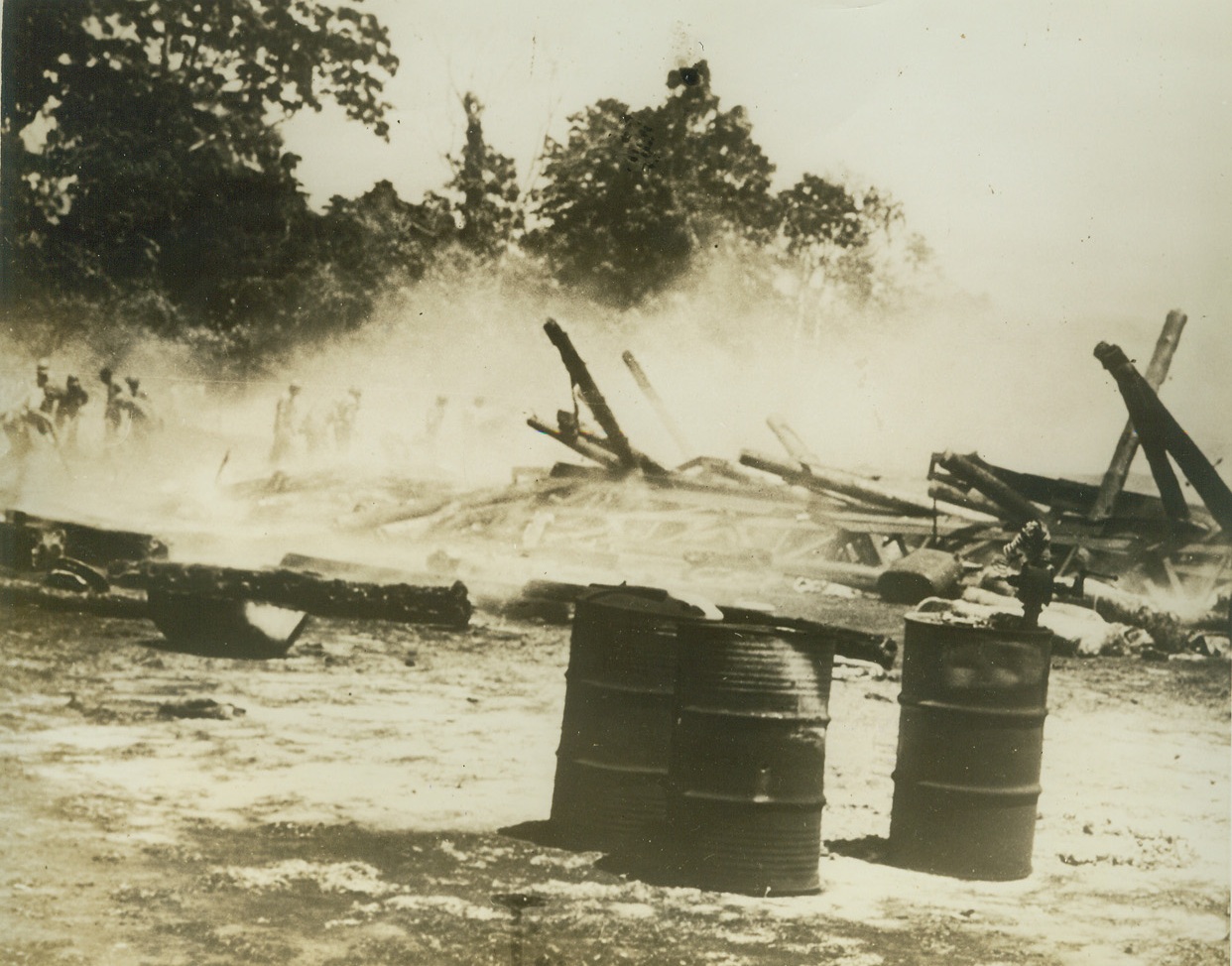
BATTLE RAGING IN THE SOLOMONS, 10/15/1942. United States Forces are striving to prevent the Japanese from landing reinforcements on Guadalcanal. The above photo just released by the US Navy shows—when a Japanese bomber scored a direct hit on this airplane hangar. The Japs are now intensifying their attacks on American positions, but at heavy cost. Credit: US Navy official photo from Acme;
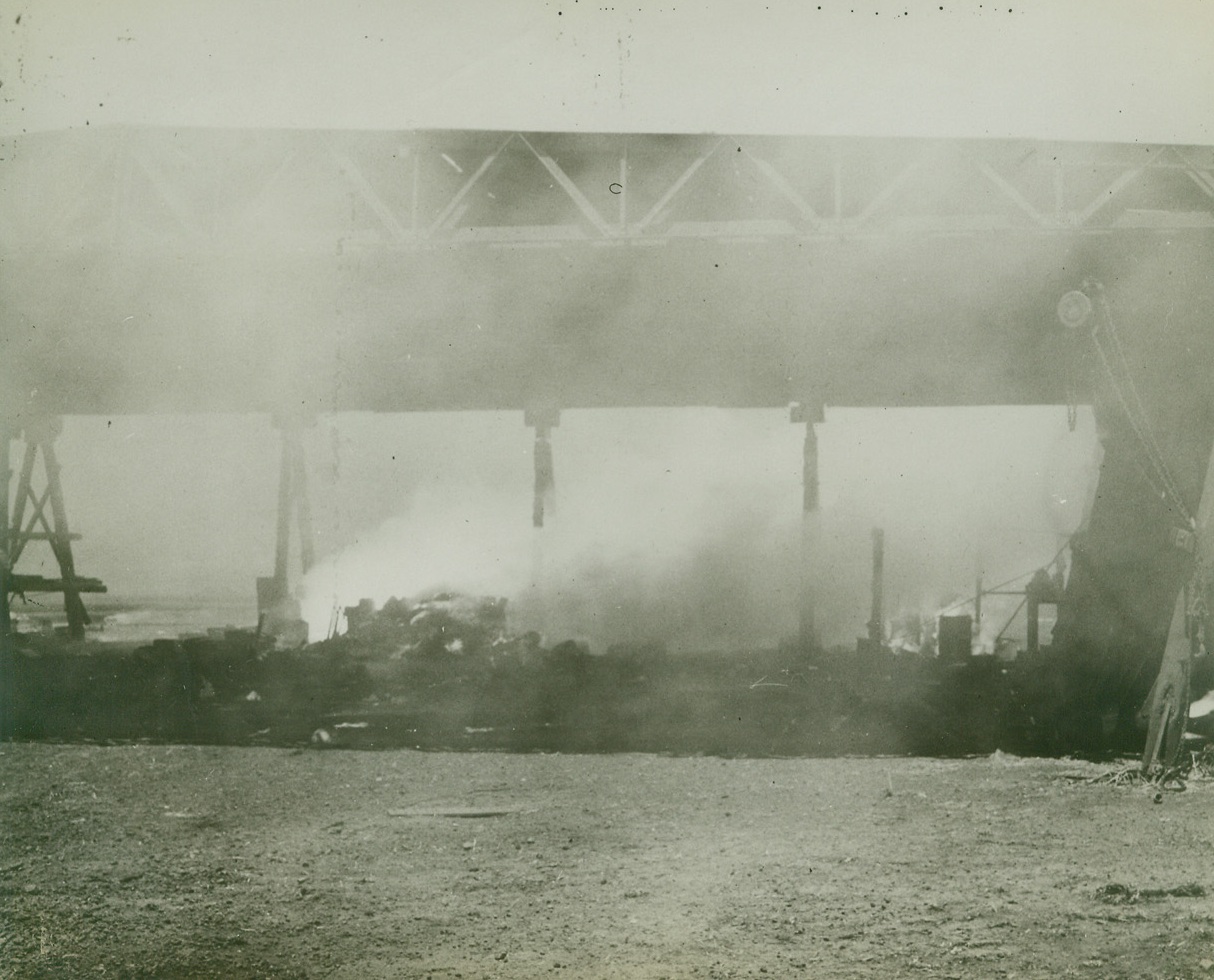
BATTLE RAGING IN THE SOLOMONS, 10/15/1942. United States Forces are striving to prevent the Japanese from landing reinforcements on Guadalcanal. The above photo just released by the US Navy shows-smoke and flame shrouding the remains of a hangar at Guadalcanal after a heavy Jap attack. Despite heavy losses in bombers, fighters and ships the enemy is increasing it’s pressure on American positions. Credit Line Navy Official Photo from ACME);

BATTLE RAGING IN THE SOLOMONS, 10/15/1942. United States Forces are striving to prevent the Japanese from landing reinforcements on Guadalcanal. The above photo just released by the U.S. Navy shows a U.S. Marine demonstrating that a Japanese flame-thrower, captured after the battle of Tenaru, is an effective weapon. Credit Line (U.S. Navy Official Photo from ACME);
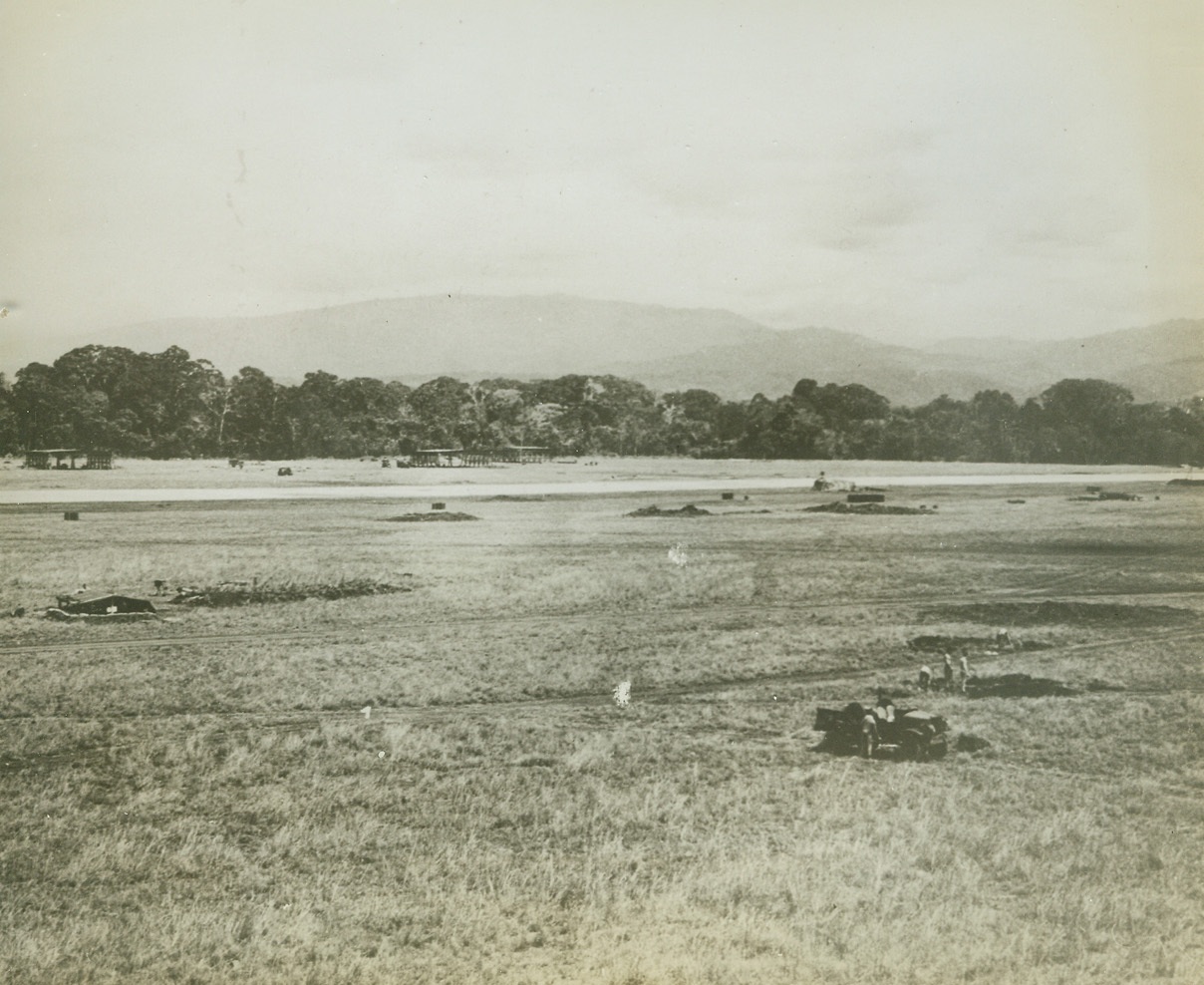
Battle Raging in the Solomons, 10/15/1942. United States forces are striving to prevent the Japanese from landing reinforcements on Guadalcanal. The above photo just released by the US Navy shows the highly strategic airfield on Guadalcanal which U.S. Marine wrested from the Japanese during the forepart of operations in the Solomons islands. The Japanese within the past two days have repeatedly bombed and shelled the field and other Marine positions. This photo shows Marines filling in shell holds made during earlier fighting.Credit Line (U.S. Navy official photo from ACME);
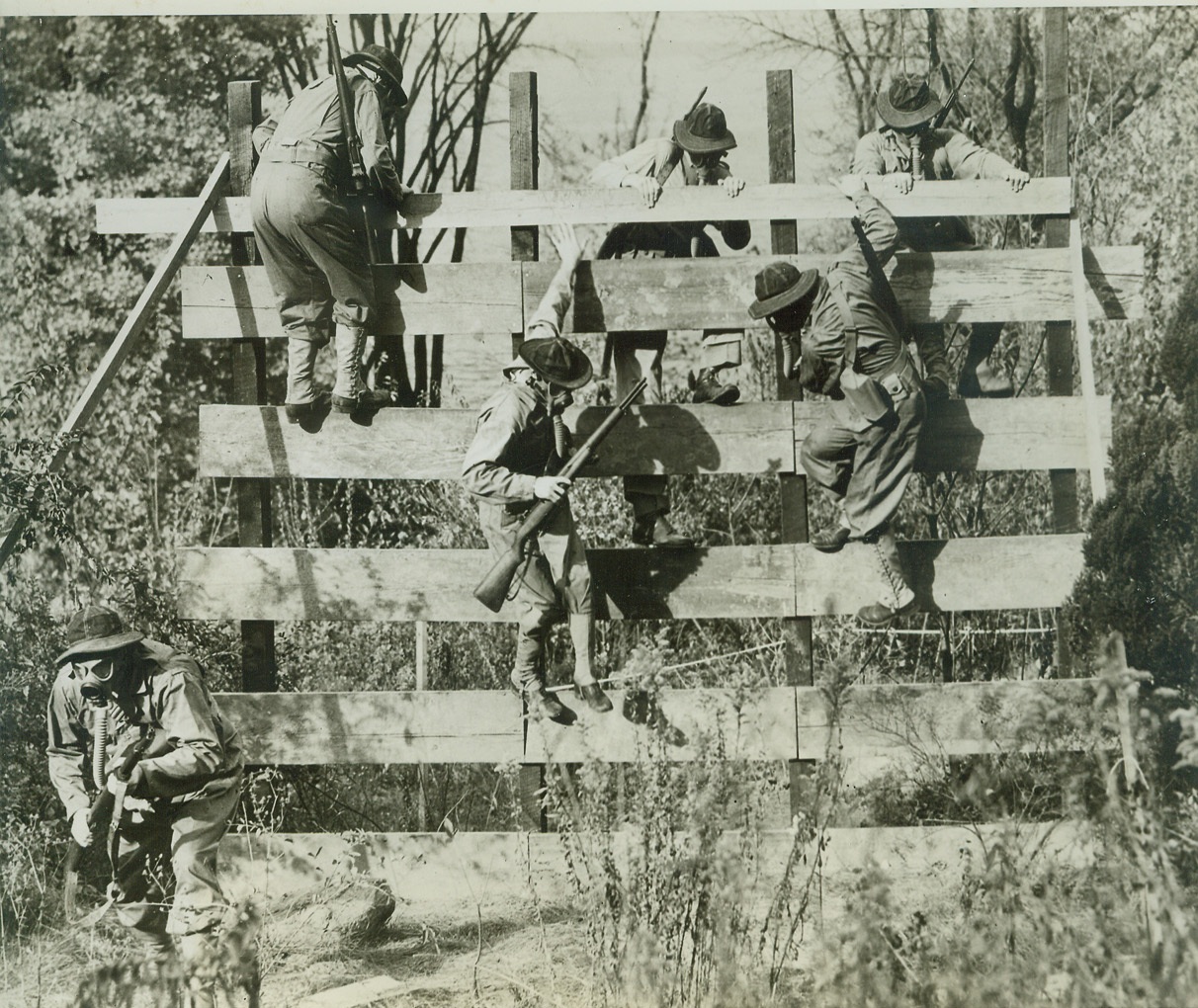
College Commandos Cut Capers, 10/16/1942. Madison, Wisc. – It’s up and over the hard way for the Wisconsin Rangers, unique unit of the University of Wisconsin’s ROTC, patterned after the American Rangers now in foreign service. Wearing gas masks, the Badger cadets carry Garand rifles, Tommy-guns and Walkie-Talkies in their equipment as they maneuver across a 400 yard obstacle course built on the Wisconsin campus. Credit: (ACME);
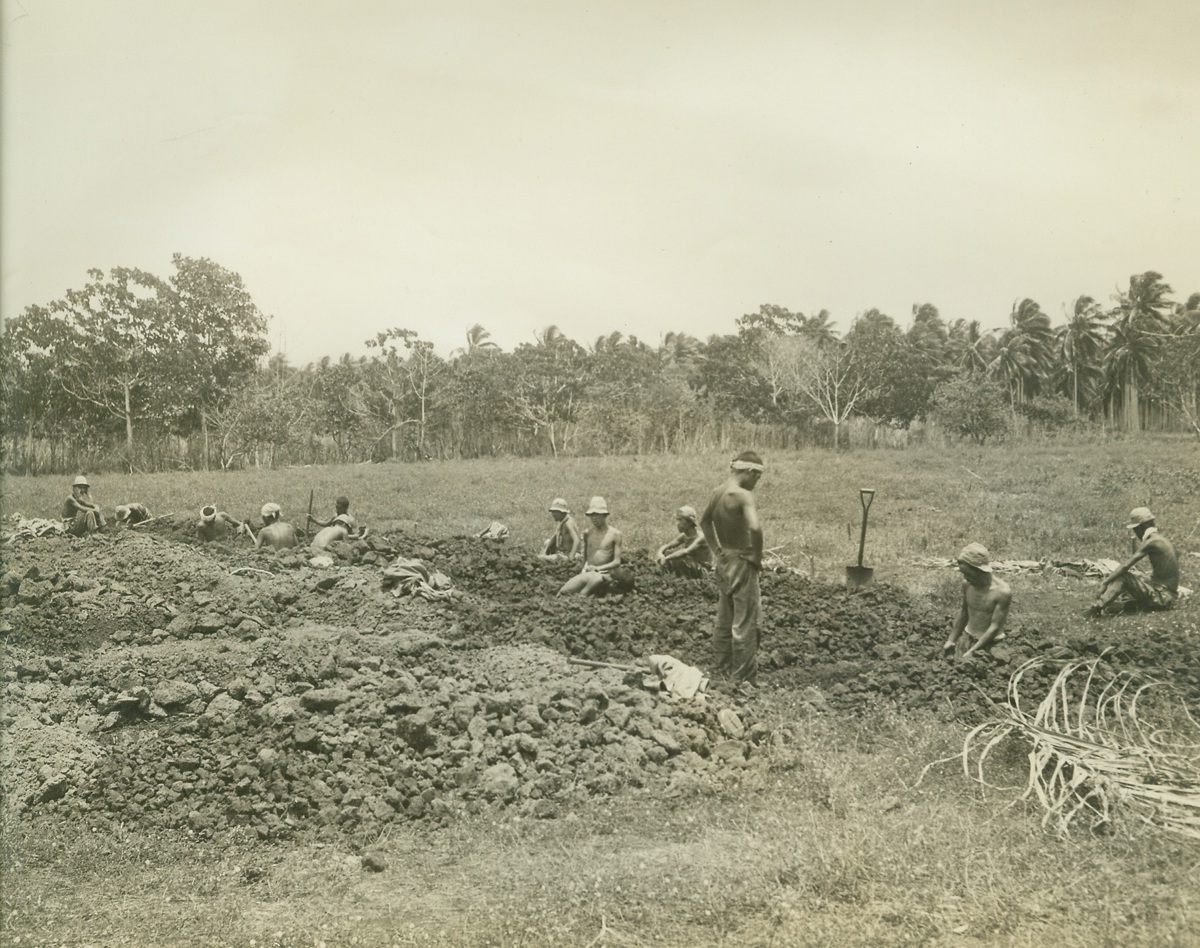
CAPTURED JAPS AT WORK ON GUADALCANAL, 10/17/1942. SOLOMON ISLANDS—Japs captured by the U.S. Marines on Guadalcanal are made to earn their keep. Here members of a Jap prisoner labor unit are shown preparing graves for those who have fallen in battle. Credit: Acme;

FORTRESSES ON STRATEGIC AIRPORT, 10/17/1942. SOLOMON ISLANDS—here’s why that airport on Guadalcanal Island is being fought for so savagely by U.S. and Jap forces in the Solomons. It’s the only field in the area where Uncle Sam’s Flying Fortresses and other big bombers can take off and land for operations against the enemy. Here two of the big Fortresses roar down the long runway. Credit Line (ACME);
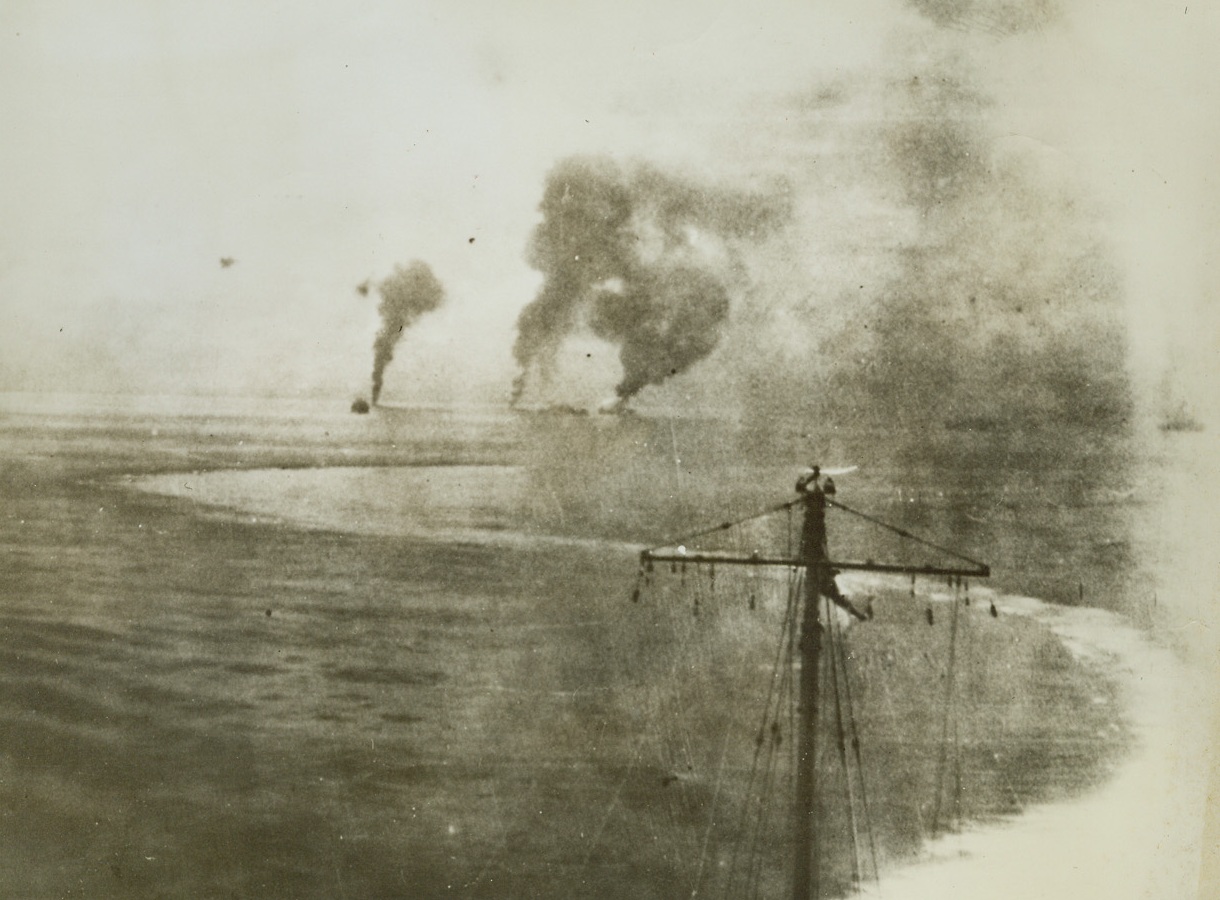
Torpedo Bomber Attack, 10/17/1942. Solomon Islands – The sharply–curving wake of an Australian Cruiser shows how the vessel twisted and turned to avoid a Jap torpedo-bomber attack during the fighting in the Solomon Islands. Columns of smoke rise from three downed bombers. Credit: ACME;
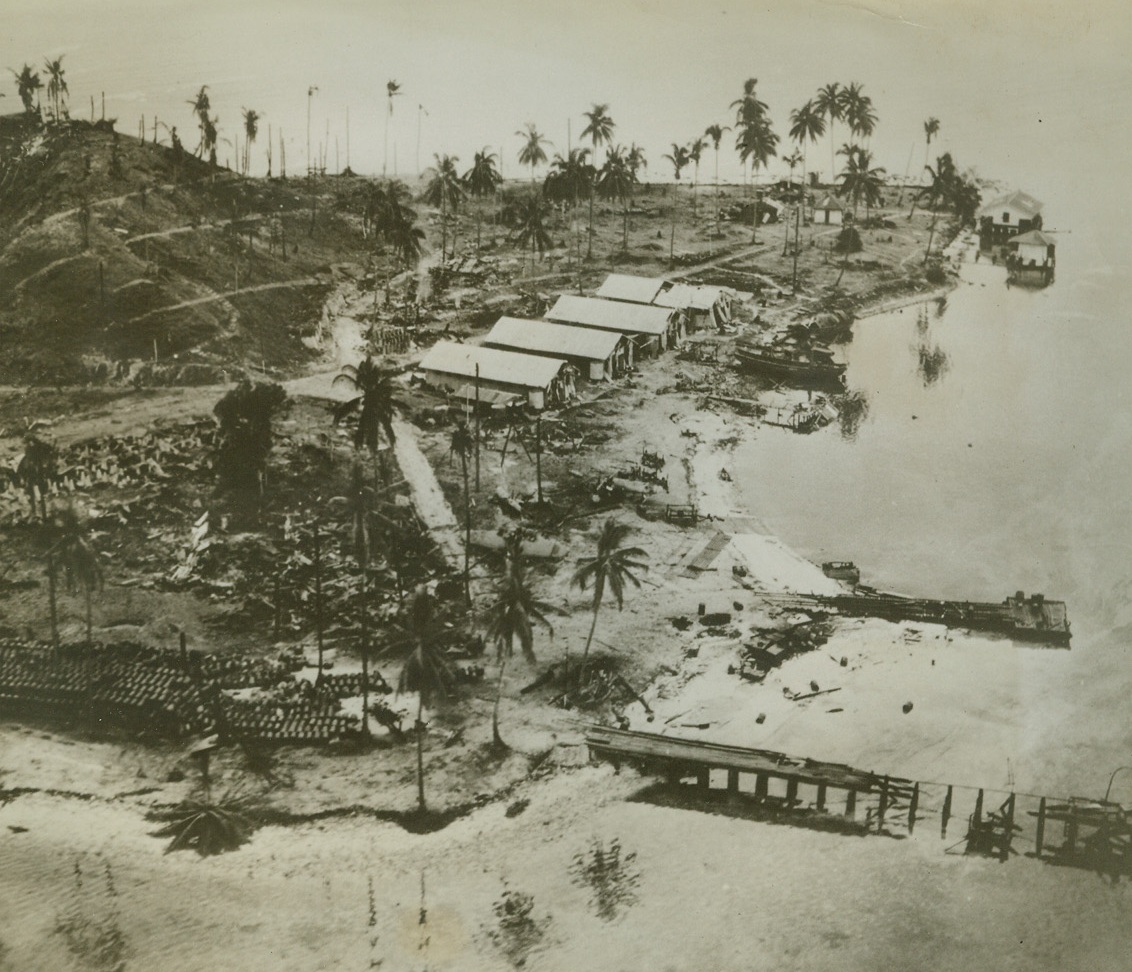
Damage to Japs in Solomons, 10/17/1942. Solomon Islands – Buildings and piers on the Jap-held Tanambago island show the wreckage caused by heavy bombing attack of American airmen. The raid was part of the U.S. drive on the Solomons.Credit (Official US Navy photo from ACME);
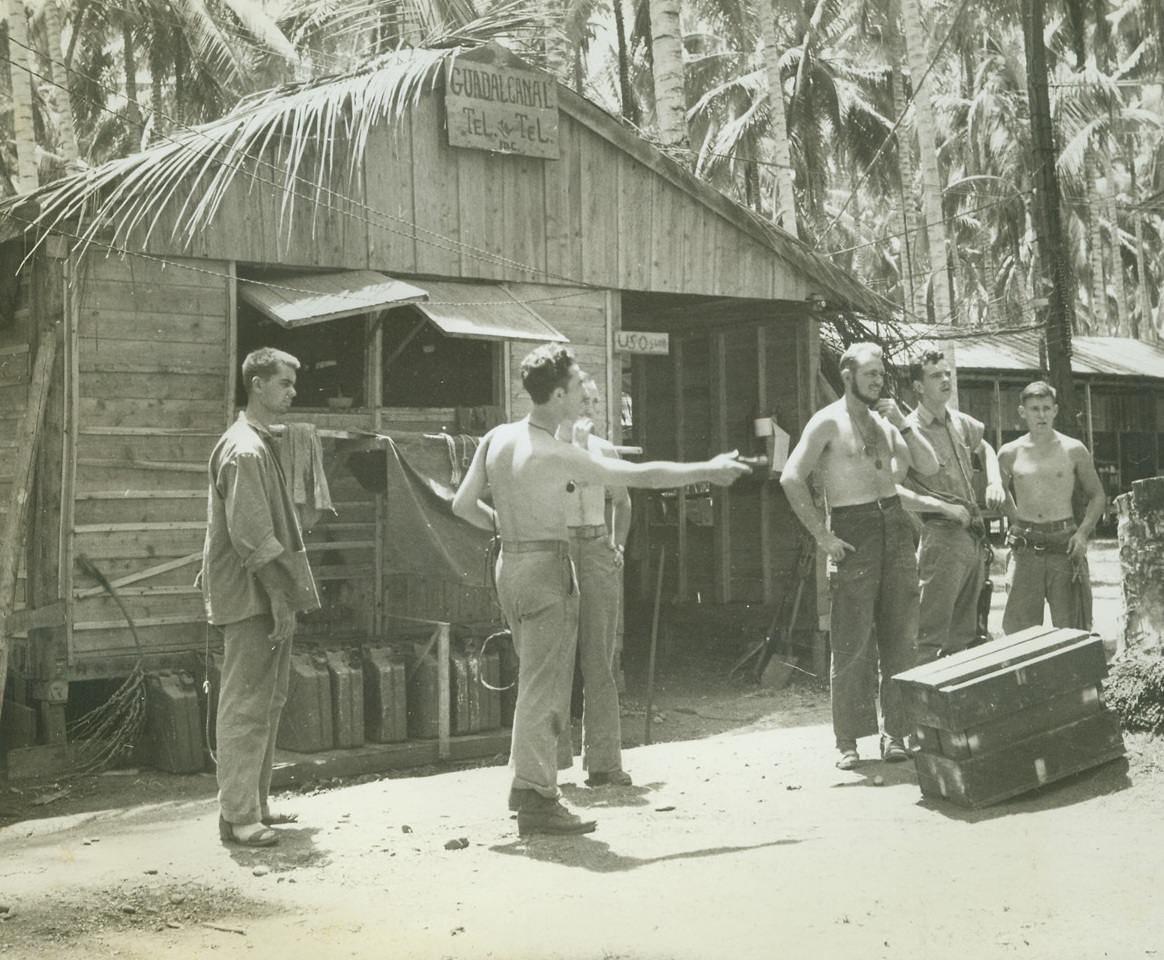
Telephone Building on Guadalcanal, 10/17/1942. Solomon Islands – Among the most imposing structures in almost any town is the telephone company building, and this is true of the U.S. Marines bas on Guadalcanal island, where anything more substantial than a tent is considered citified. Here some of the “tel and tel” crew who are doing valuable work in maintaining communications for the Marines are shown outside of their headquarters. Credit Line (ACME);
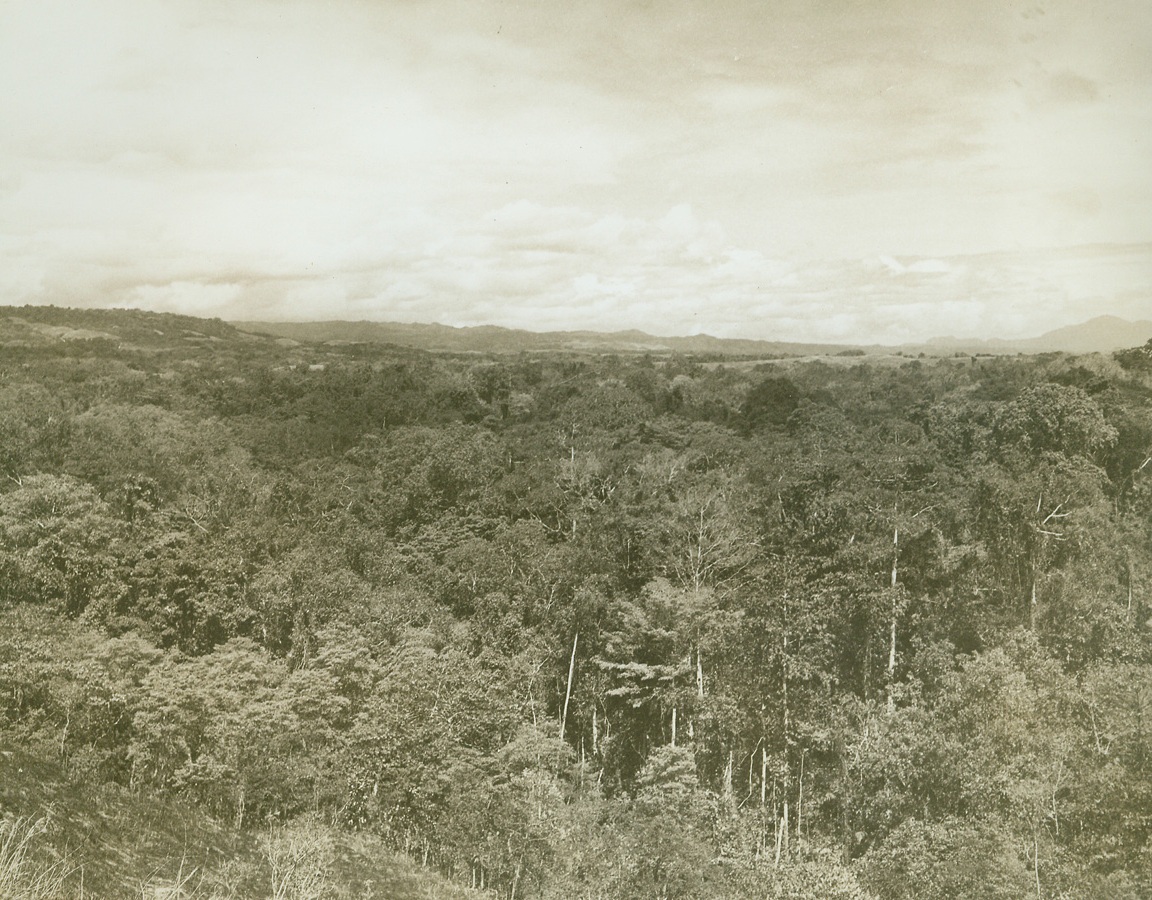
No Title. 10/17/1942. SOLOMON ISLANDS - These dense jungles are what U.S. forces are fighting for, in, around, and over on the island of Guadalcanal. This is a view of part of the territory for which U.S. and Jap forces are clashing desperately, as seen from one U.S. Marine outpost.;
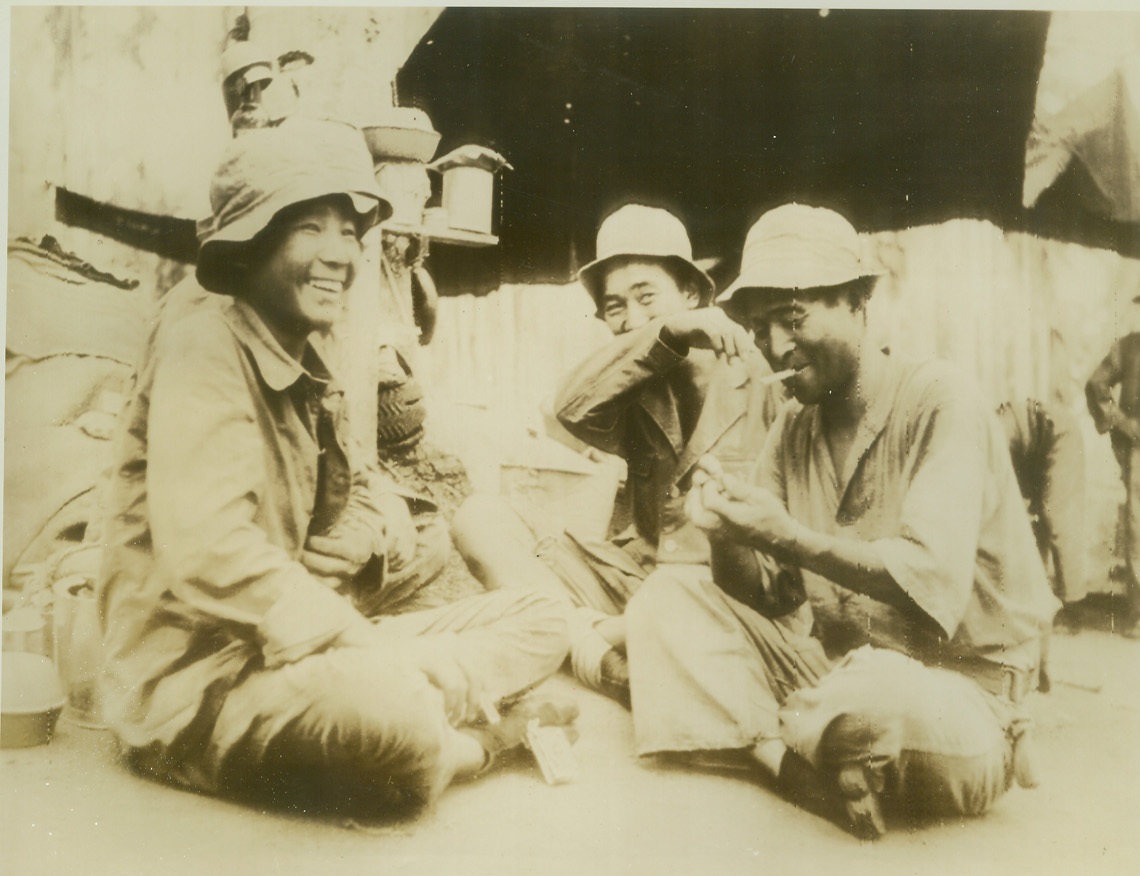
BEING U.S. PRISONER LOOKS LIKE GOOD STUFF, 10/19/1942. SOMEWHERE ON GUADALCANAL ISLAND – Japanese prisoners of war seem anything but unhappy as they light up American-made cigarettes, of which, incidentally, they receive 10 a day. The Nips were nabbed in the recent fierce Solomon Island action. Credit: ACME;
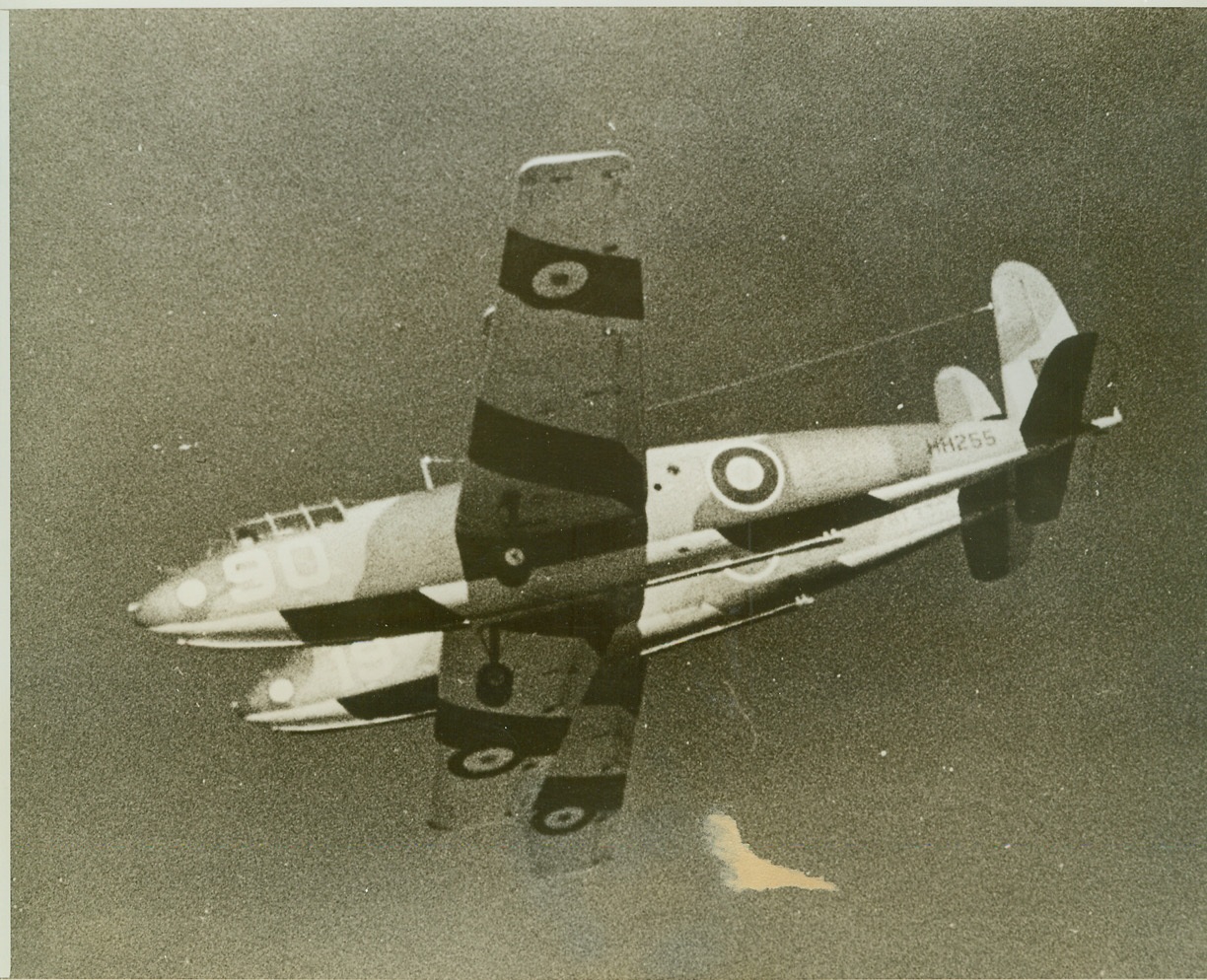
Close Order Drill, 10/19/1942. England—Two gliders fly in close formation training flight of Britain’s Glider Regiment, which is now learning how to control and navigate Hotspur Gliders under the tutelage of the R.A.F. The trainees, all Army men, will take their places as front line troop carriers for airborne regiments. Credit: ACME;

Bad Medicine for Japs, 10/20/1942. These cannon-armed P-39 U.S. Army Air Forces fighter planes are of the type that have combined with Navy and Marine planes to take a heavy toll of Japs in the battle of the Solomon Islands. These speedy pursuit planes were photographed some time ago at the vital Guadalcanal air field. Note shark-nose markings made famous by the American volunteer group in China.Credit Line (US Marine Corps photo from ACME);
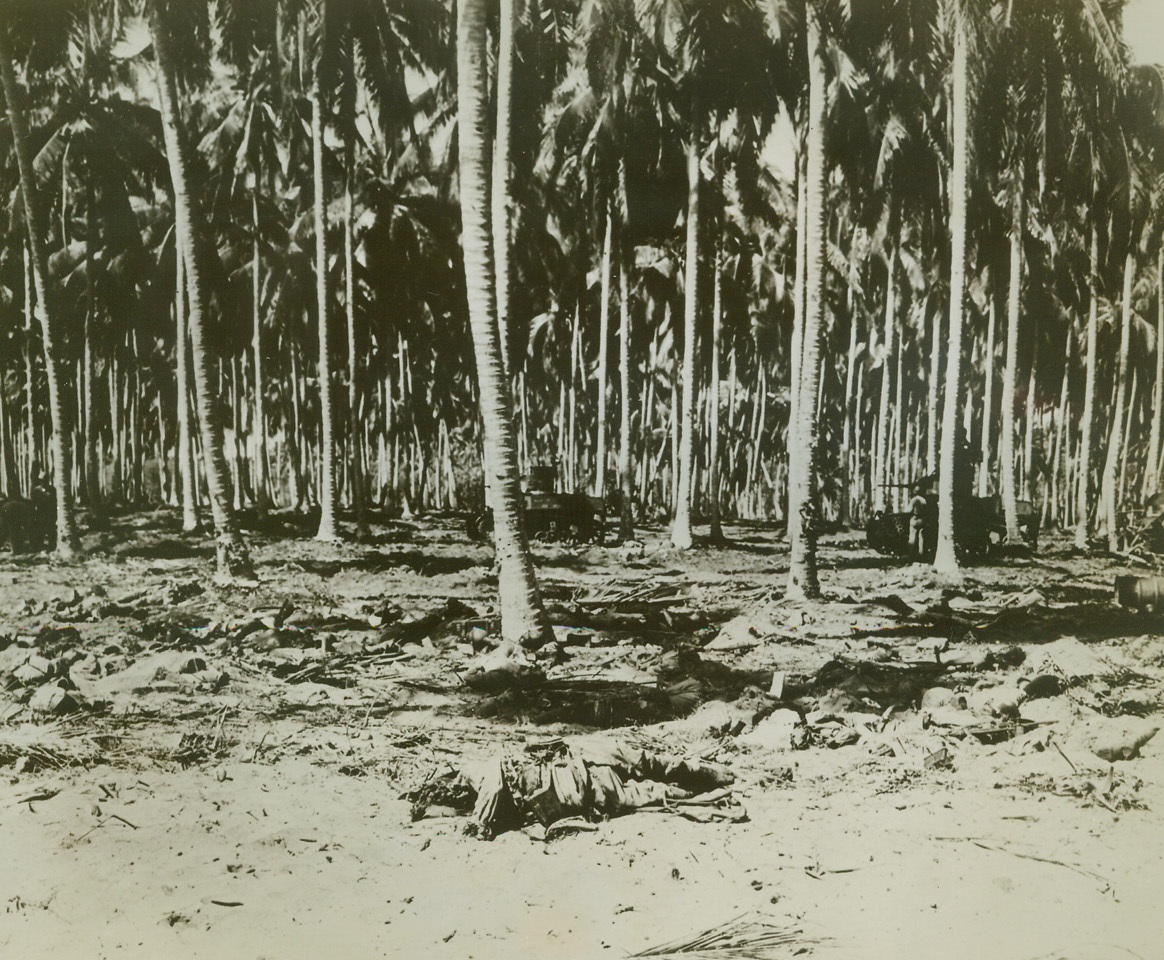
Where U.S. Marines Caught Japs, 10/20/1942. The bodies of Japanese can be seen sprawled on the ground under palm trees, in this photo which was taken just after the battle of Tenaru River, on the key Solomon island of Guadalcanal. In background, U.S. Marines with tanks mop up the battlefield. Credit Line (U.S. Marine Corps photo from ACME);
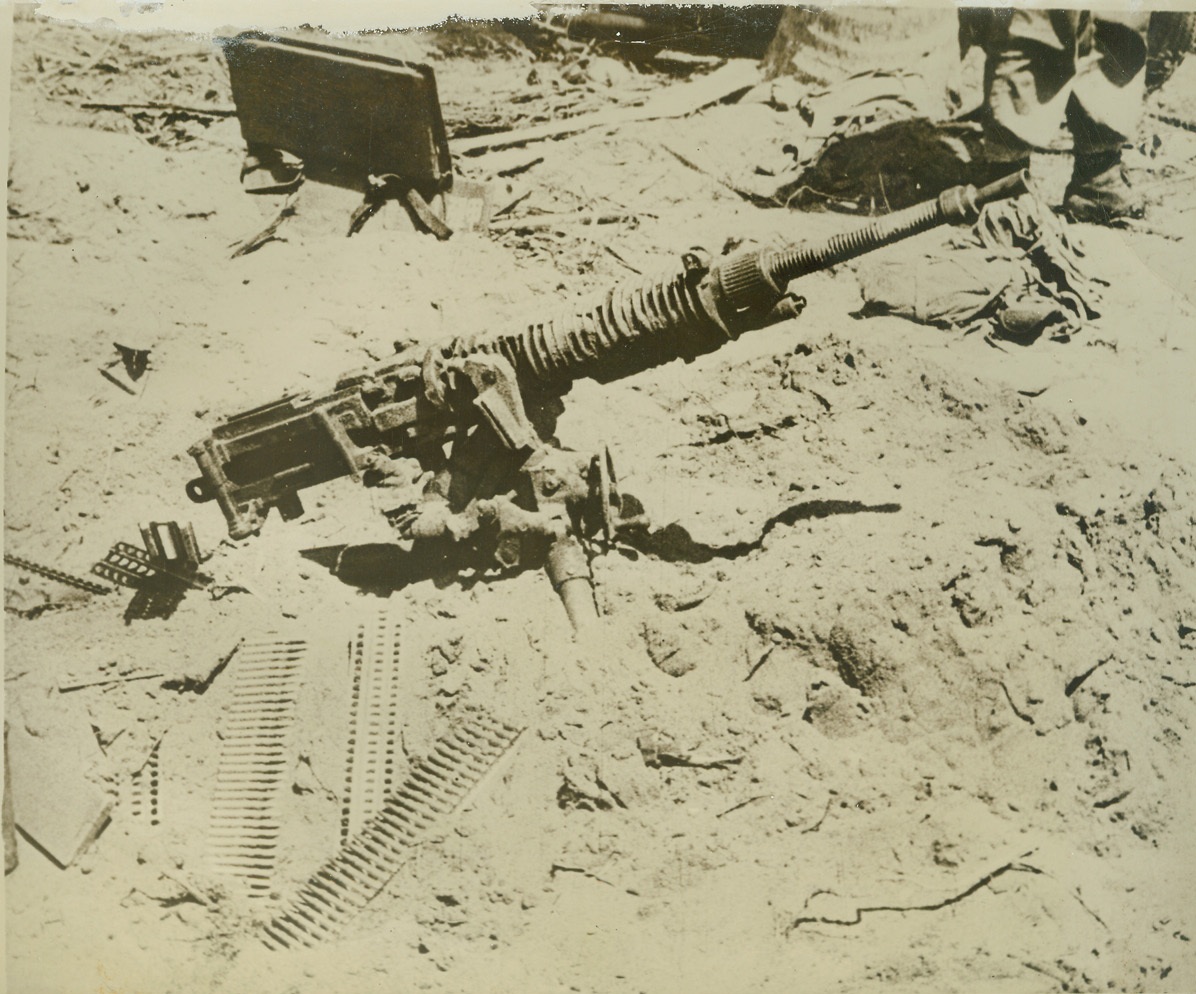
JAP MACHINE GUN CAPTURED IN SOLOMON AREA, 10/21/1942. This photo, which has just been released and which is from an official U.S. Marine Corps newsreel, shows a captured Japanese machine gun, covered with sand and with its ammunition strewn about on the ground. It was apparently dropped in haste as U.S. forces attacked the gun placement during recent heavy fighting in the Solomon Islands battle area. Credit: U.S. Marine Corps photo from ACME;
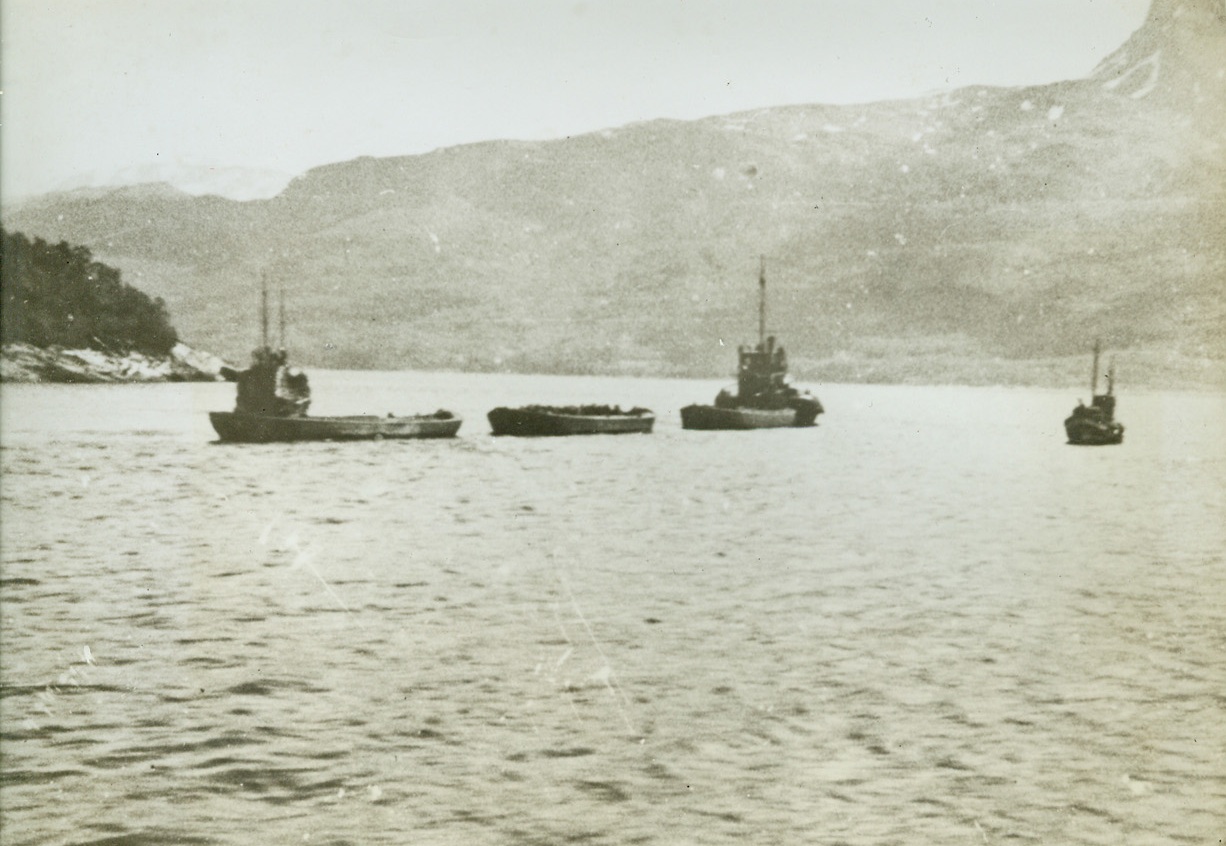
SERB PRISONERS ARRIVE IN NORWAY, 10/21/1942. Last June some 900 Serb intellectuals, prisoners ranging in age from 12 to 70, reached Ofoten, Norway, where they were brutally ill-treated and starved in Nazi labor camps. In the camps at Beisfjord and Mo, the unhygienic conditions and undernourishment caused an outbreak of spotted typhus and between 200 and 300 prisoners affected were shot in cold blood and barracks and bodies were burned. The remaining 600 prisoners were transported in barges without water and with little food, and later in lorries in wire cages 3 feet high. Then after being sprayed with creosote and Lysol, they finally reached Jernvannet, where they were compelled to sleep in the open air. In the above photo, the Serb prisoners are shown being transported in barges to their destination. Credit Line (ACME);
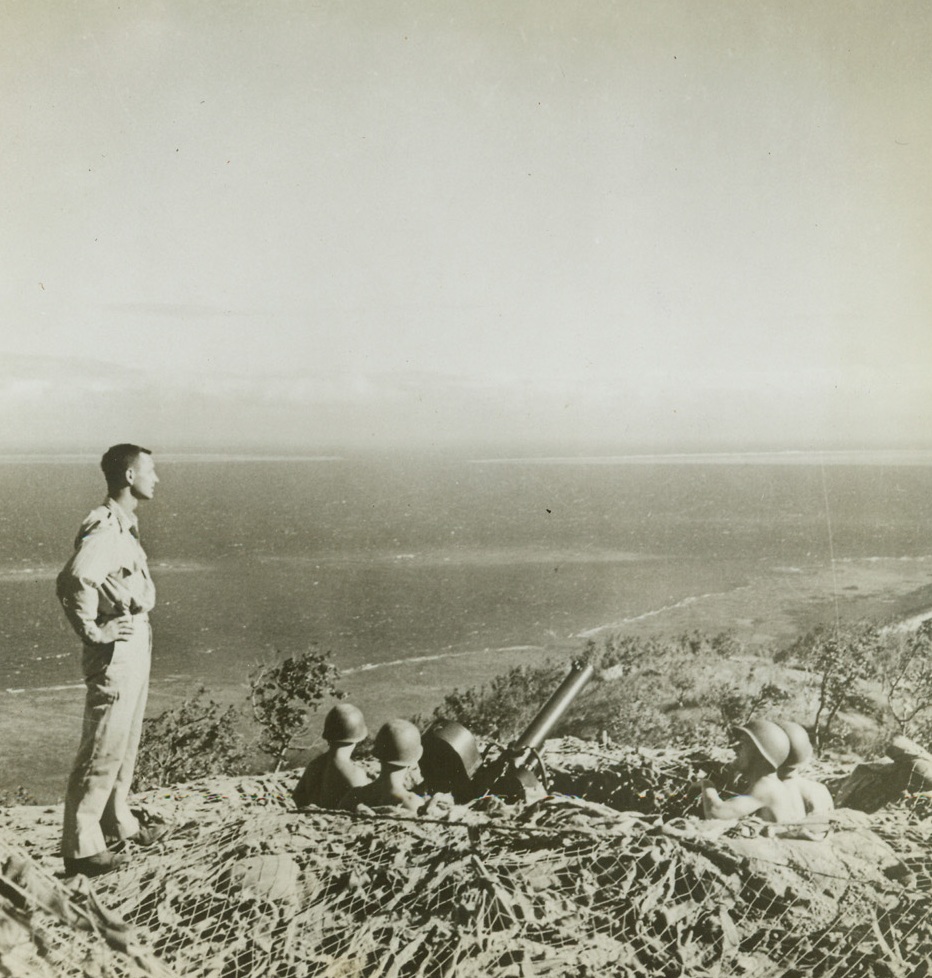
High Watch, 10/21/1942. New Guinea – U.S. Anti-Aircraft Gunners watch the skies high above Port Moresby’s shore. Below them lies the Coral Sea. Lawrence B. Kelly, of Bainbridge, GA., stands over the gun crew at left. Credit: ACME;
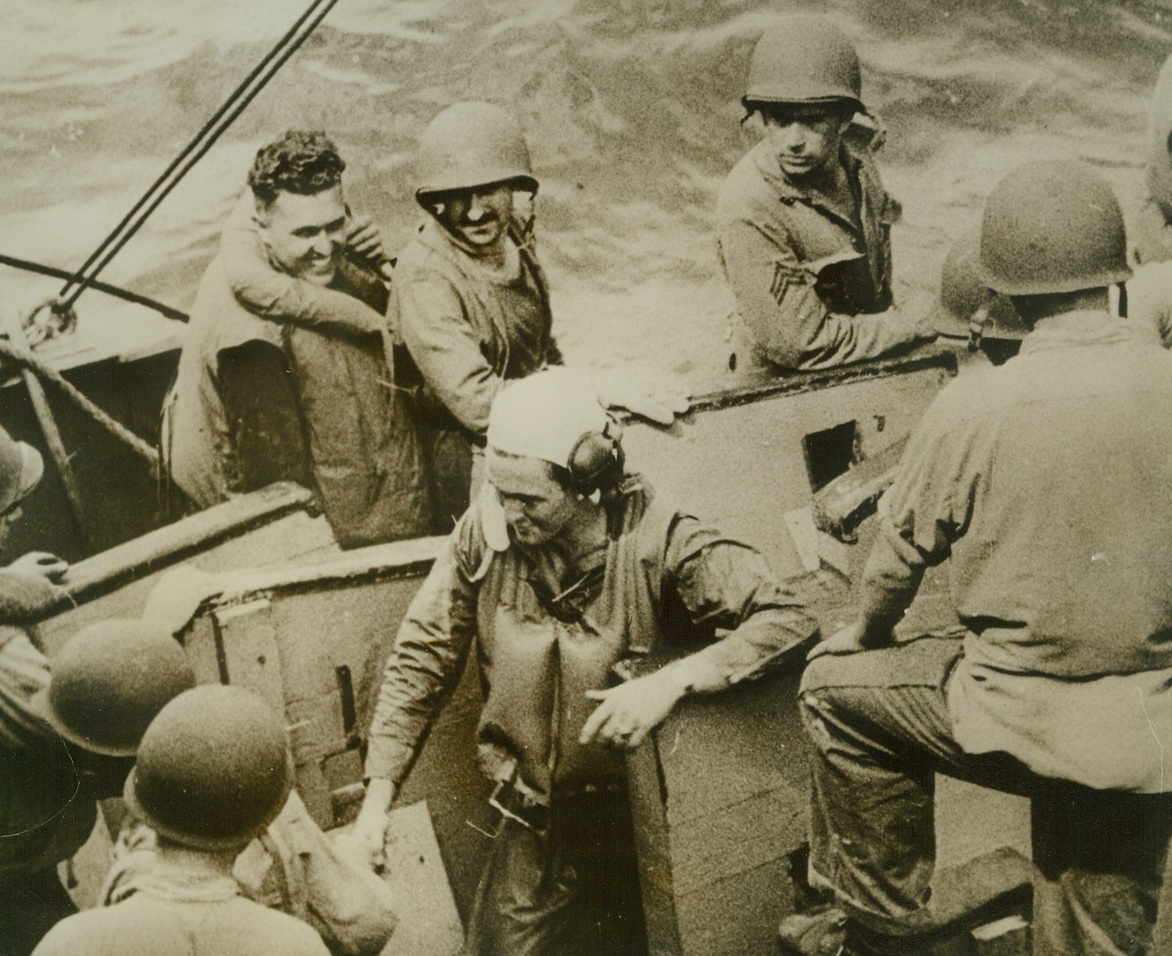
American Pilot Rescued in Solomons, 10/21/1942. This photo, which has just been released and which is from an official U.S. Marine Corps newsreel, shows an American pilot shaking hands with a rescuer, one of the quick-acting U.S. Marines in the group which saved the flier from a watery grave after his plan had been forced down in Solomon island waters during recent fierce fighting there.Credit Line (U.S. Marine Corps photo from ACME);
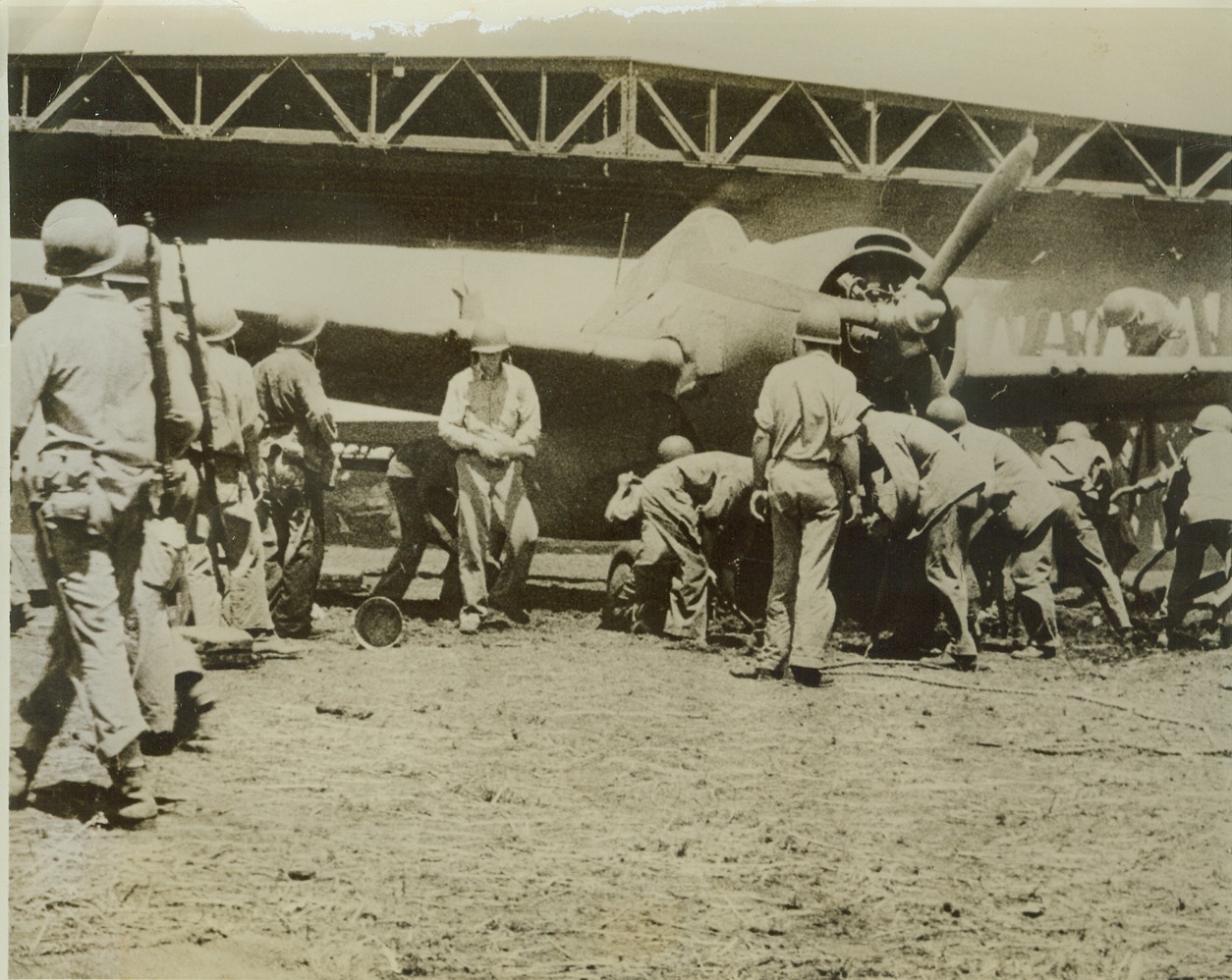
U.S. Plane Salvaged From Jap-Bombed Hangar, 10/21/1942. This photo, which has just been released and which is from an official U.S. Marine Corps newsreel, shows American marines salvaging a plane from a blazing hangar at Henderson Field on Guadalcanal Island, after a recent Jap bombing raid on that strategic key point of the U.S. defenses in the Solomon Islands. Credit: (U.S. Marine Corps Photo from ACME);
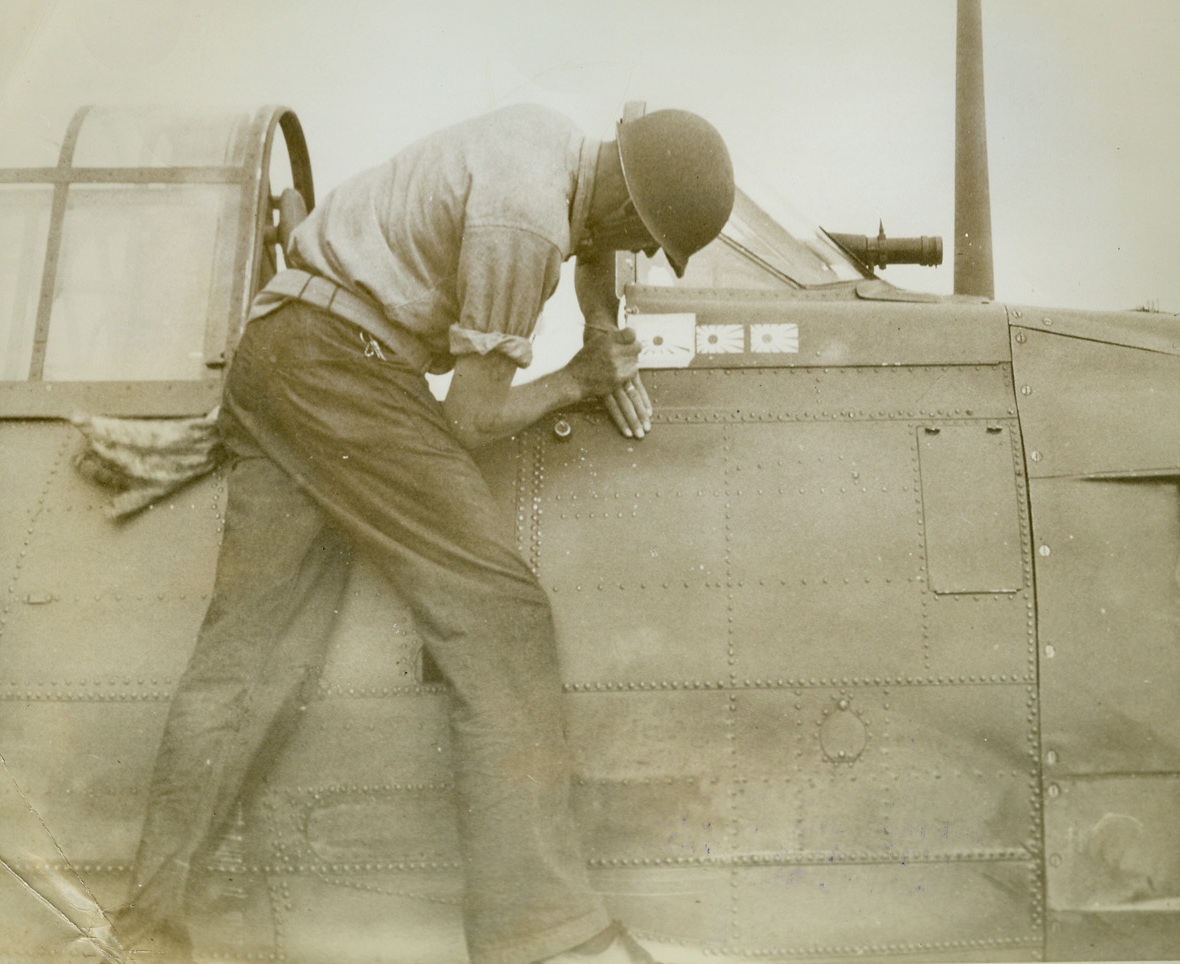
Another Jap “Notch” for This Fighter, 10/22/1942. A sailor aboard one of Uncle Sam’s aircraft carriers adds a third tiny rising sun flag to the “scoreboard” on the cowling of a U.S. Navy fighter plane, signifying that it’s guns have blasted three Jap planes out of the skies and sent their crews to their “Hon. Ancestors.” This photo was released by the Navy Department in Washington, today.Credit Line (U.S. Navy photo from ACME);

Dead Japs, 10/26/1942. Guadalcanal, S.I. – U.S. Marines look over the bodies of Jap soldiers on the beach at Guadalcanal, following a disastrous attempt by the Japs to land reinforcements. The Marines, holding firmly to their newly constructed shore positions were too much for the invaders, who were annihilated as Yankee airmen blasted enemy ships and landing boats.Credit Line (Marine Corps Newsreel from ACME);
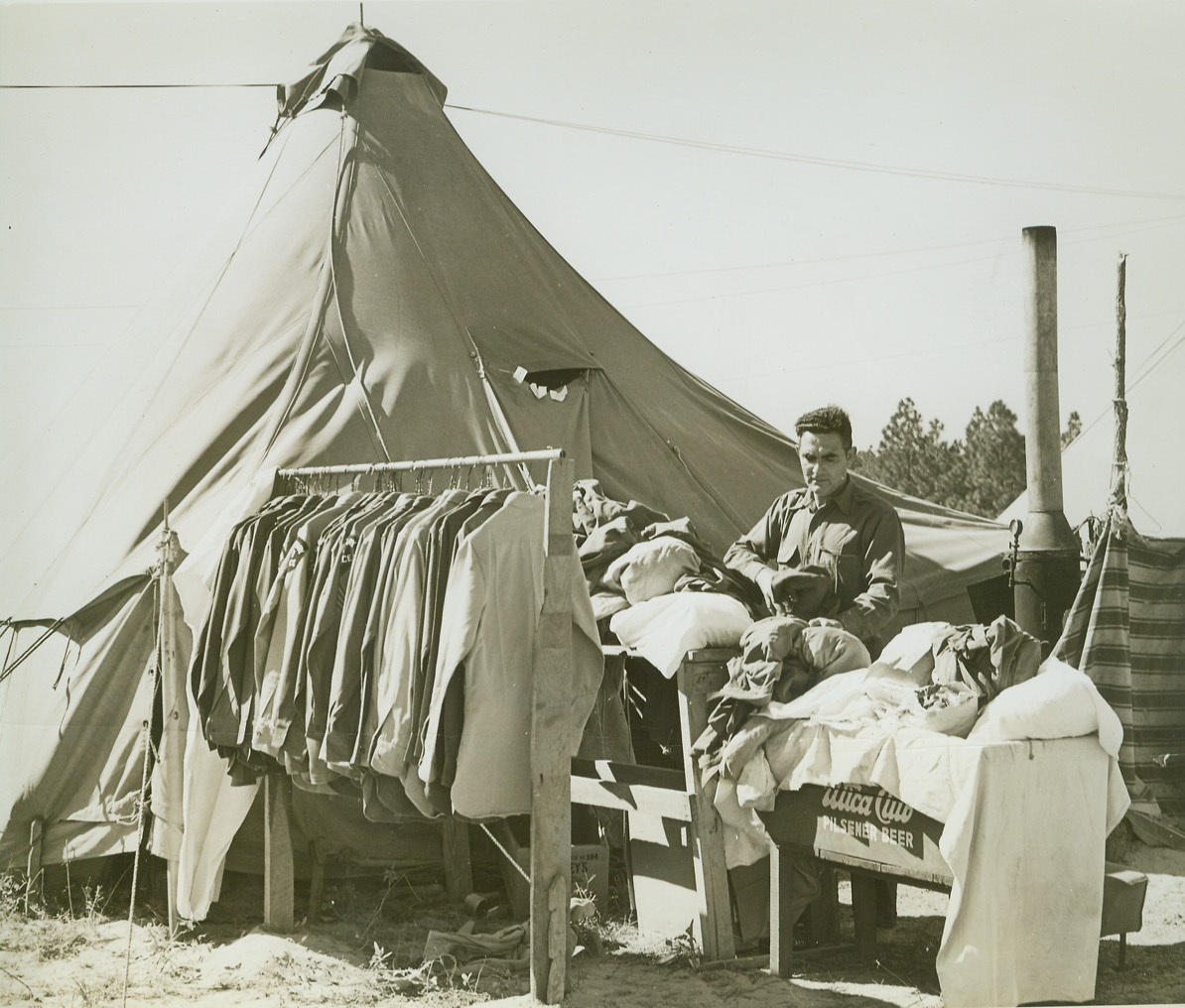
FIELD TAILOR SHOP, 10/26/1942. MANESS, N.C. – Irving Levinson of New York, who has just put out a rack of freshly pressed uniforms for special troops of the 26th Division, goes to work assorting a new batch of laundry and uniforms. A civilian tailor, Levinson’s shop is now a tent in the camp area. In background right is the kerosene fired steam boiler for pressing. Credit: OWI Radiophoto from ACME;
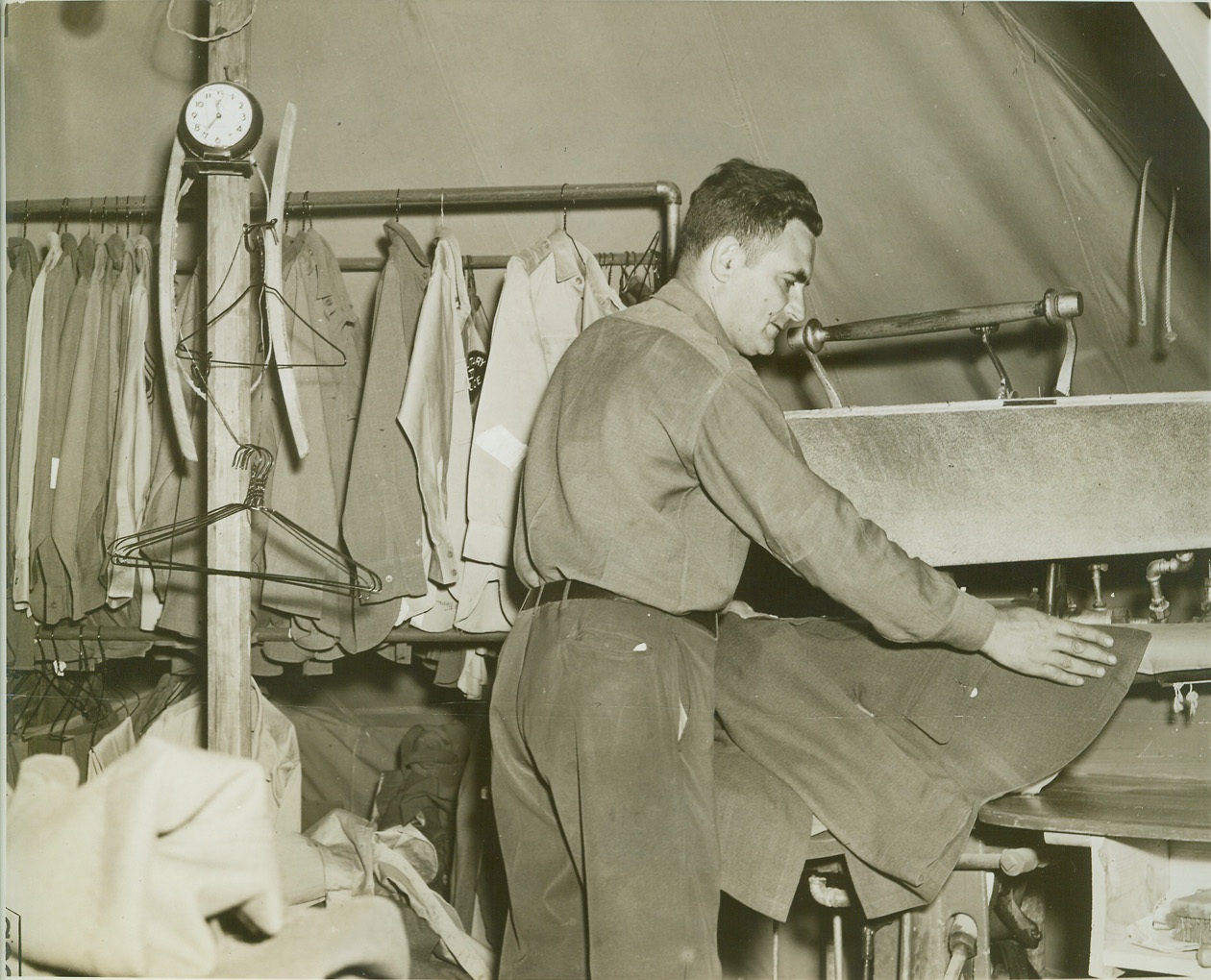
FIELD TAILOR SHOP, 10/26/1942. MANESS, N.C. – Irving Levinson, a tailor by trade, keeps in trim caring for special troops of the 26th Division. His new shop is a tent in the camp area. Here, the New Yorker does some pressing. A kerosene fired steam boiler operates the presser. Credit: OWI Radiophoto from ACME;
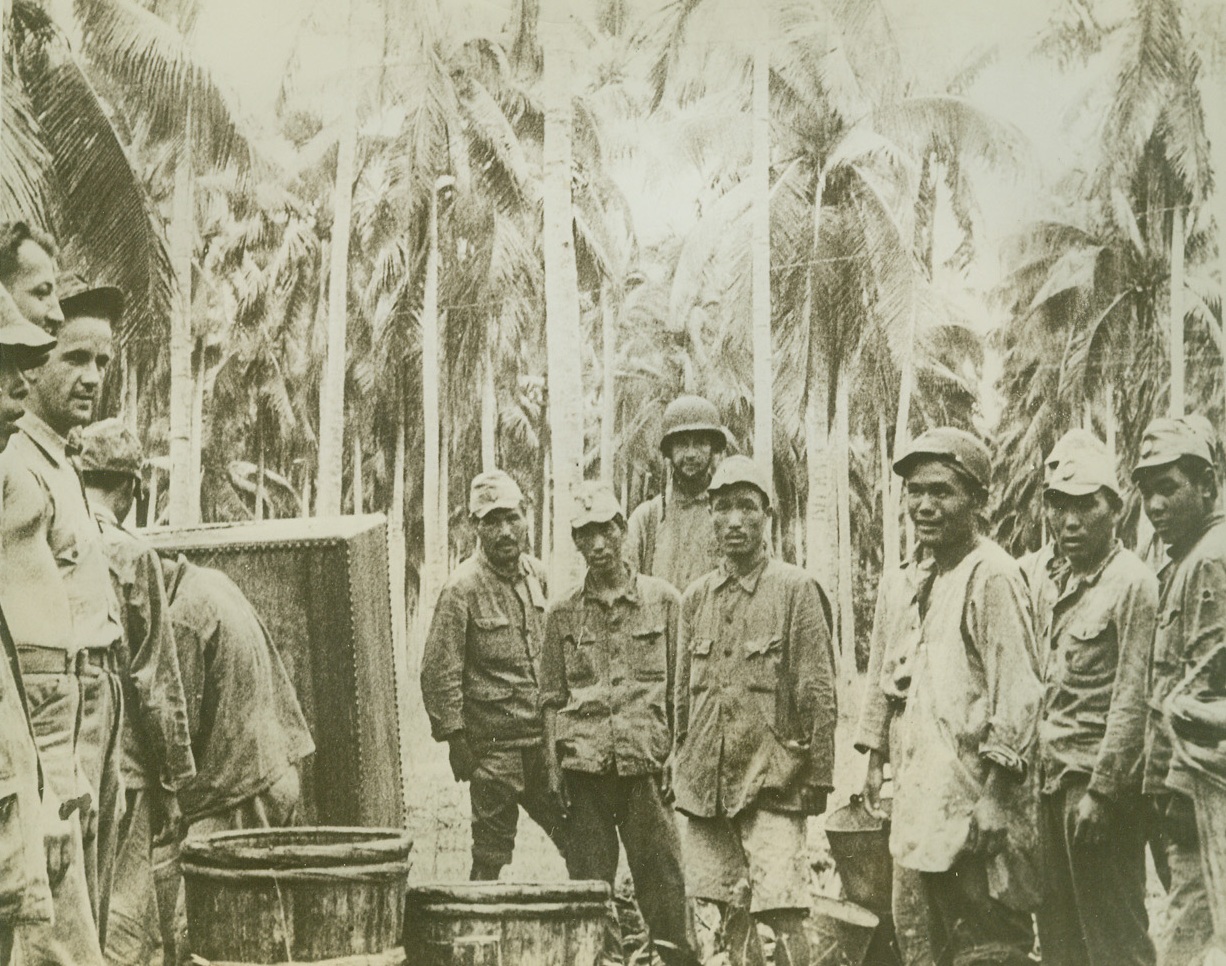
MARINES TAKE JAP PRISONERS AT GUADALCANAL, 10/27/1942. GUADALCANAL, S.I.—Captured after U.S. Marines foiled their attempt to land reinforcements on Guadalcanal, these Japanese prisoners are lined up for examination. They were taken during a heavy enemy invasion attack from the sea. Latest reports a full-fledged battle for control of the strategic island in the Solomon group is now going on. Credit: U.S. Marine Corps photo from Acme;

OFFICERS QUESTIONS JAP PRISONERS, 10/27/1942. GUADALCANAL, S. I.—Leisurely smoking a cigarette, a Jap prisoner answer the questions of four American officers, after a fierce battle on Guadalcanal in which American Marine and Air Corps personnel successfully halted an attempt to land reinforcements. Losses in ships and planes were heavy on both sides. Credit: U.S. Marine Corps photo from Acme;
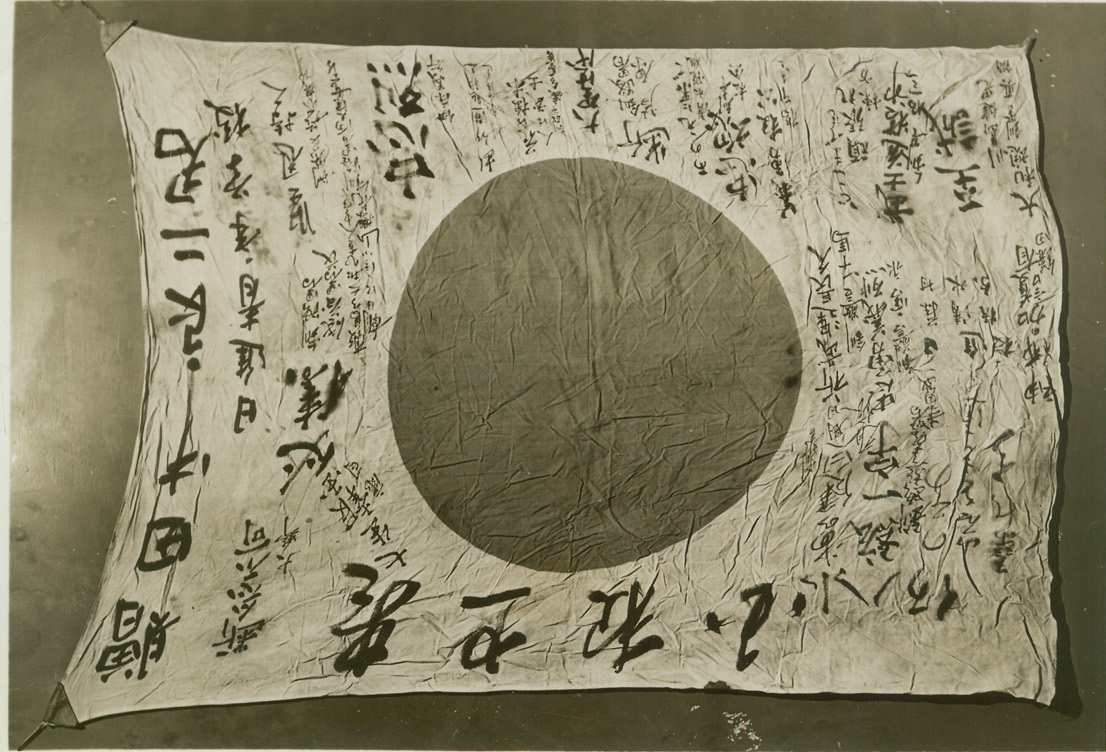
Jap Battle Flag Taken by U.S. Correspondent, 10/27/1942. NEW YORK CITY – Prize trophy from Guadalcanal of United Press Correspondent Robert C. Miller is this slogan-covered Jap battle flag which the newsman took from a Jap officer (presumably a colonel) slain in the Battle of Tenaru River on August 21st. Miller, who landed with the first wave of U.S. Marines at Guadalcanal and remained there for the first 6 weeks of occupation, got the permission of the Marines’ intelligence department to send the flag to New York to be used to raise funds for the war effort. Large inscription nearest staff side of the flag reads: “Presented to Tanak Rejoji, Our Buddy.” Next large line from the staff reads: “ Japanese Progressive School for Young Men.” Other legends read: “Heads Up,” “Be Courageous,” “Fight to the Finish,” “Bravery is Patriotism,” “With Great Courage,” “Cherry Tree for Flower, Man for Warrior,” and “Bushido.” Credit: (ACME);

The Last of the Wasp, 10/28/1942. Southwest Pacific – Settling by the bow and listing heavily to the starboard side where three Jap torpedoes struck just forward of the “island”. The USS Wasp is pictured in her death throes from the deck of an accompanying warship. Since the water system was wrecked by the explosions, the fire could not be checked.Credit (Official US Navy photo from ACME);
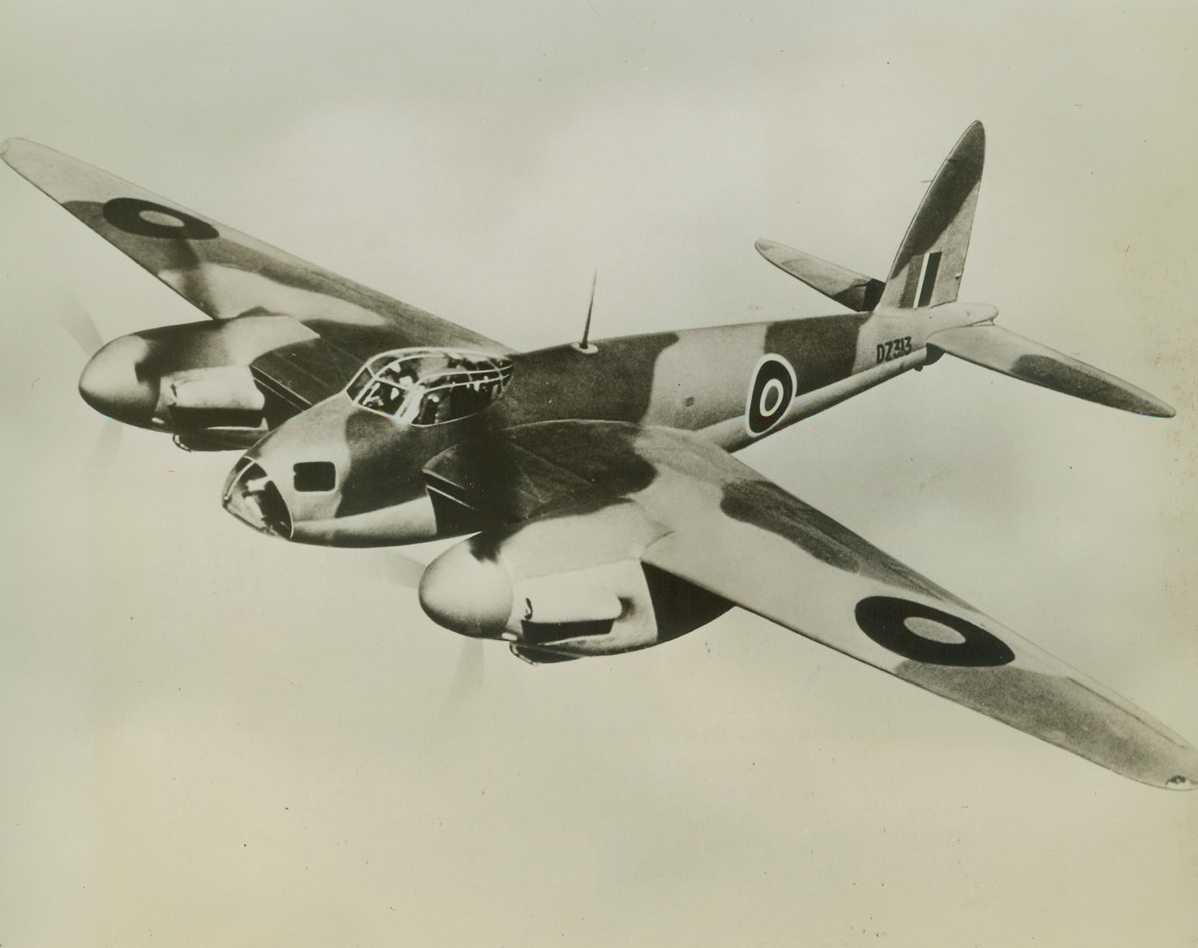
FIRST PHOTO OF NEW BRITISH “MOSQUITO”, 10/29/1942. This is the first photo to be released of the sensational new British de Havilland “Mosquito” reconnaissance bomber, which has done excellent work in recent raids over enemy territory, including France and parts of Germany. It is of simple wooden construction, is powered by two Rolls Royce engines and is armed with four 20mm cannon and four .303 machine guns. It is credited with high speed and long range. Credit Line (ACME);
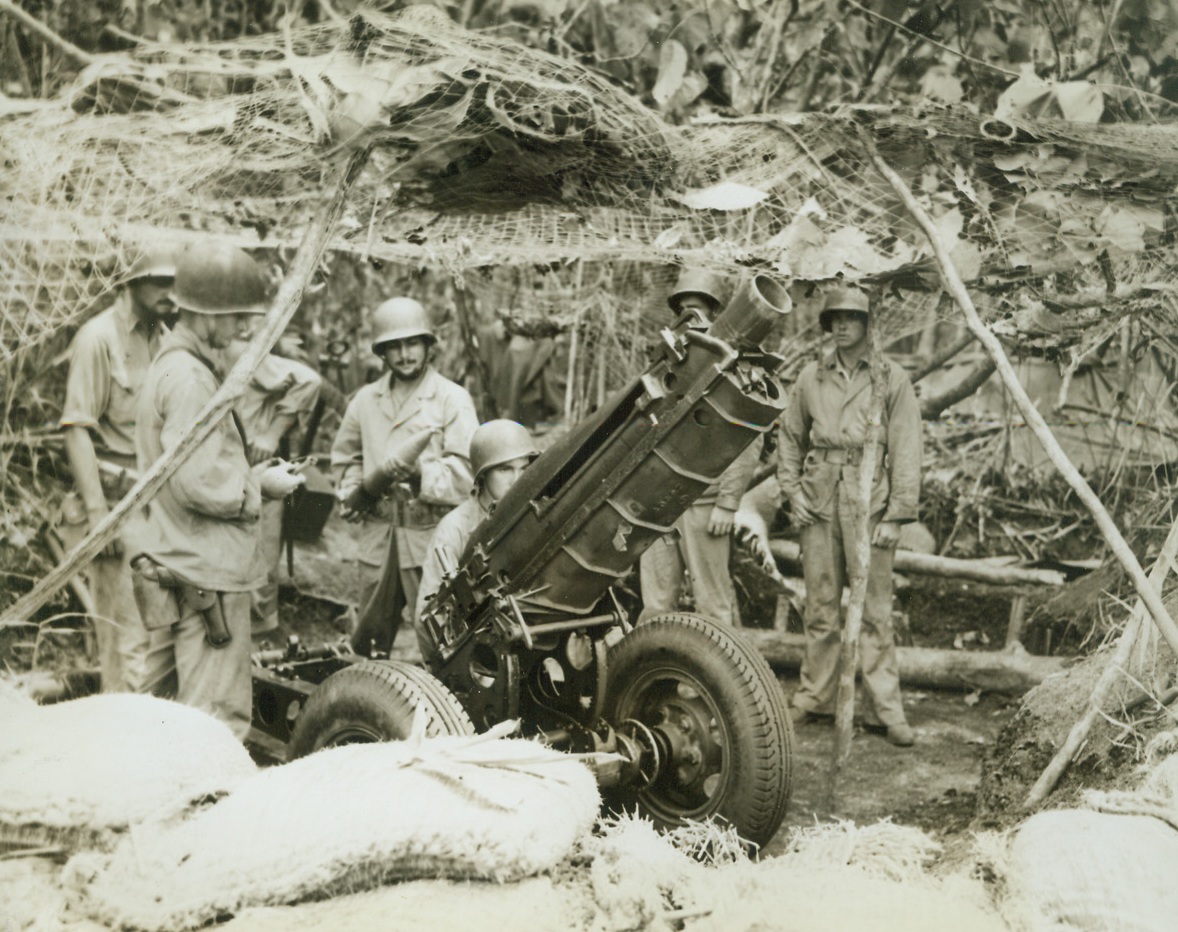
TROPICAL CAMOUFLAGE, 10/29/1942. GUADALCANAL—Under a camouflage to match the tropical setting, this crew mans a 75mm gun, one of the many that pour shells at the Japs that still remain on the island. Credit Line (ACME);
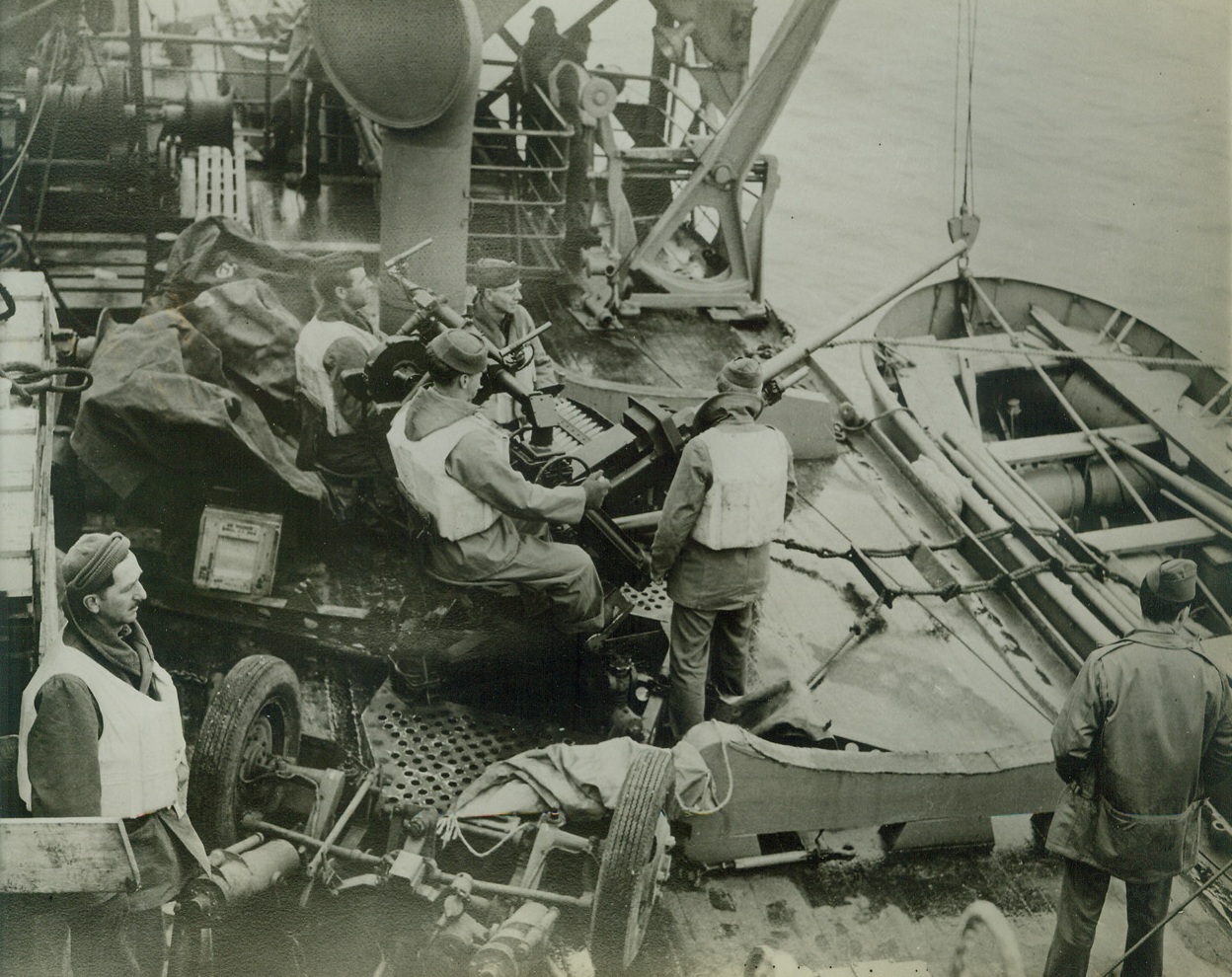
AMERICAN TROOPS LAND IN THE ALEUTIAN ISLANDS, 10/3/1942. WASHINGTON, D.C.—United States Army troops with Navy support have occupied the Andreanof Island group in the Aleutians, only 125 miles east of the Jap held Kiska it was announced by the Navy. Photo shows: a troop transport nears the landing beach while the gun crew aboard keeps a sharp lookout for enemy planes. Credit: U.S. Signal Corps photo from Acme;
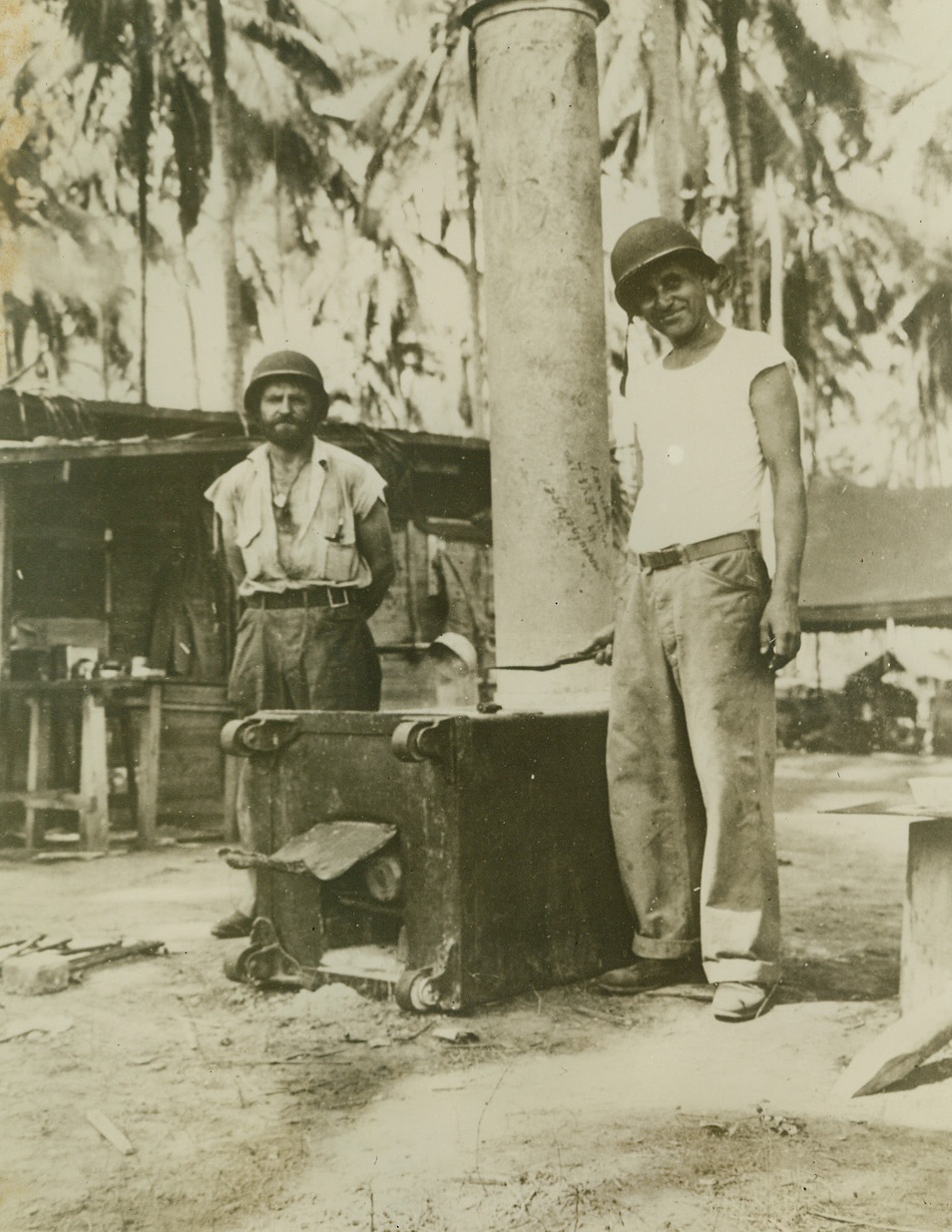
FLAPJACKS A LA GUADALCANAL, 10/30/1942. GUADALCANAL—Converting a captured safe into a stove, U.S. Marine chefs prepare a batch of pancakes, “Guadalcanal style,” for their hungry colleagues. This photo was made before Jap offensive to regain control of strategic areas taken by American forces in August. Credit Line (Marine Corps Photo from ACME);
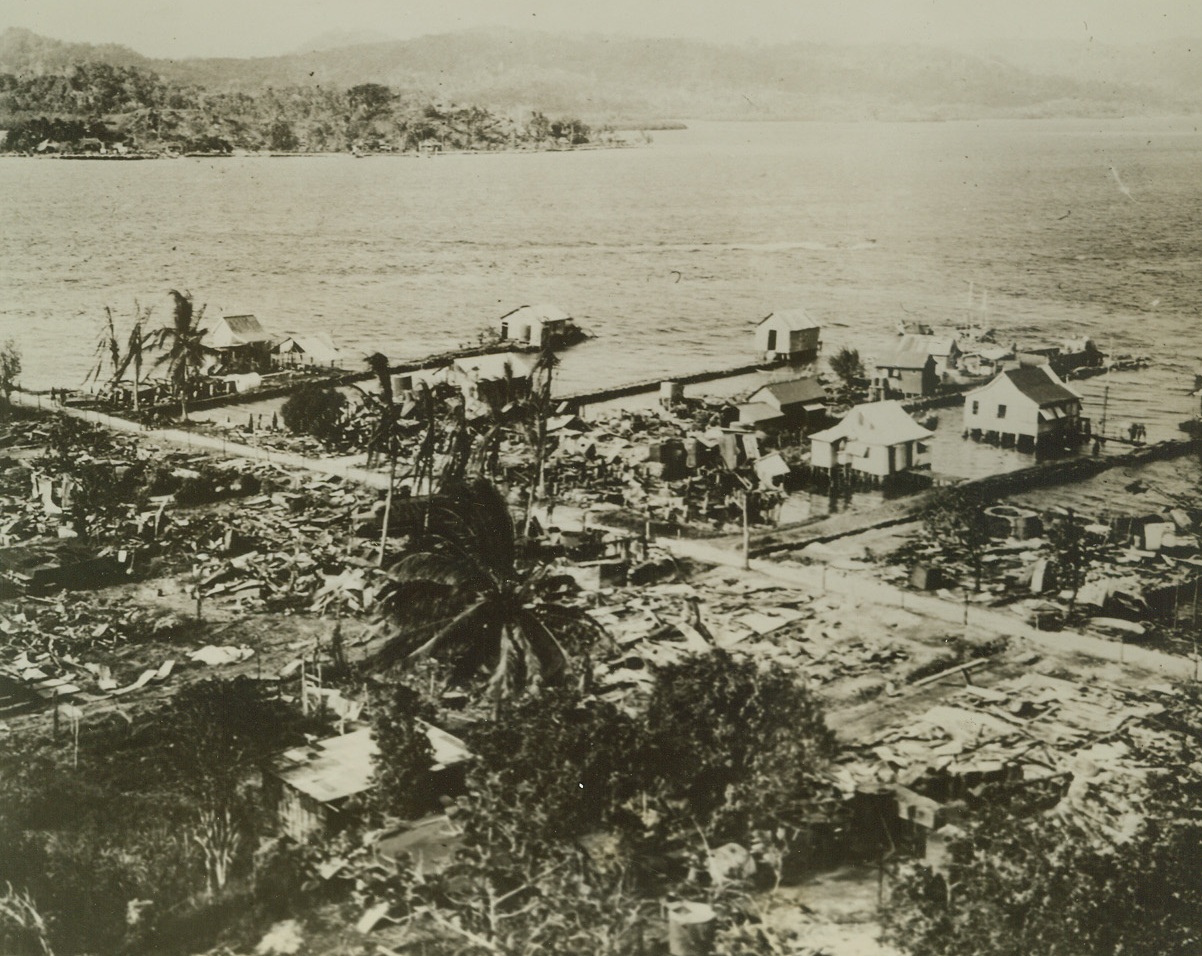
WAR-TORN TULAGI, 10/30/1942. SOLOMON ISLANDS—Bombed and shell-swept, this is the shoreline of Tulagi Island, tiny but strategic member of the Solomon group, where the Jap Navy has deserted after an unsuccessful attempt to dislodge American forces. This photo show damage inflicted by U.S. warbirds before Marines occupied the island during the forepart of the campaign. Credit (Marine Corps Photo from ACME);
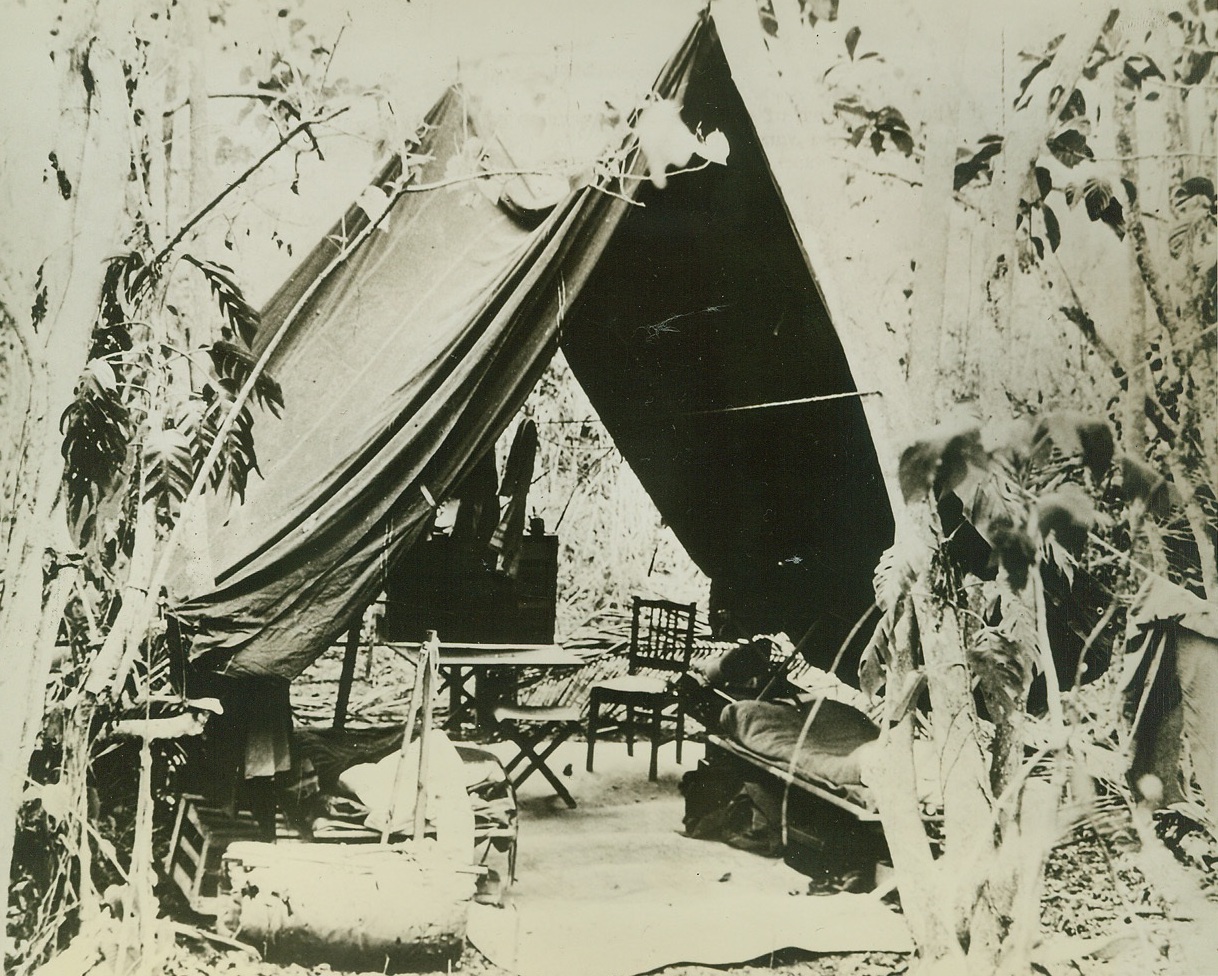
Home of General Vandegrift, 10/30/1942. GUADALCANAL -- Stripped of all but bare necessities, this tent is the Guadalcanal home of Maj. Gen. A.A. Vandegrift, Commander of all U.S. Marine forces in the Solomons, where the Jap Navy has decided to call it quits for the present. Credit: (ACME) (Marine Corps Photo from ACME);
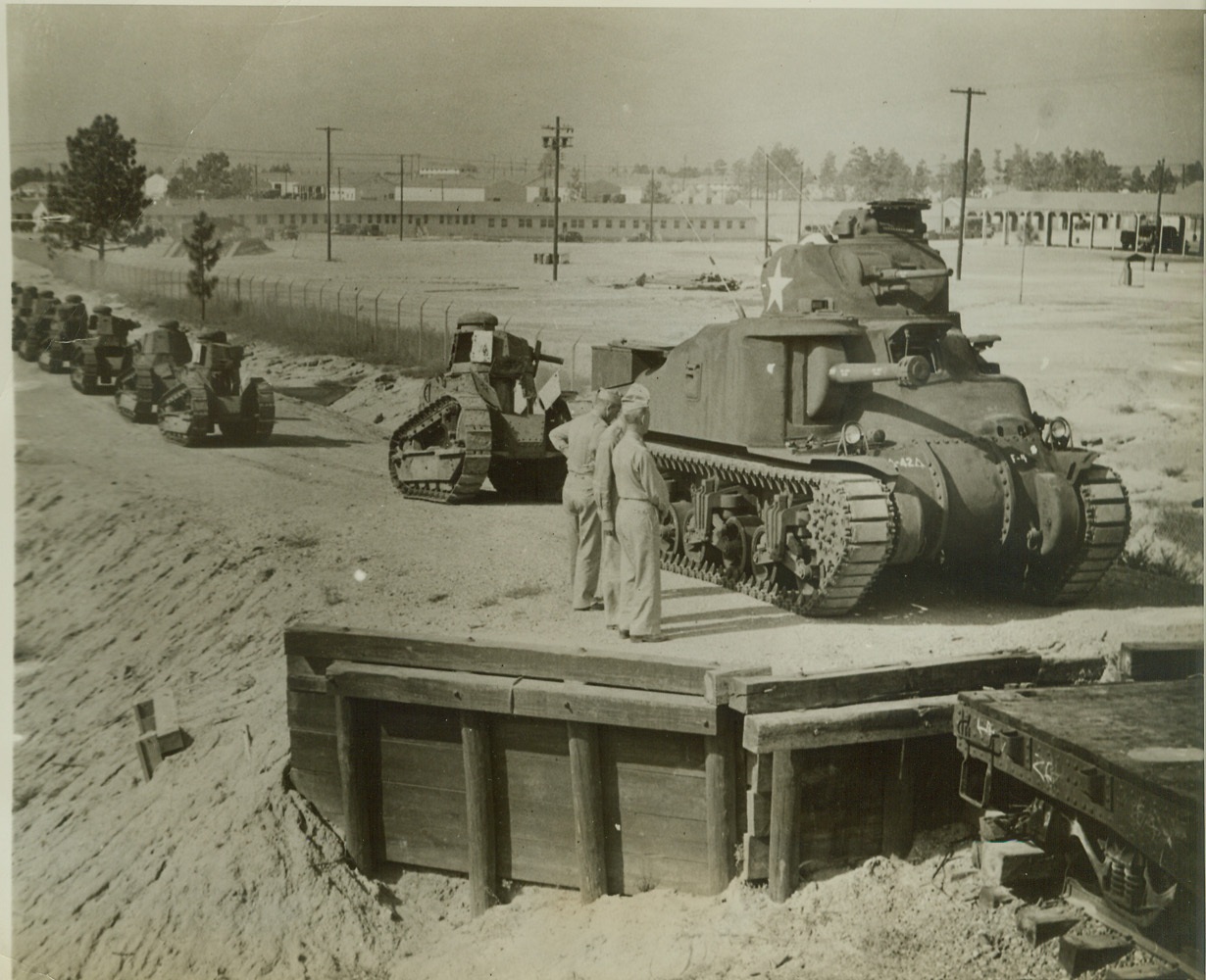
First World War Tanks Go to Scrap Heap, 10/5/1942. CAMP POLK, LA. – Like a mother caterpillar leading her youngsters, this modern medium American Armored Force tank starts Renault tanks of World War I on their trip to the blast furnace, where they will be converted into more modern war materials. The tanks were salvaged at Camp Polk, home of the 111 Armored Corps. Credit: (ACME);
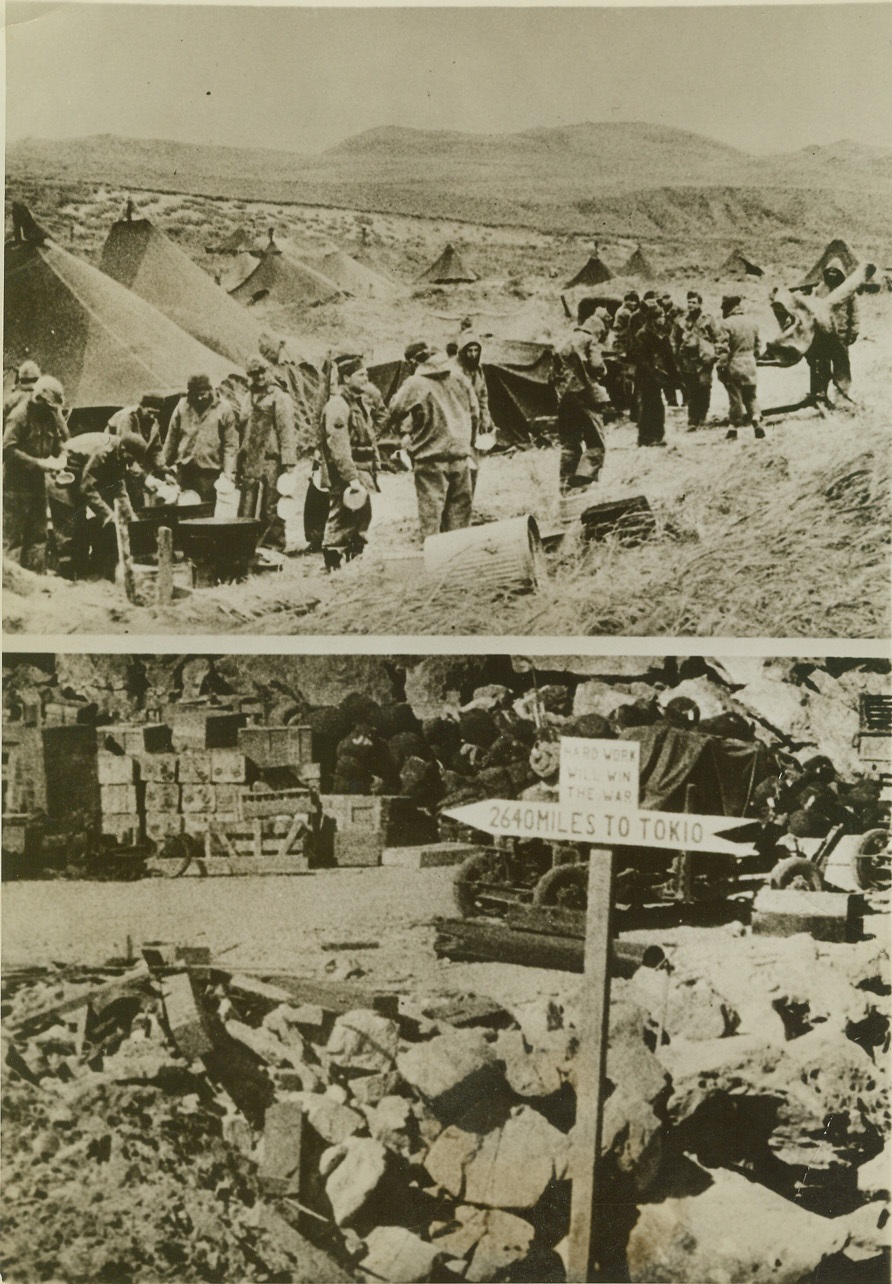
EATING AND PLANNING, 10/6/1942. Troops of the U. S. occupation force that took over an island of the Andreanof group in the Aleutian chain clean their mess kits (top). After a hard-earned meal a signpost shows what’s on the mind of these fighting men (below). From this base Americans can keep the Japanese-occupied Aleutian island of Kiska under almost continuous attack from the air. Credit: U. S. Signal Corps newsreel from ACME;
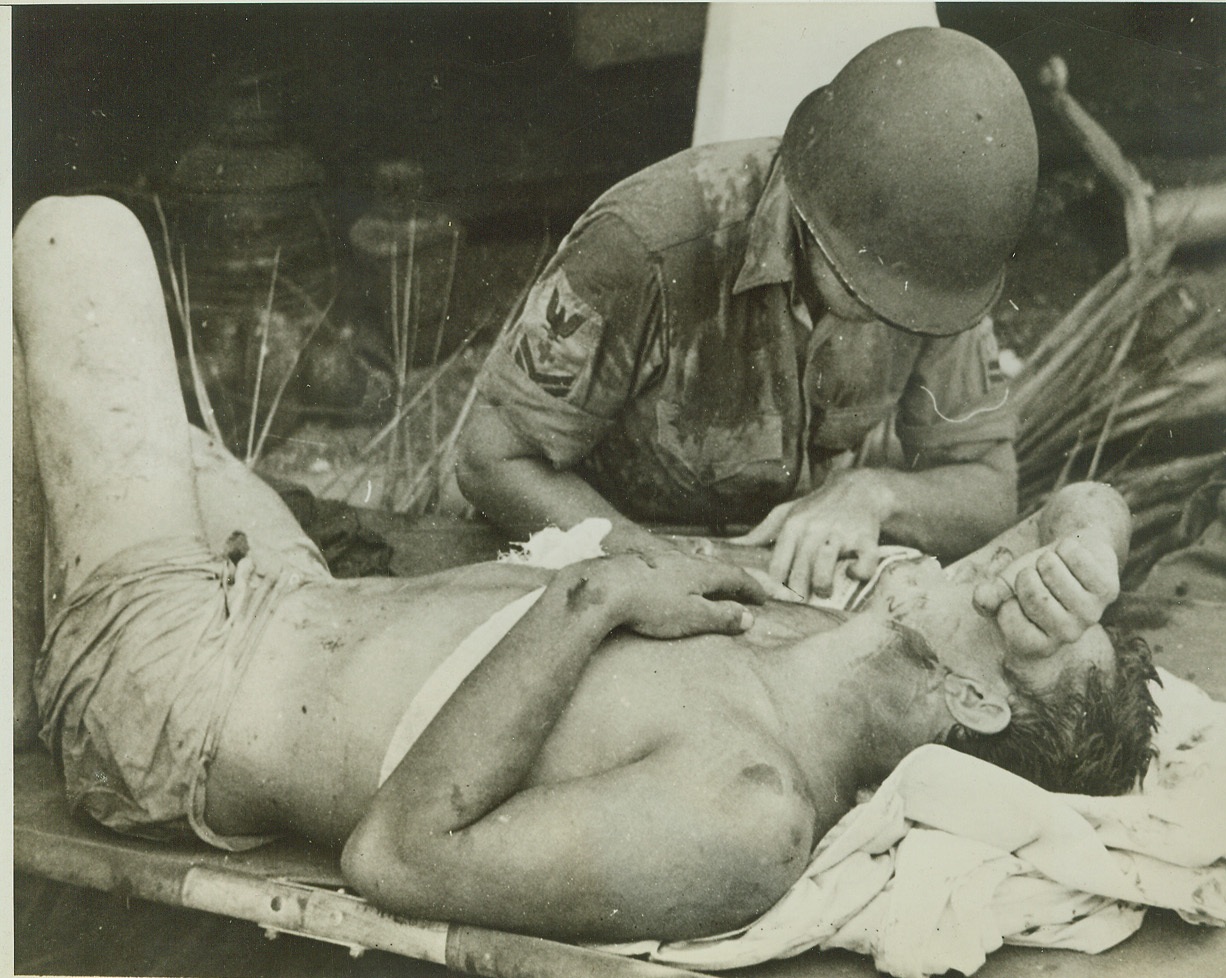
Survivor of U.S.S. Calhoun Gets First Aid, 10/6/1942. A survivor of the U.S. Navy Auxiliary vessel, U.S.S. Calhoun, sunk by Jap bombers early in the fighting in the Solomon Island area, is given first aid at Guadalcanal after his rescue. Credit: (ACME);

Japs Hit U.S. Gasoline Dump, 10/6/1942. A towering pillar of smoke rises from a U.S. Marine gasoline and oil supply dump on Guadalcanal Island in the Solomons, after Japanese bombers had registered direct hits, during early fighting in that area. (Passed by Navy Censors). Credit: ACME;
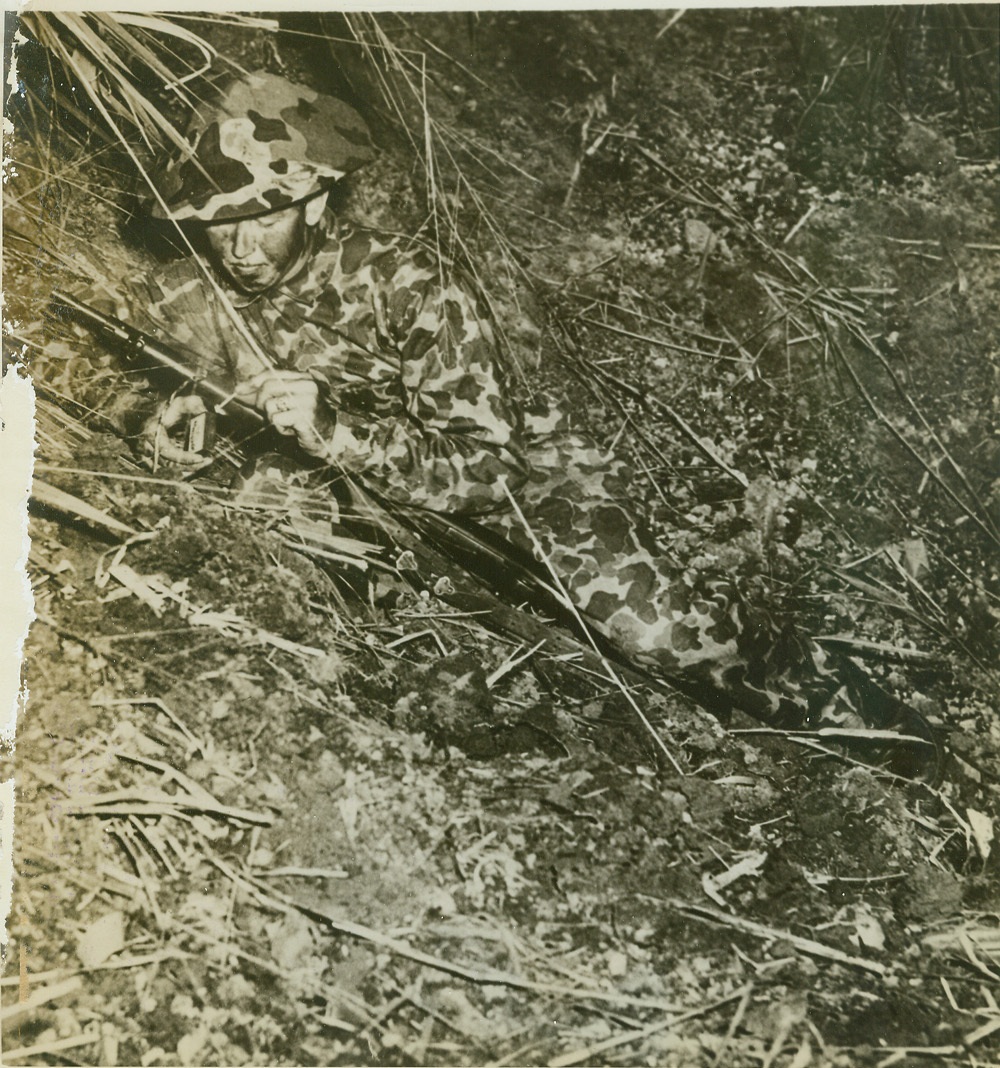
NOW YOU SEE HIM NOW YOU DON’T, 10/7/1942. PANAMA – Cleverly camouflaged to look like part of the Panama terrain, Corp. Jerrold Tucker, of Holland, Michigan, lights a fuse in maneuvers, as fighting U.S. Army engineers show how they would go about demolition work. The charge has been planted by a secret method. Credit: ACME;
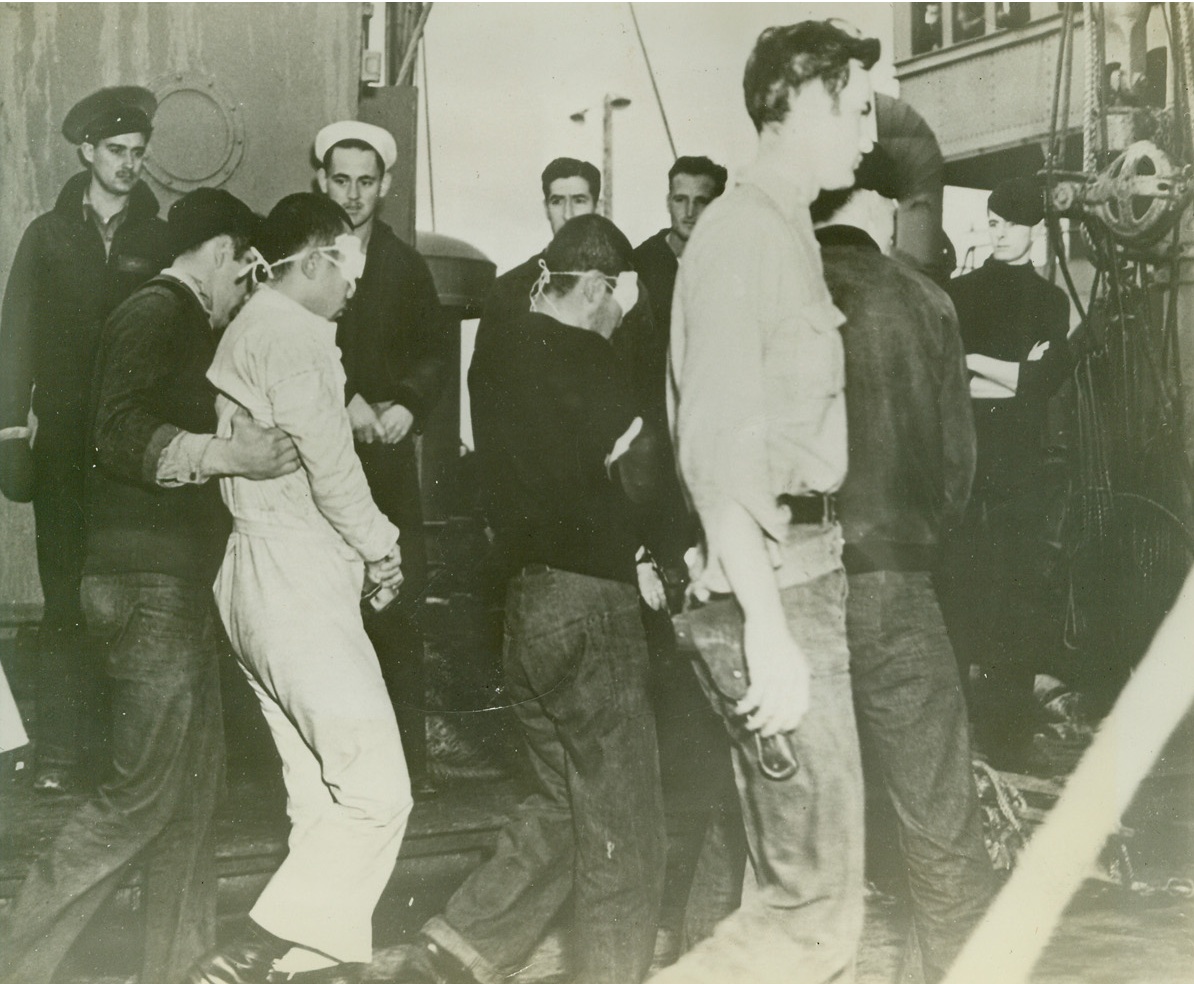
U.S. TAKES JAP PRISONERS IN ALEUTIAN WATERS, 10/7/1942. Blind-folded and heavily guarded, these Japanese arrive at Dutch Harbor, Alaska—but in the role of prisoners rather than fighting men. A naval engagement in Aleutian waters resulted in the capture of these and three other Nipponese. Credit Line (U.S. Navy Official Photo from ACME);
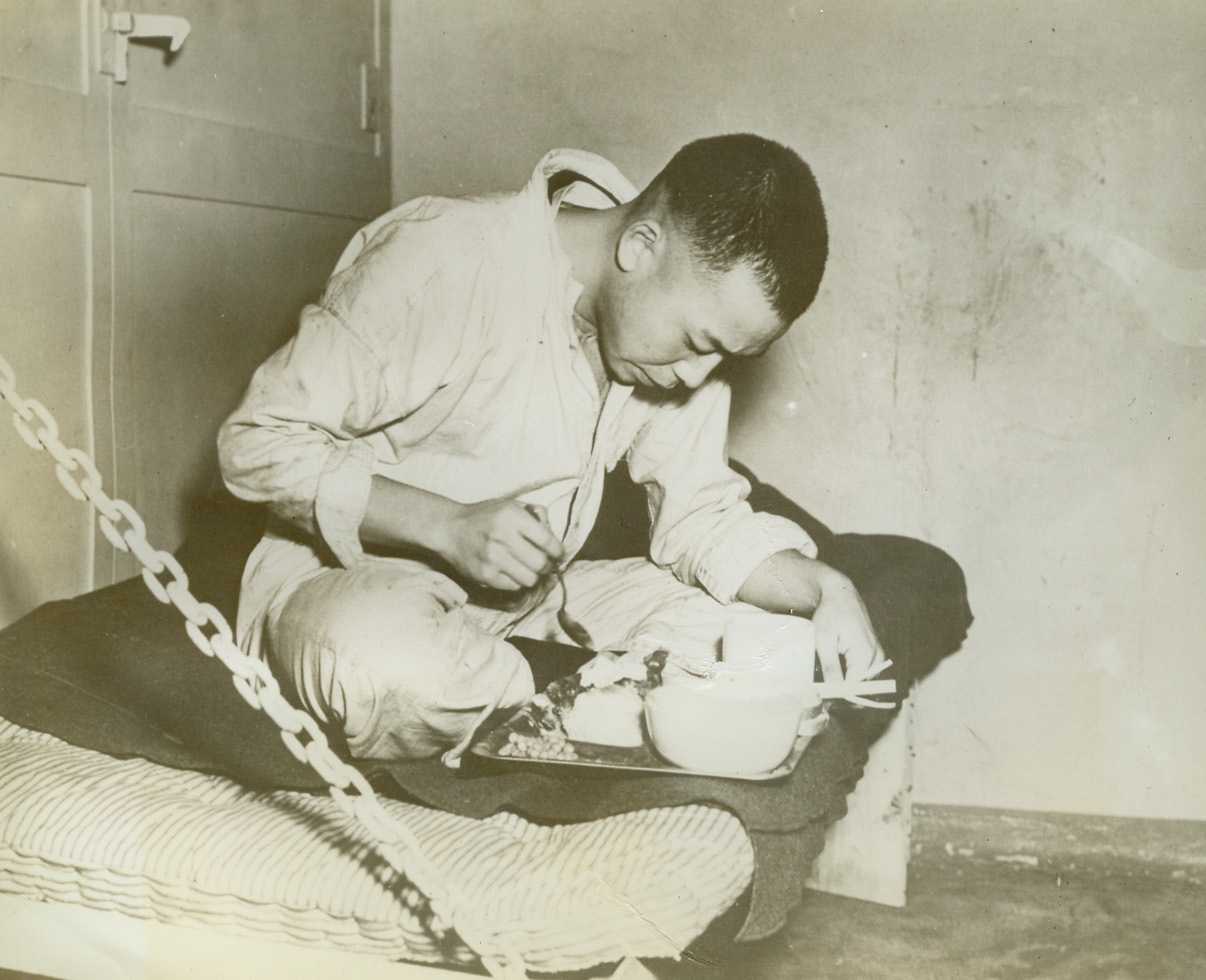
U.S. Takes Jap Prisoners in Aleutian Waters, 10/7/1942. Sitting in the traditional cross-legged fashion on his bunk, this Japanese prisoner wasted little time digging into a well-filled tray of U.S. Navy chow, including bread, potatoes and beans. The prisoner, one of the five taken after a Naval engagement in Aleutian waters, was confined to a ship’s brig pending transfer to shore. Credit: U.S. Navy Official photo from ACME;
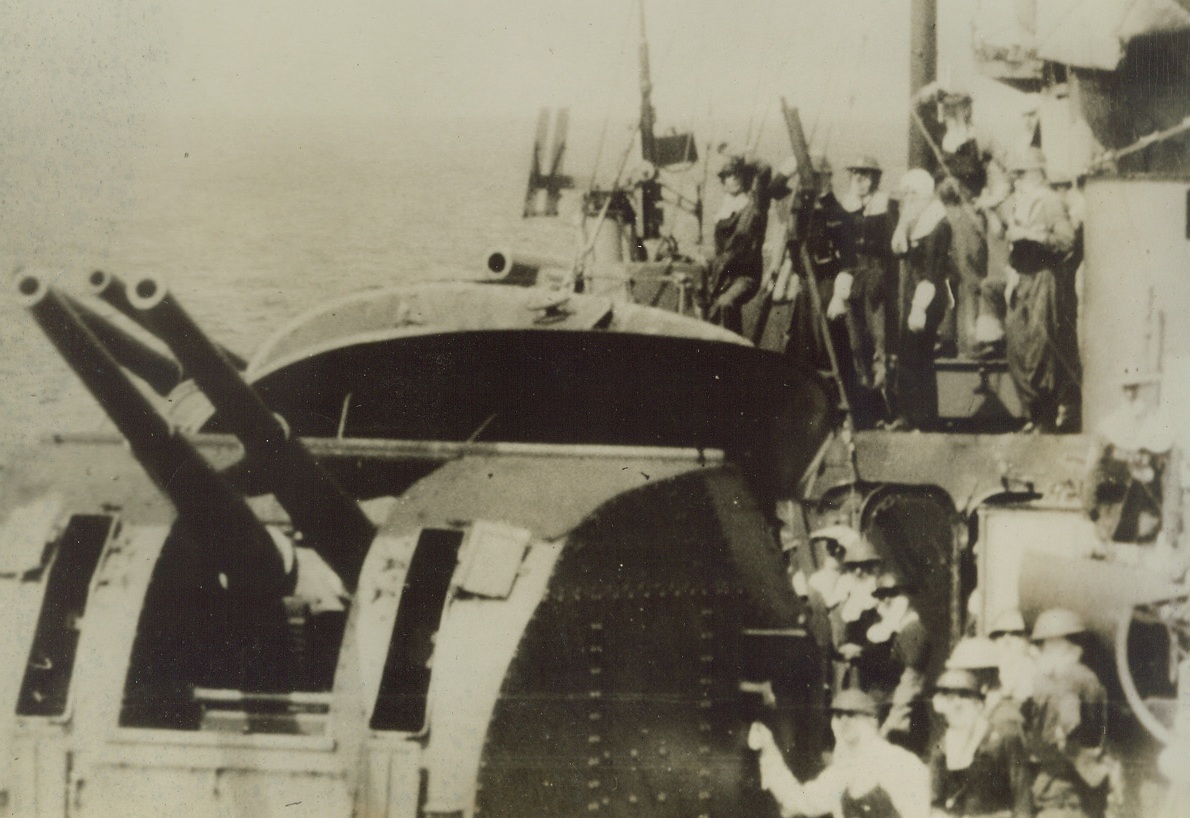
Ready for Jap Bomb Attack, 10/7/1942. Solomon Islands – A gun crew on an American cruiser stand by their weapon as the crew gets ready for a Jap high-level bombing attack during the fighting in the Solomon Islands. Passed by Censors. Credit: ACME;
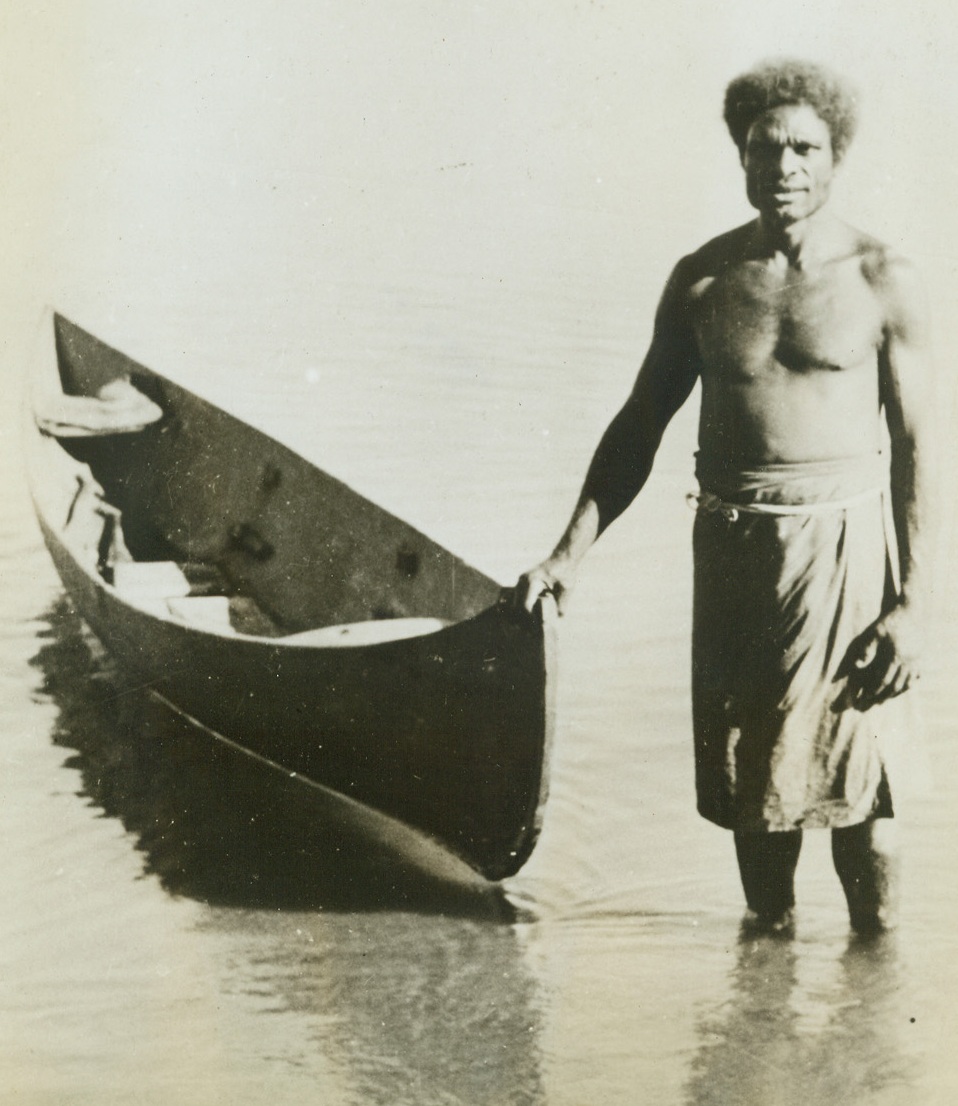
Solomon Island Hero, 10/8/1942. Guadalcanal, Solomon Islands – Sergeant Major Vootha of the Native Police, who was captured recently by the Japs at Guadalcanal and tortured with a bayonet when he refused to give any information about the Americans there. Left for dead, Vootha escaped and returned to a U.S. Marine camp with valuable information. This photo was taken before his capture. Credit: U.S. Marine photo from ACME;

ADMIRAL CHANGES SHIP IN MID-STREAM, 10/9/1942. Rear Admiral R. L. Burnett, commander of the escorting forces convoying the largest Allied merchant fleet to a Russian arctic port, is seated in a slung chair as he transfers from the cruiser flagship H. M. S. Scylla to a destroyer following a four-day torpedo plane and U-Boat attack by Axis forces. The cruiser was used to accommodate survivors of sunken ships. Admiral Burnett saw the convoy to Russia from the destroyer. (Passed by censors.) Credit: ACME;
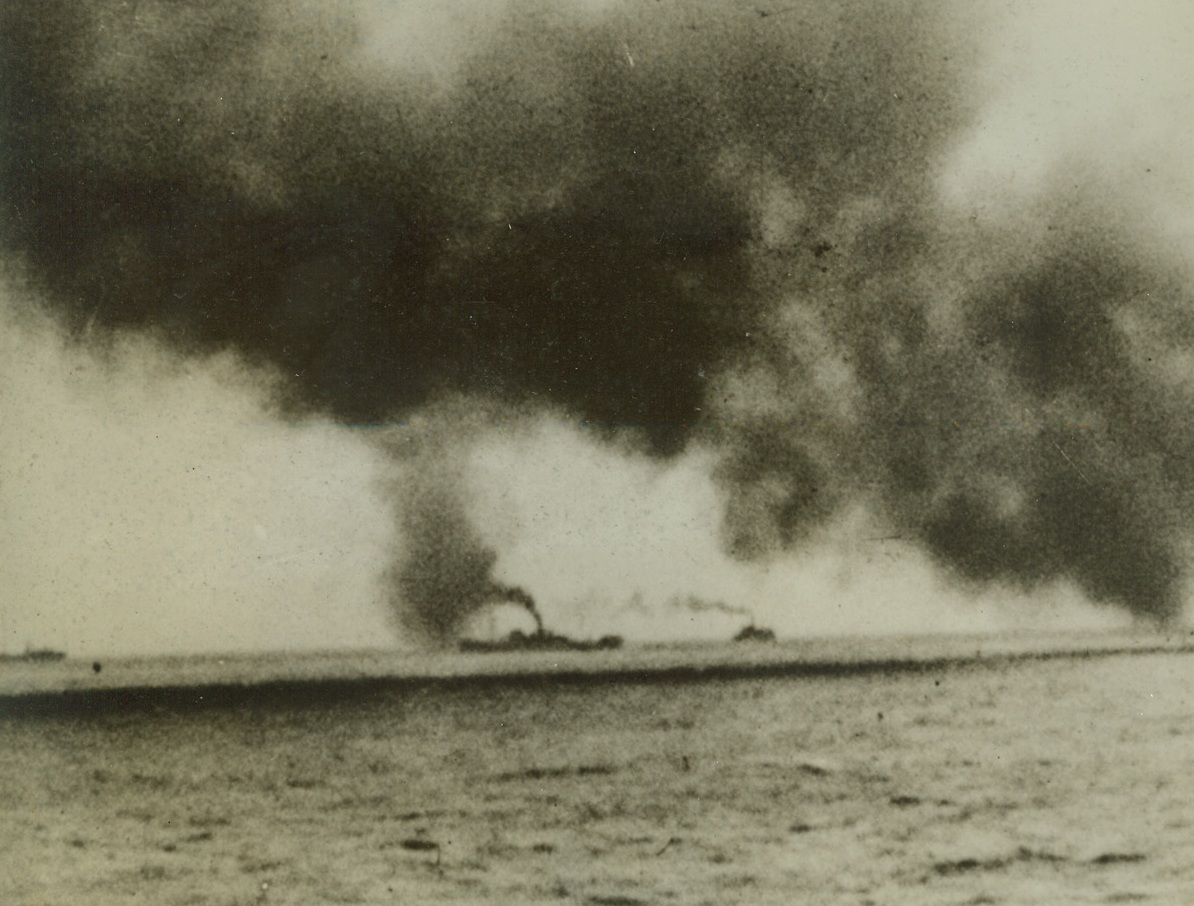
CONVOY WEATHERS NAZI ATTACK, 10/9/1942. Merchant ships, drifting along under cover of a smoke screen, manage to complete their voyage to Russia despite four days of constant attack by Nazi torpedo planes and U-boats. The biggest Allied convoy to make the trip to an Arctic port suffered losses but managed to get the greater number of ships safely through. Credit: Acme;
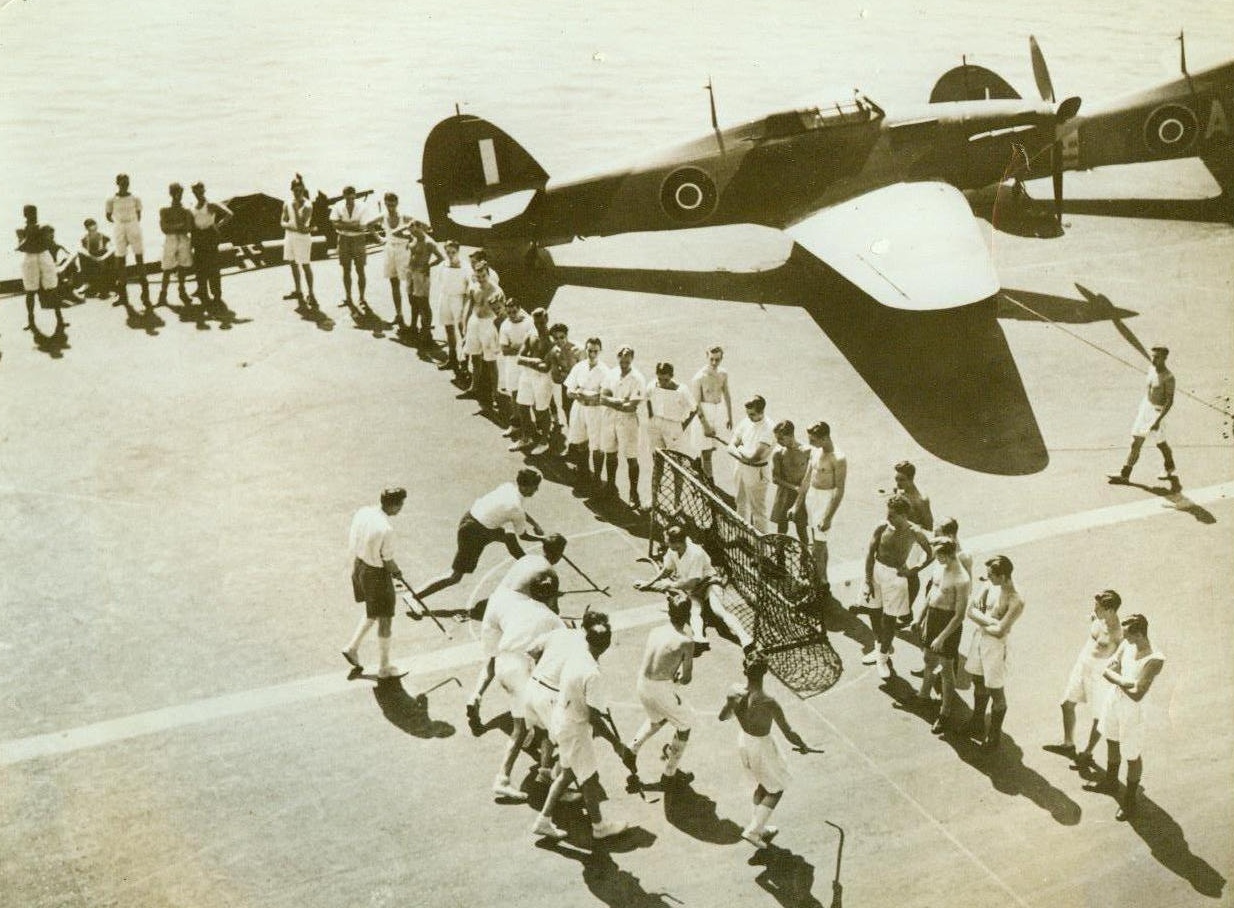
Mediterranean Sea Hockey Match, 10/23/1942. Somewhere in the Mediterranean – Hurricanes stand ready for action in the rear, while a hockey game is in full progress forward, on the deck of a British Aircraft Carrier somewhere in the Mediterranean. An interested audience watches the flight deck match, and aerial and sea warfare seems far away, instead of just around the next cloud or wave 10/23/42 Credit Line (ACME);
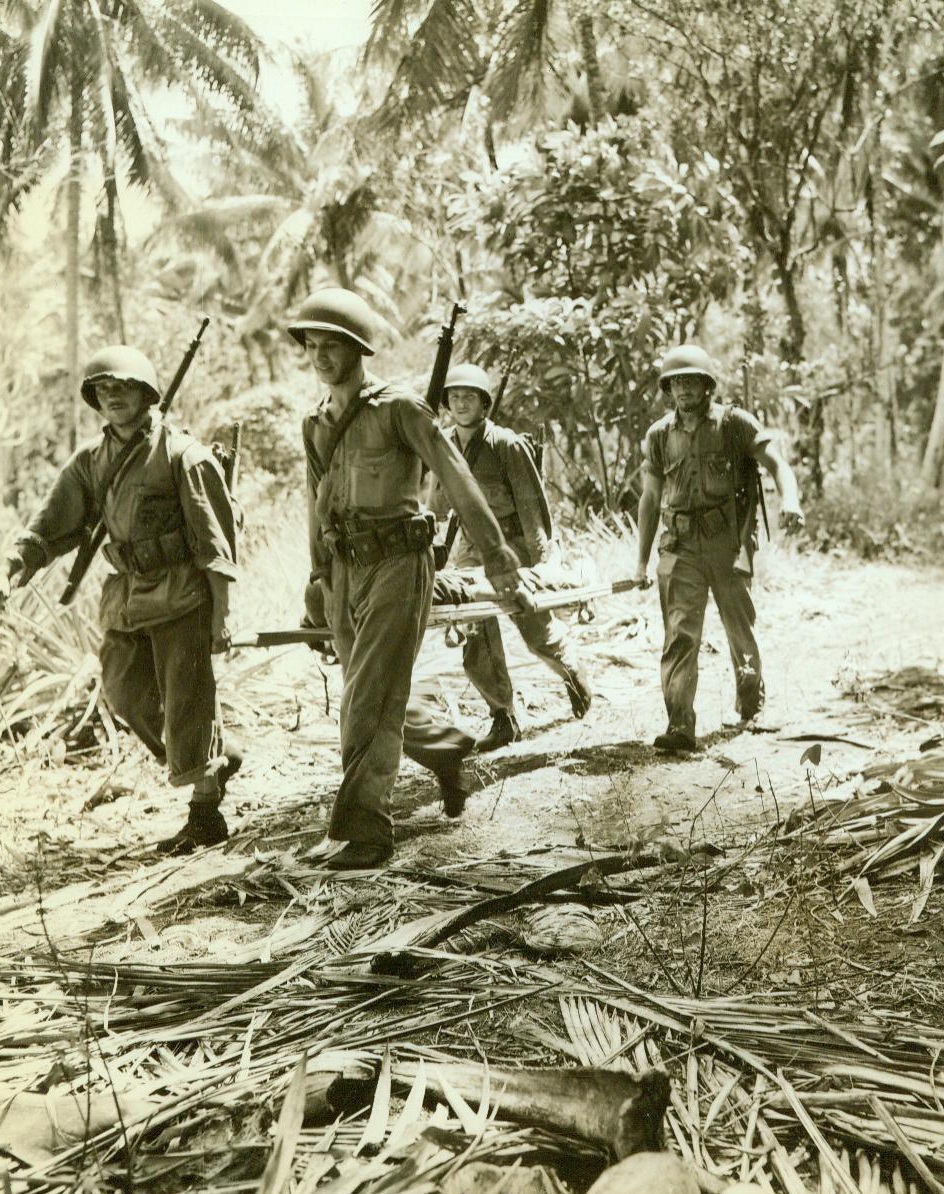
Unsung Heroes of Solomons, 10/29/1942. Guadalcanal – U.S. Navy Pharmacist Mates attached to the Marines as “Corpsmen”, act as stretcher bearers and give first aid to the sick and wounded while frequently under fire and in the midst of bombings. This crew is bringing in a wounded Marine through sweltering jungle heat and rain less than 100 yards behind front lines during an engagement between the Marines and an entrenched Jap patrol. 10/29/42 Credit Line (ACME);
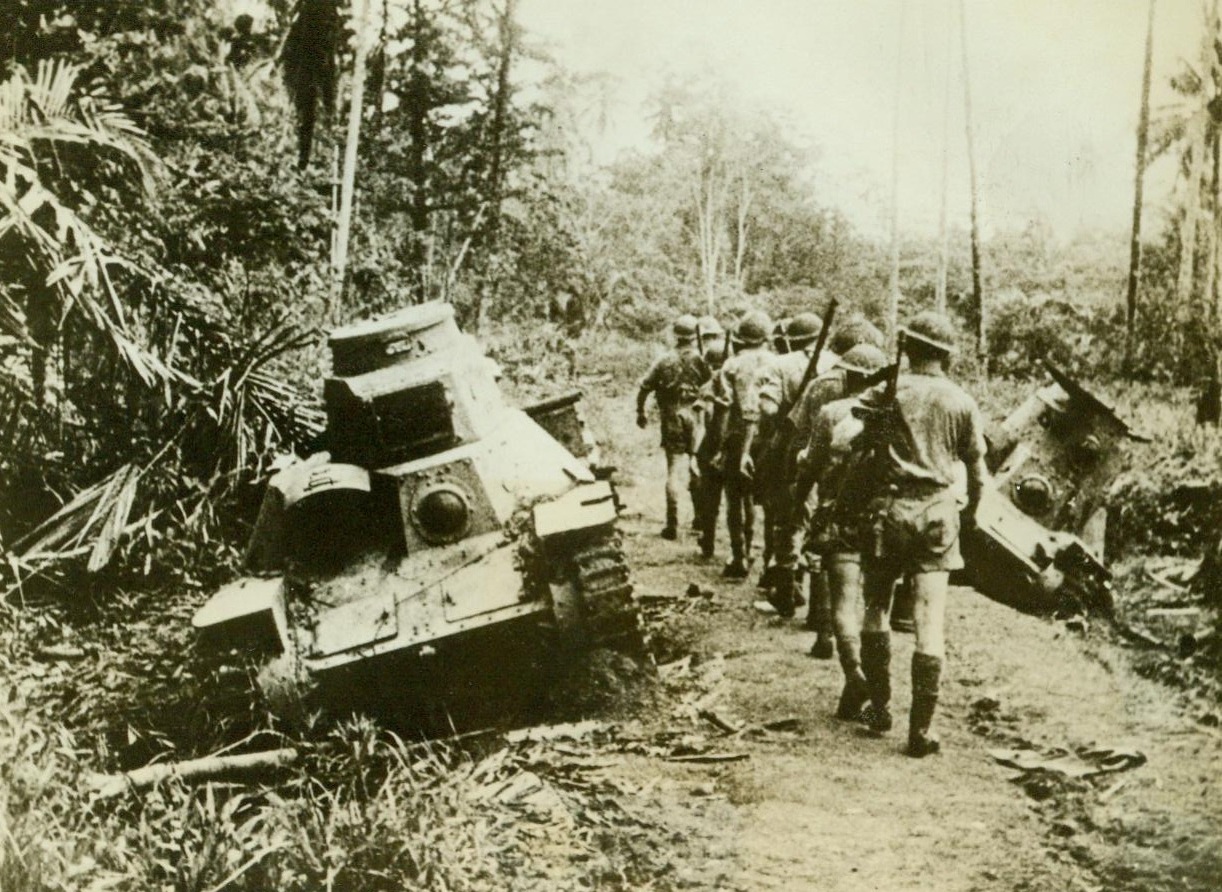
Left On The Roadside, 10/30/1942. Australia – Deserted when they were put out of commission during an unsuccessful Jap attack on Milne Bay, these Jap tanks lean dejectedly to the side of the road. Australian soldiers filing past them should smile with pride for they delivered a hard blow to the Nips in that battle 10/30/42 Credit Line (ACME);
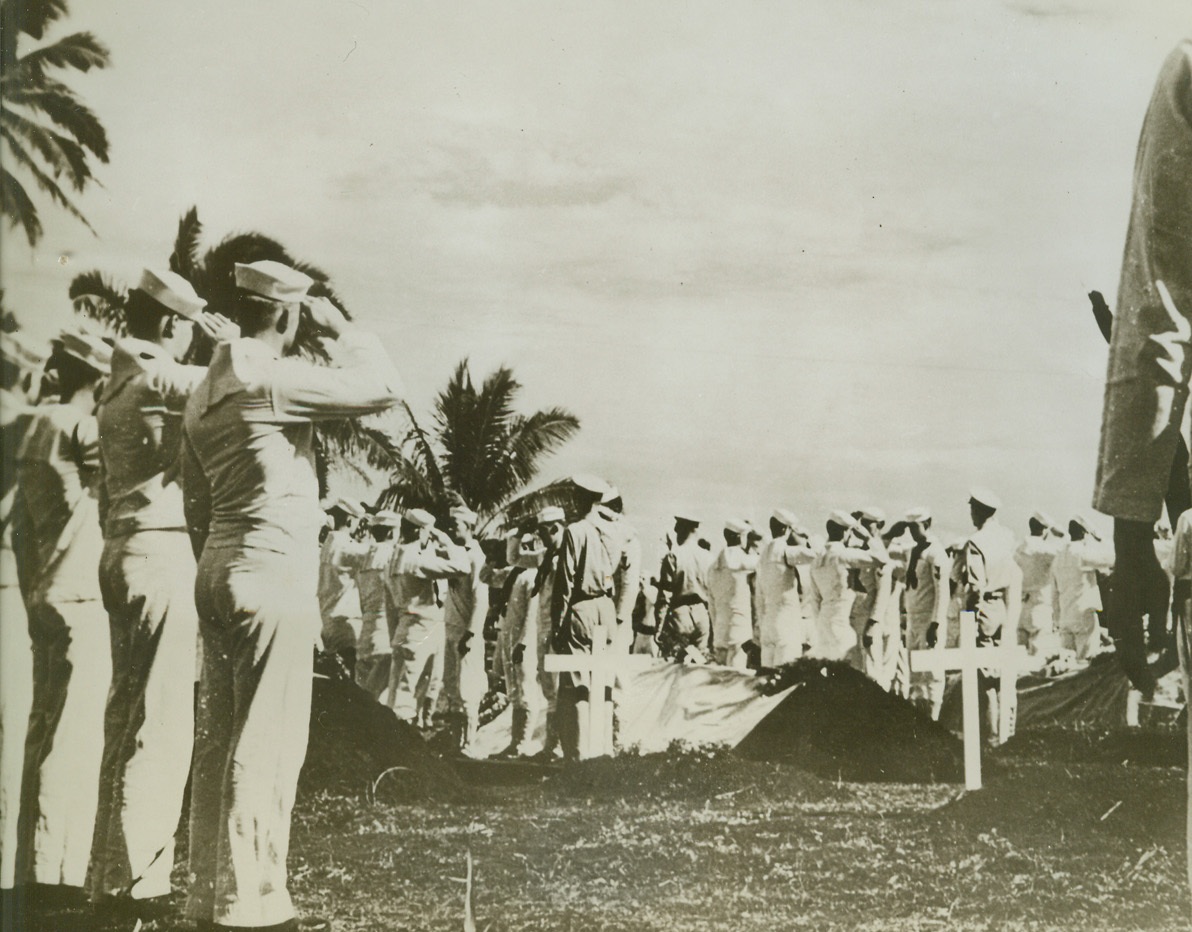
ISLAND BURIAL FOR NAVY DEAD, 10/16/1942. United States sailors salute as four of their shipmates, killed during naval engagement in the Solomon Islands area, are laid to rest on a colorful tropic island somewhere in the South Pacific.Credit: OFFICIAL U.S. NAVY PHOTO FROM ACME.;
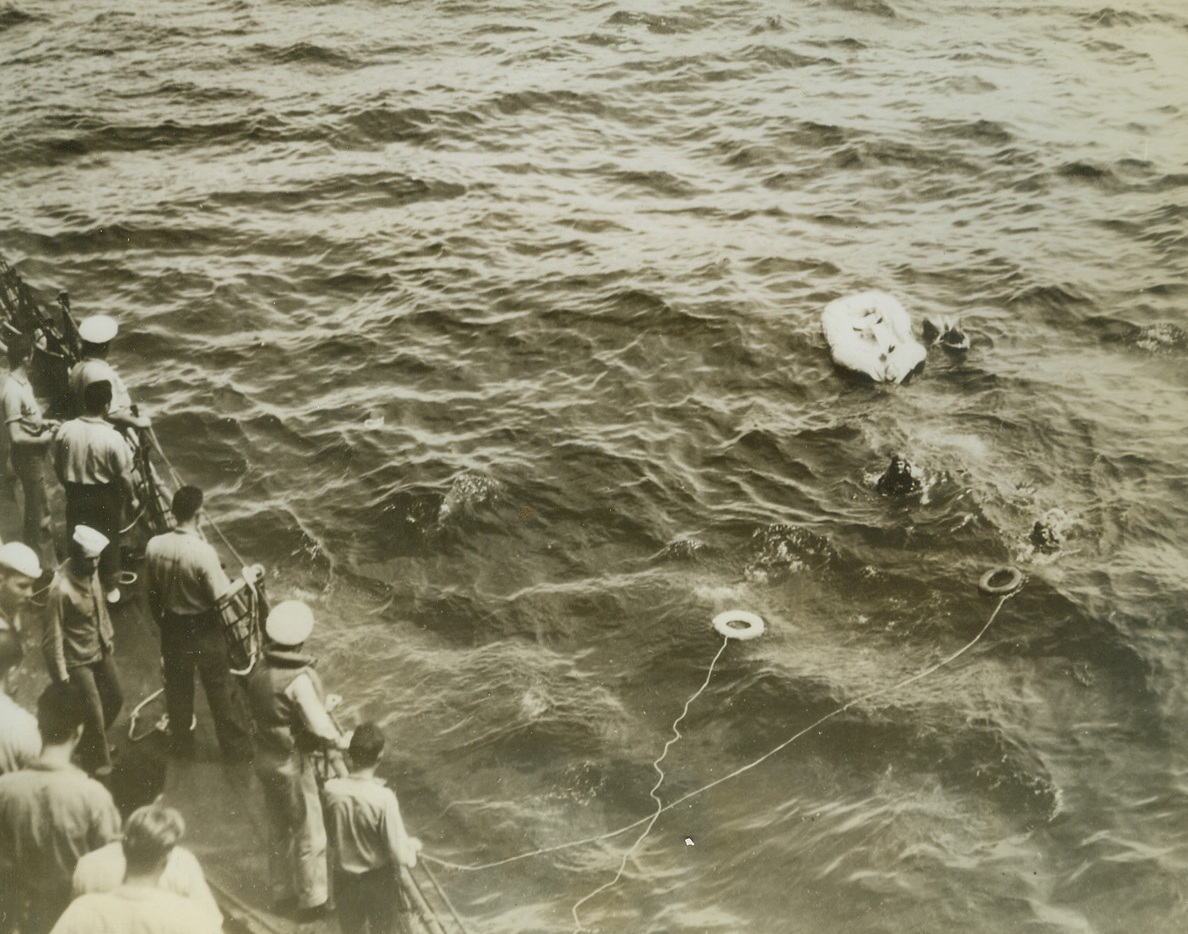
SAVED AFTER JAPANESE ATTACK, 10/23/1942. Three U.S. airmen, their plane shot down in the Solomon Islands area by Japanese, took to their rubber “doughnut” until rescued by the ship at left. The man at the extreme right is just reaching for the life preserver, while another treads water and the third appears to be hanging onto a piece of equipment by the rubber boat. Credit: U.S. NAVY PHOTO FROM ACME.;
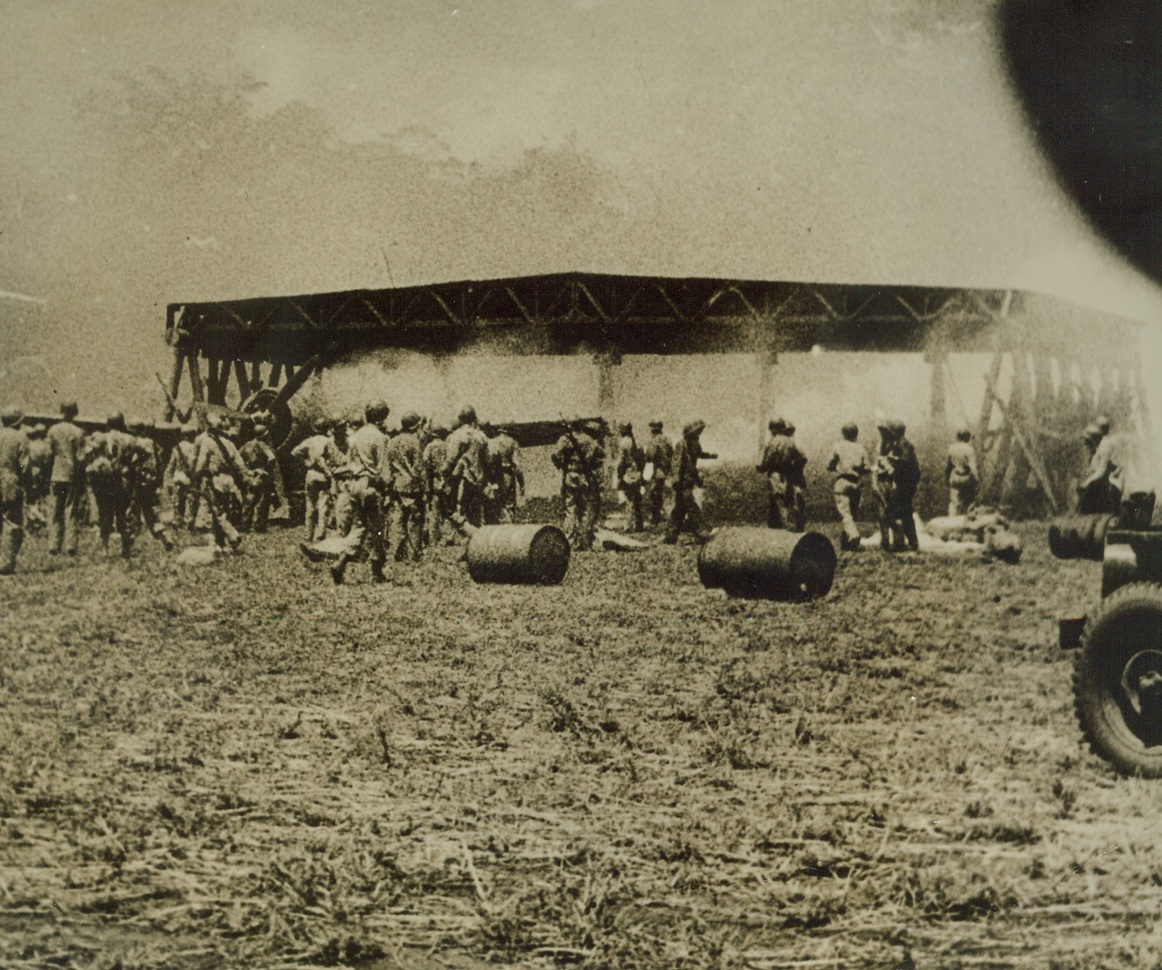
U.S. MARINES FIGHT FIRE IN BOMBED HANGAR, 10/21/1942. This Photo, which has just been released and which is from an Official U.S. Marine Corps newsreel, shows American Marines on Guadalcanal Island fighting fire and rescuing equipment from a hangar on Henderson Field, set afire during a recent attack by Japanese bombers. Note drums of fuel, (foreground), salvaged from the blaze. Credit: U.S. MARINE CORPS PHOTO FROM ACME.;

Arms for the Defenders, 10/25/1942. STALINGRAD—Ammunition and arms for the defenders are ferried to Stalingrad across the Volga. Only a few hundred yards from the vital river, Soviets fight amid flaming ruins, and arriving oil and munitions are used to drive back the Nazis almost the second it is landed.Credit: ACME;
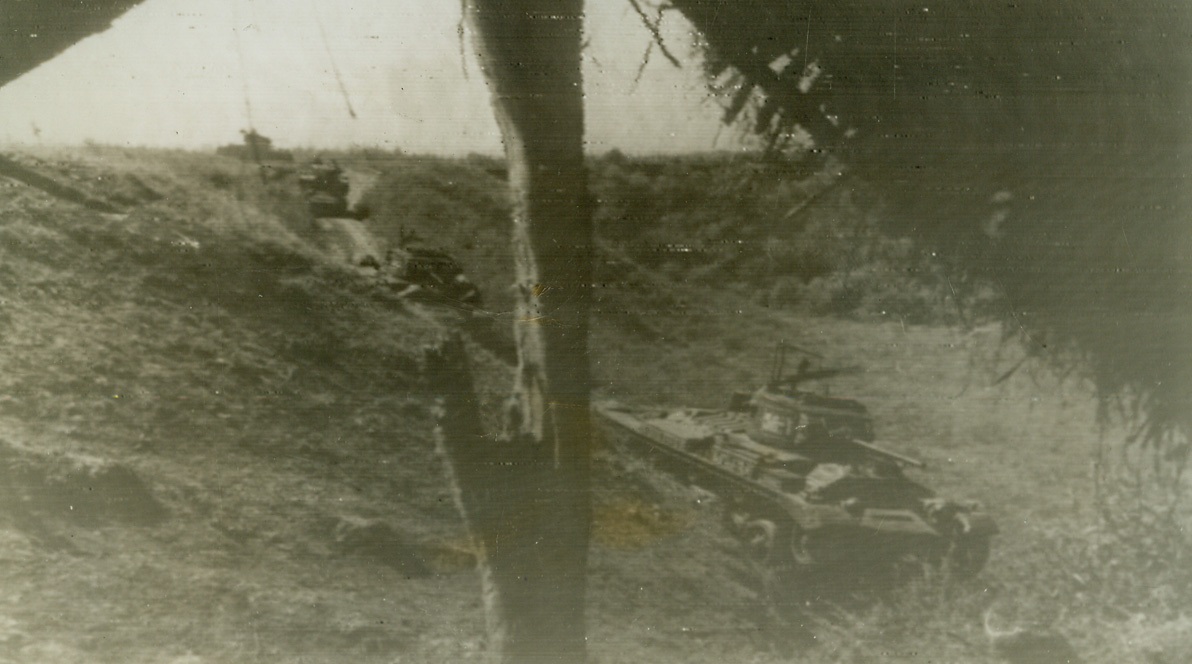
Red Army Tanks in the Caucasus, 1/25/1942. RUSSIA—A column of Red Army tanks moves through the mountainous roads of the Caucasus on their way to blast Nazi lines. Radioed from Moscow to New York.Credit: ACME;
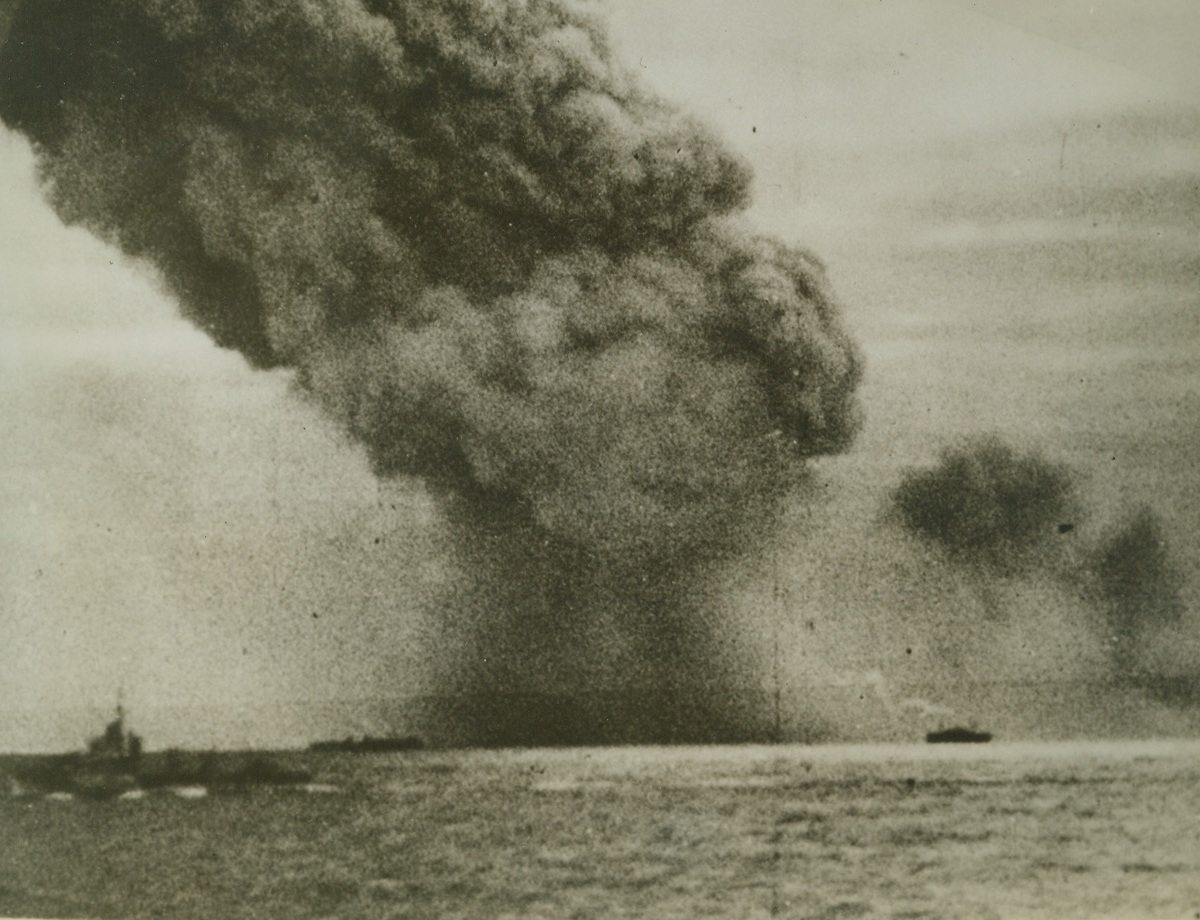
Allied Convoy Fights Through to Russia, 10/9/1942. A pall of smoke rises from an Allied merchant vessel which was sunk during the four-day attack by Nazi torpedo planes and u-boats which intercepted the largest United Nations convoy attempting to reach a Russian Arctic port recently. Despite the intensive enemy action, the larger part of the convoy delivered its cargo intact. (Passed by Censors). Credit: ACME;

Relief Army Progresses Near Stalingrad, 10/21/1942. RUSSIA—Timoshenko’s relief army men cross to the western bank of the Don, northwest of Stalingrad. After battering at Nazi lines for ten days they were able to make notable progress. Credit: ACME;
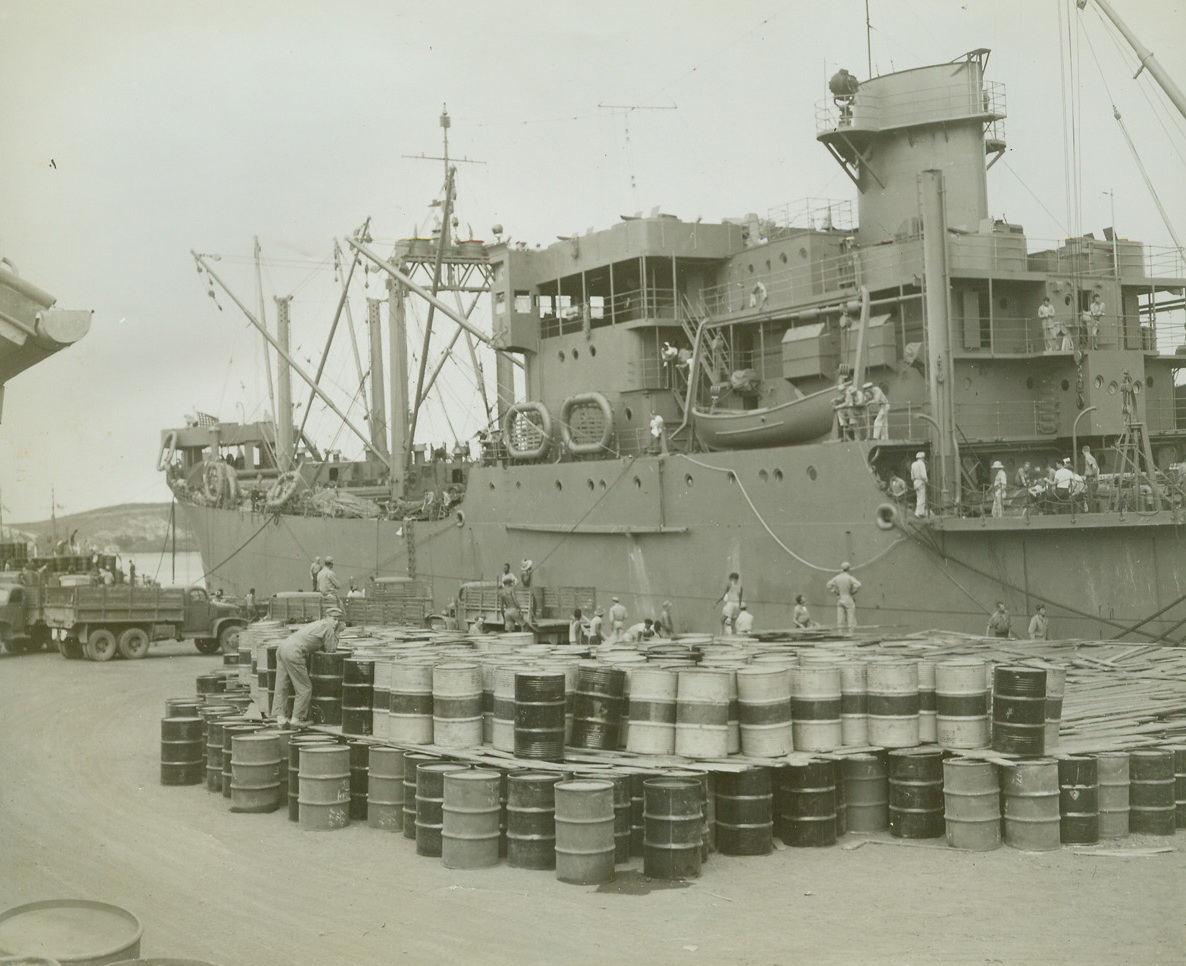
Supplies for the Solomons, 10/2/1942. South Pacifiic Port – Supplies of oil, together with foodstuffs, motors, and tractors, are loaded at a South Pacific port for shipment to the Solomon islands, where they will bolster U.S. Marine and Navy forces entrenched there. Credit line (ACME);
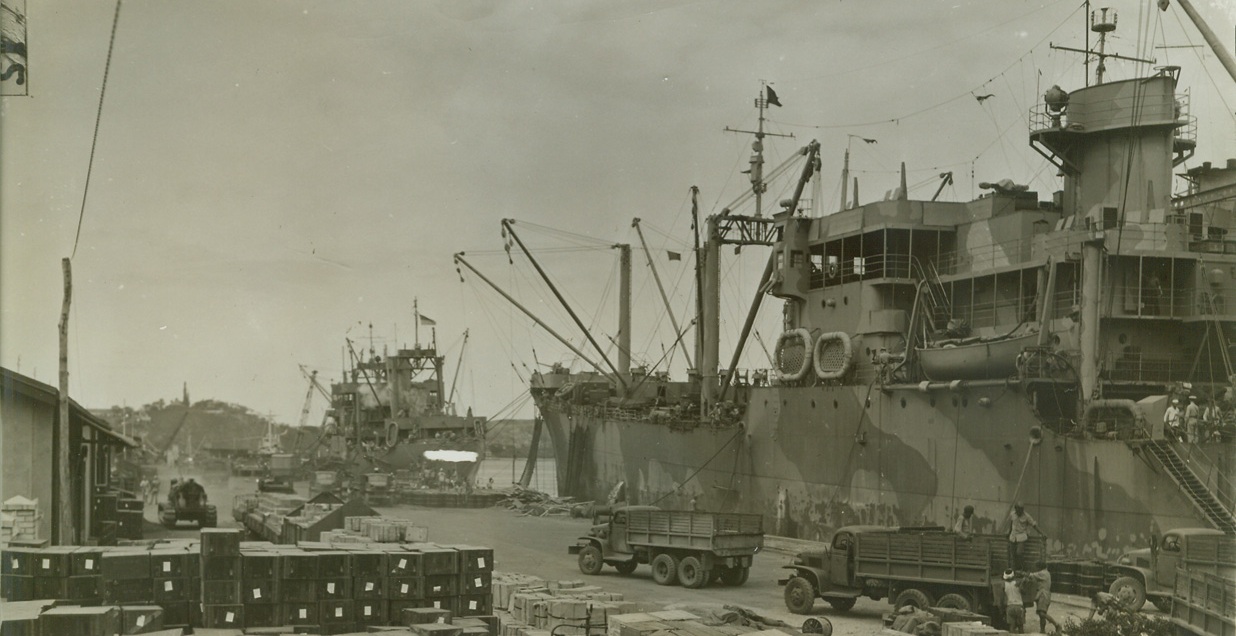
Supply Ships for the Solomons Load Up, 10/2/1942. South Pacific Port – Tons of foodstuffs, motors, oil and tractors wait on the dock of a South Pacific Port to be loaded for shipment to the Solomon islands, where they will supply U.S. Marine and Nay forces entrenched and ready for new assaults on Jap bases. Credit line (ACME);
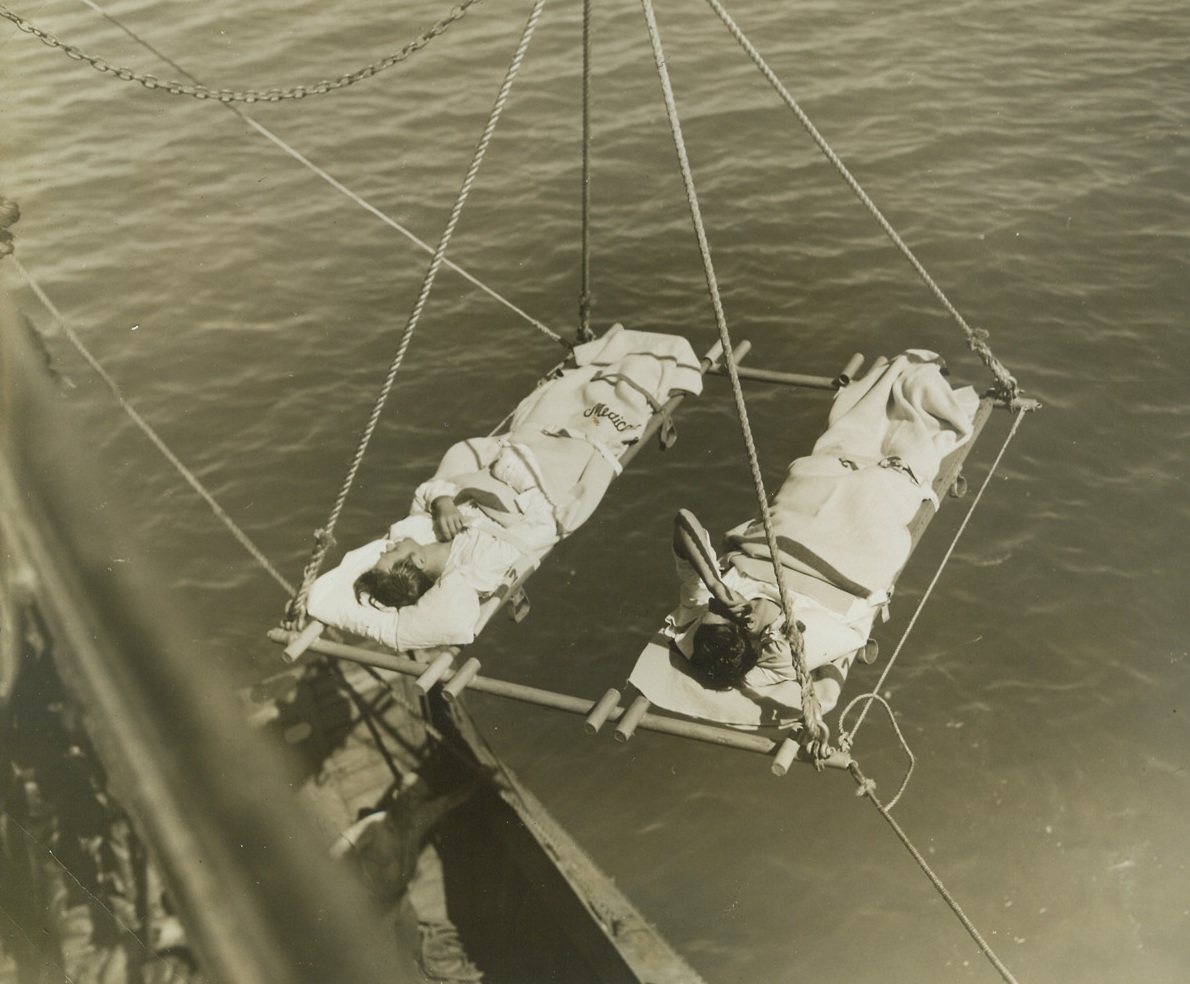
Solomon Wounded Arrive to Safety, 10/2/1942. South Pacific Port – A special stretcher-bearing crane (above) transfers wounded men from transport to shore boat to shore at a South Pacific port, where they will receive further medical aid. The men took part in the battle of the Solomons. Credit line (ACME);
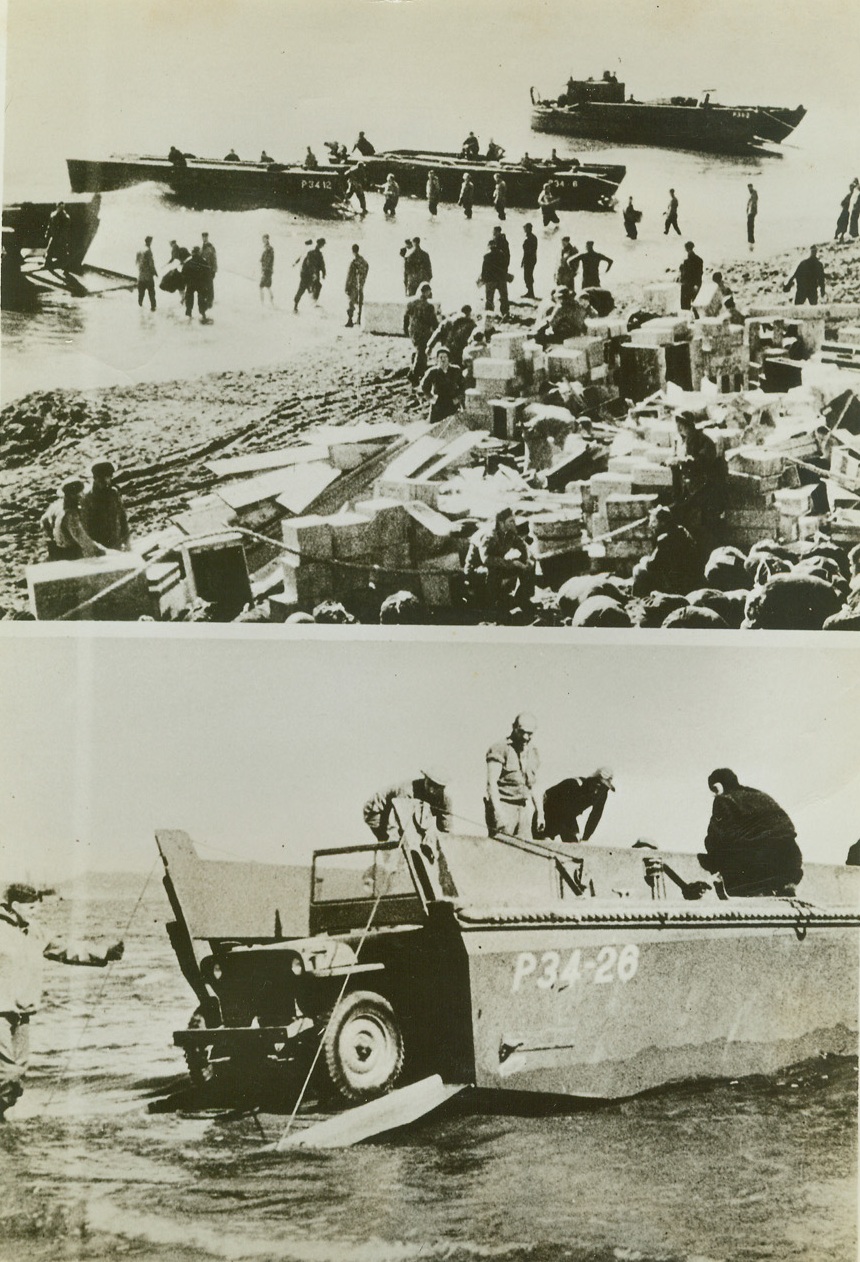
Supplies for Fighting Men and Machines, 10/6/1942. Bales and crates of assorted war materials for the U.S. troops who have occupied one of the Andreanof Group in the Aleutian islands are brought ashore (top) from the Navy-protected convoy. Below, a jeep noses its way shoreward from a snub-nosed landing barge. By occupying this island which is only about an hour’s flying time from Japanese-occupied Kiska, the American airmen are able to keep the Nipponese under constant aerial bombardment. No credit line shown.;
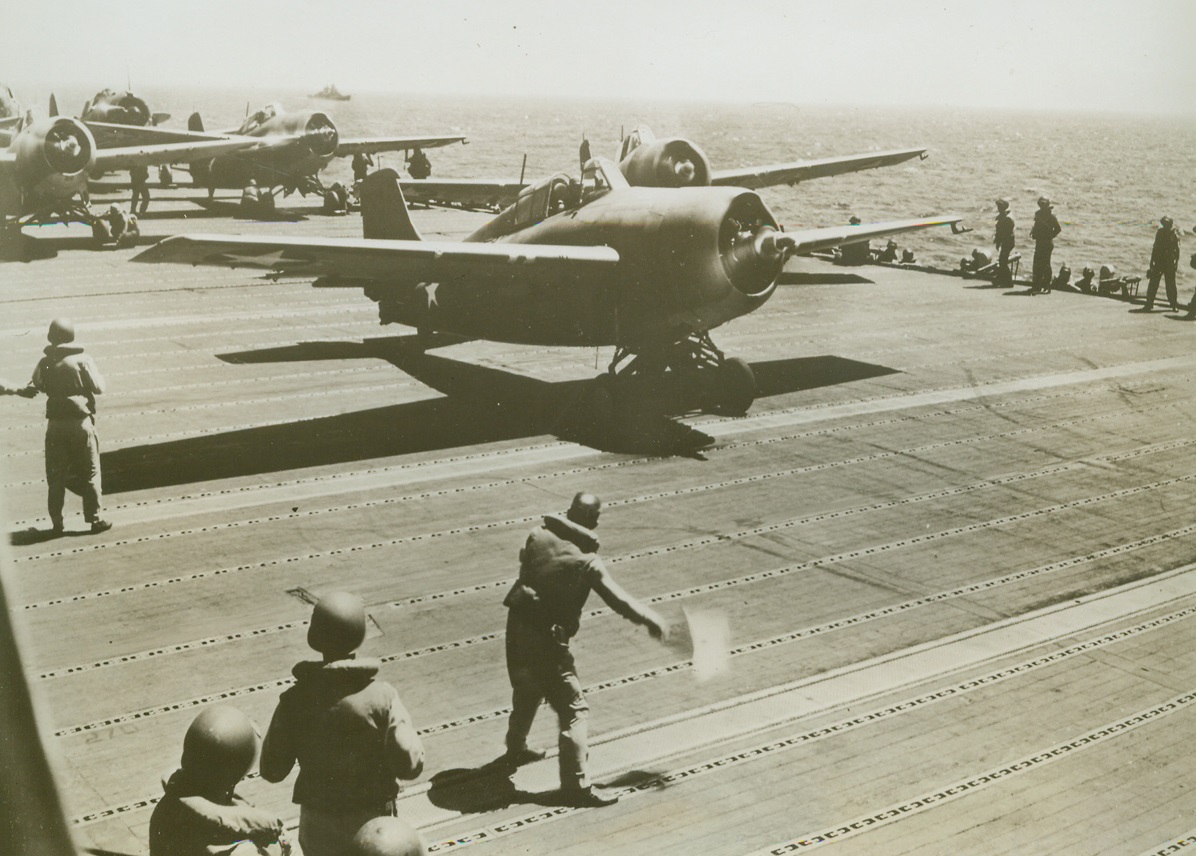
Pacific Jap Hunters, 10/23/1942. Somewhere in the Pacific – It’s a tense moment as planes prepare to take off from their carrier base in the Pacific. In a few seconds they will leave their ocean-bound landing field to hunt out and attack the Japanese. Credit (ACME U.S. Navy official photo);
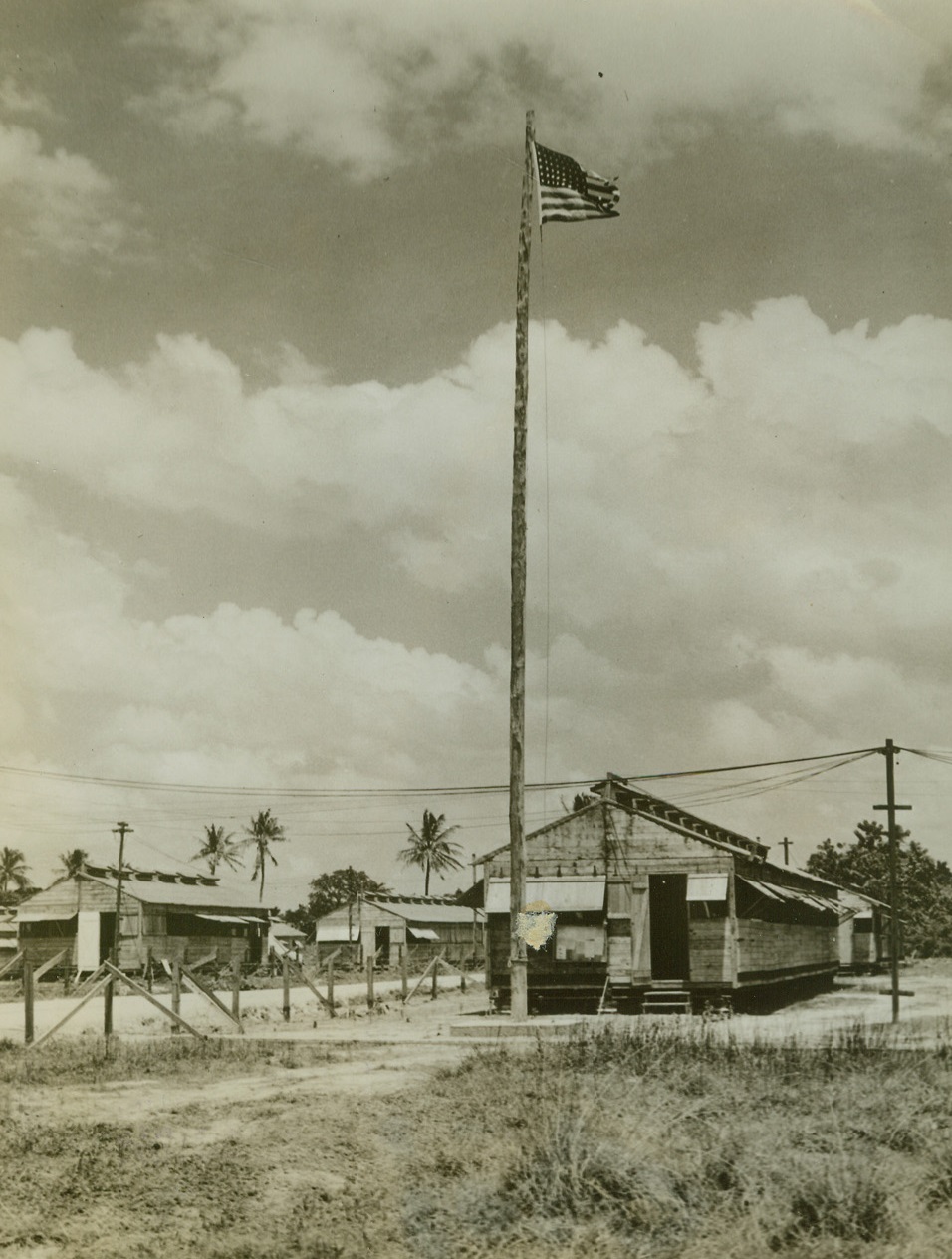
U.S. Moves Into Dutch Guiana’s Capital, 10/23/1942. Paramaribo, Dutch Guiana – Evidence of Uncle Sam’s keen interest in the protection of Dutch Guiana are these U.S. Army barracks in Paramaribo, capital of the war-important Dutch province. Credit line (ACME);
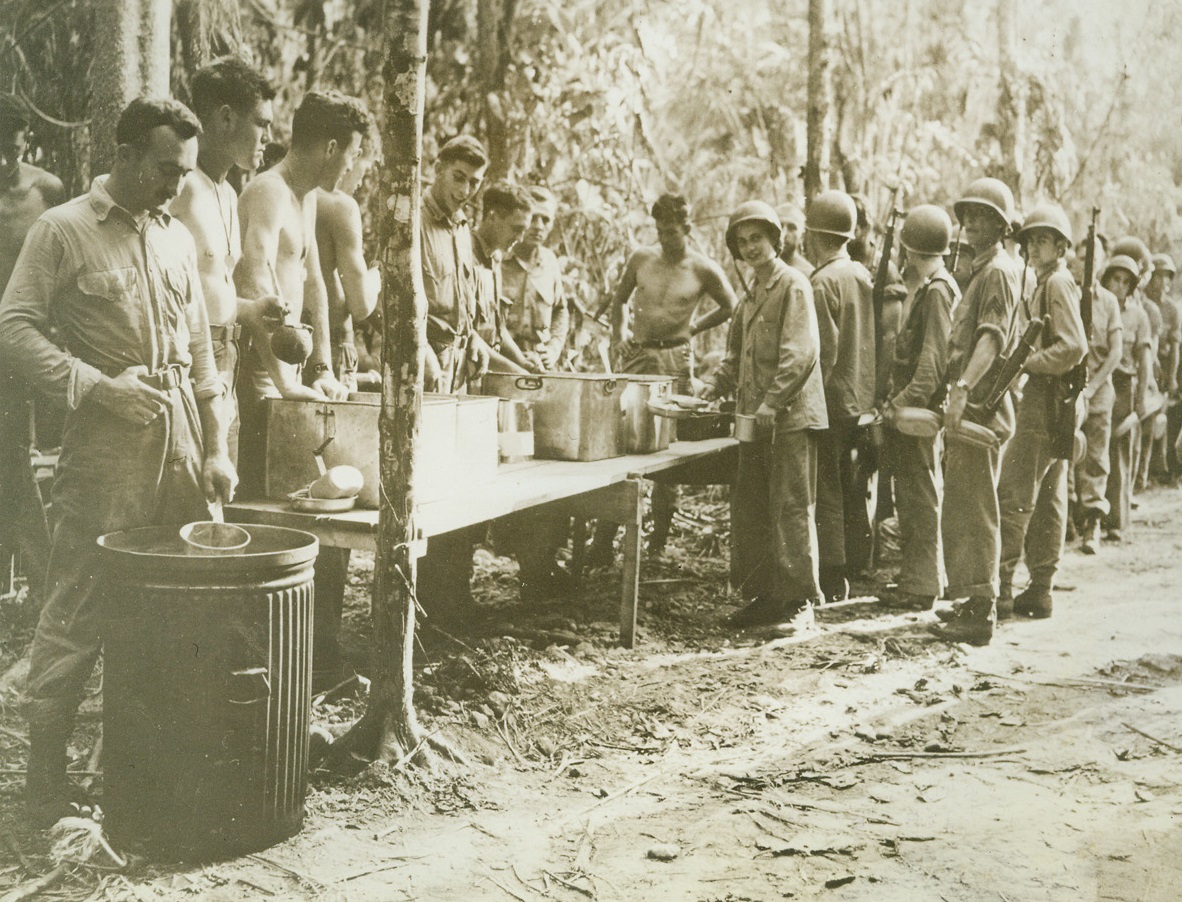
Chow on Guadalcanal, 10/23/1942. Solomon Islands – U.S. Marines who are battling to hold strategic American positions on Guadalcanal island line up for chow served cafeteria style in the island’s jungle. Picture was made shortly after U.S. troops had blasted the Japs out of several of their positions in the strategic Solomons. Official Marine Corps photo from ACME;
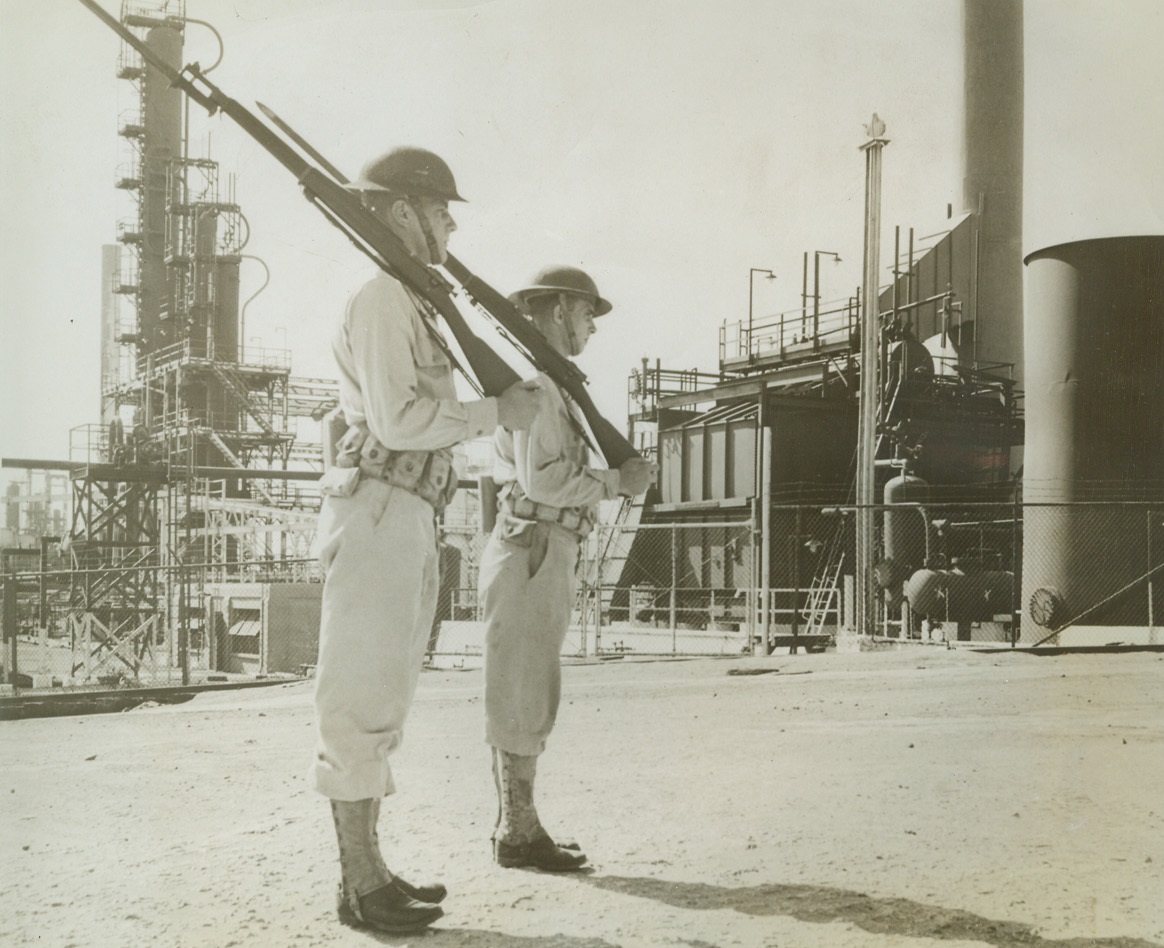
Uncle Sam Guards Dutch Oil on Aruba, 10/23/1942. Aruba Island, Dutch Guiana – Two U.S. soldiers stand guard before the enormous Lago oil refineries at Nicolaas, on Aruba island. Credit line (ACME);
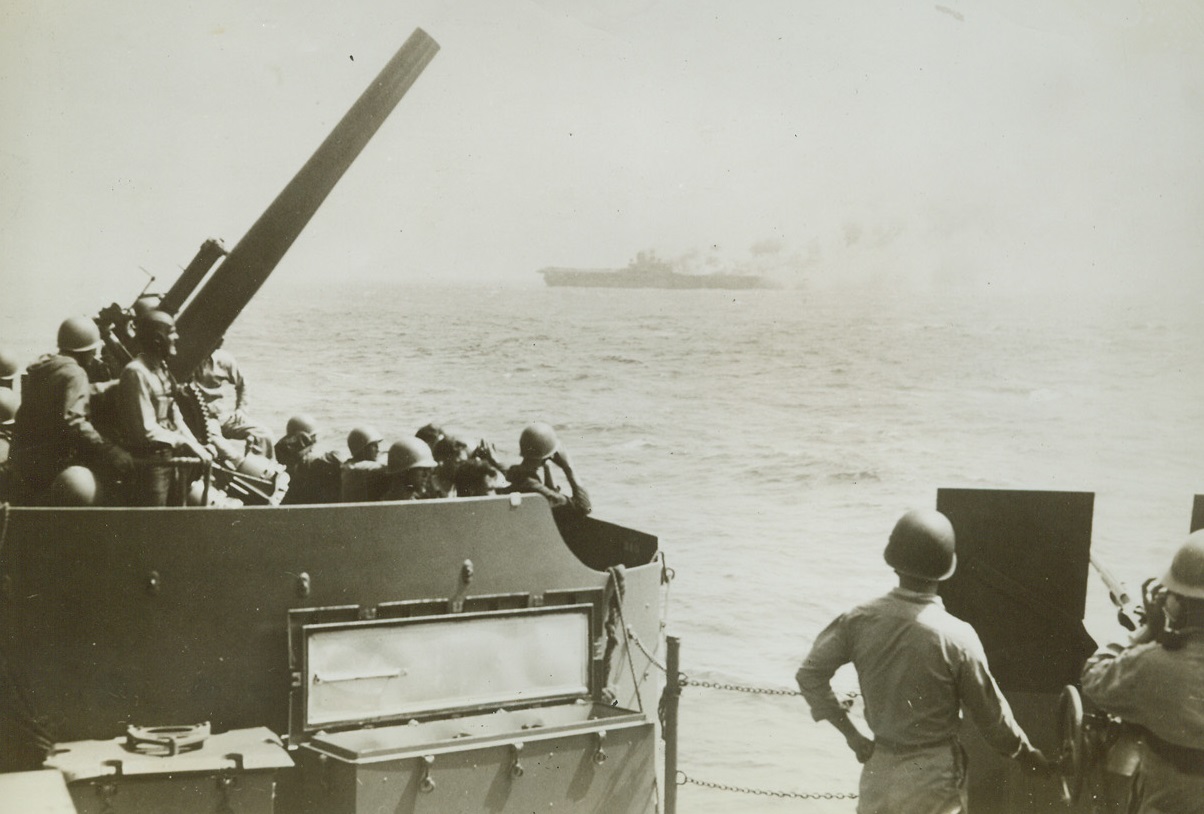
Death of the Wasp, 10/28/1942. South Pacific – Men of an accompanying warship look on sadly as the USS Wasp blazes fiercely after being struck by three enemy torpedoes on Sept. 15th. The carrier, wrecked by explosions and flames, was finally sent to the bottom by torpedoes of a U.S. Destroyer. Credit (official US Navy photo from ACME);
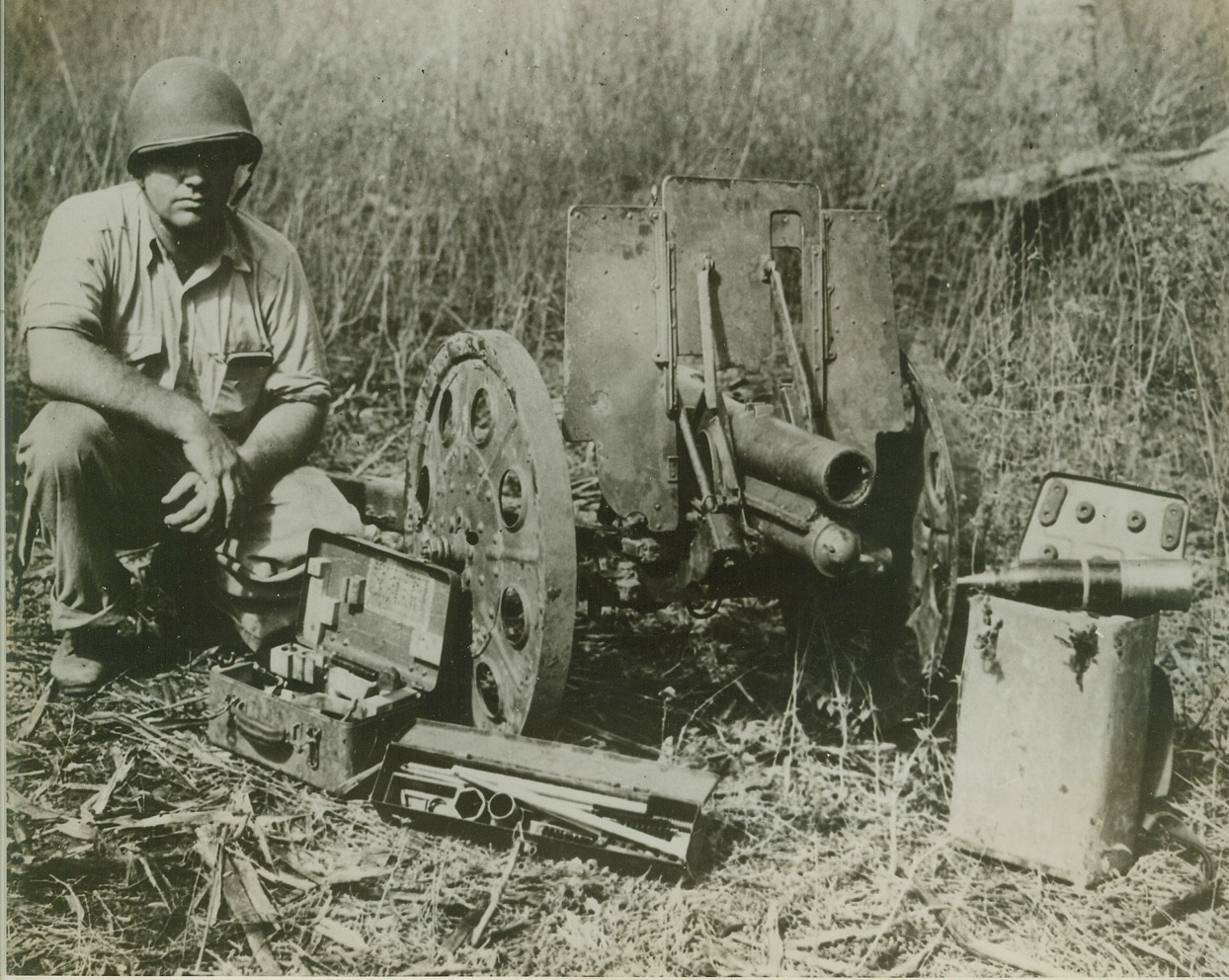
Battle Raging in the Solomons, 10/15/1942. United States forces are striving to prevent the Japanese from landing reinforcements on Guadalcanal. The above photo just released by the US Navy shows a small Japanese piece that was captured by U.S. Marines during the early stages of the battle of the Solomons. It is a 70 m gun, classified as an infantry weapon. It was taken during fighting on Guadalcanal. Credit line (U S Navy official photo from ACME);
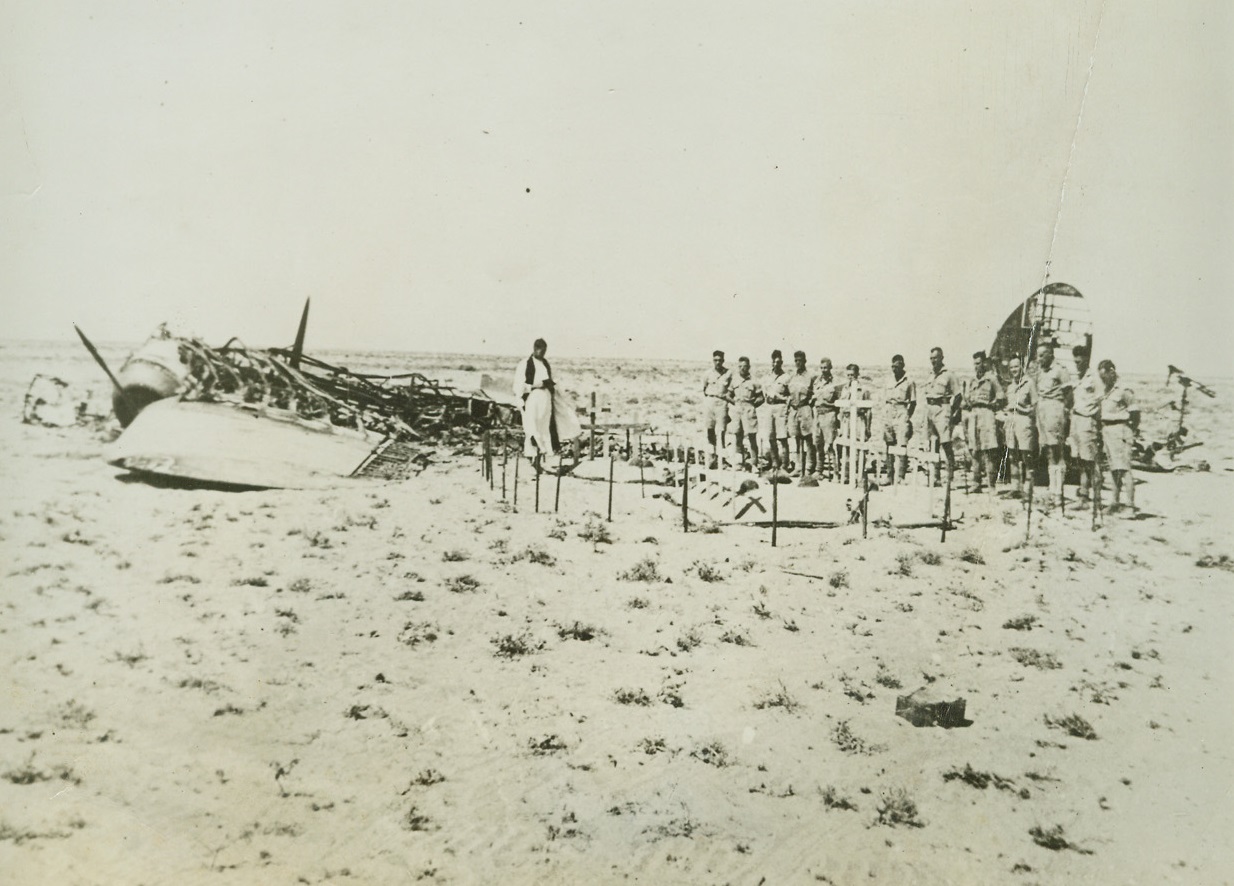
Desert Funeral Services for British Officer, 10/25/1942. Somewhere in Egypt – The scattered wreckage of the plane in which they met their death is an additional desert-graveyard marker for the final resting place of Lt. Gen. “Strafer” Gott and his men who died with him in the crash. British soldiers stand soberly at attention as the funeral service is read. Men who once fought with the deceased Lieutenant General are now pouring deep inside German lines in the new battle for North Africa. Credit line (ACME);
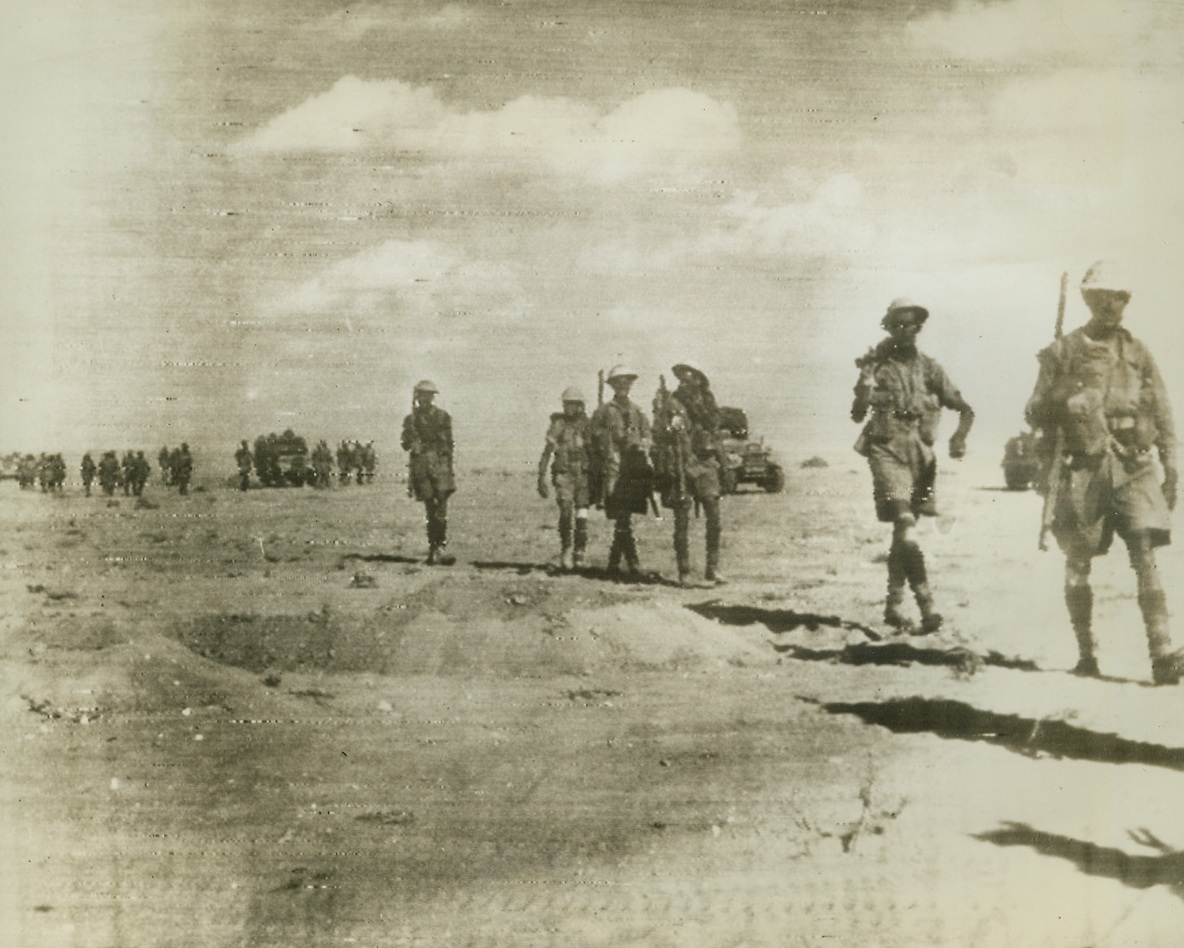
Rommel Being Pushed Back in Desert, 10/29/1942. Egyptian Front – British 8th Army infantry and trucks are shown as they forged ahead on the offensive against German forces in Egypt, in this photo flashed by radio from Cairo to New York, Oct. 29. In spite of axis counterattacks, United Nations forces are still advancing through German minefields.Credit line (ACME radio photo);
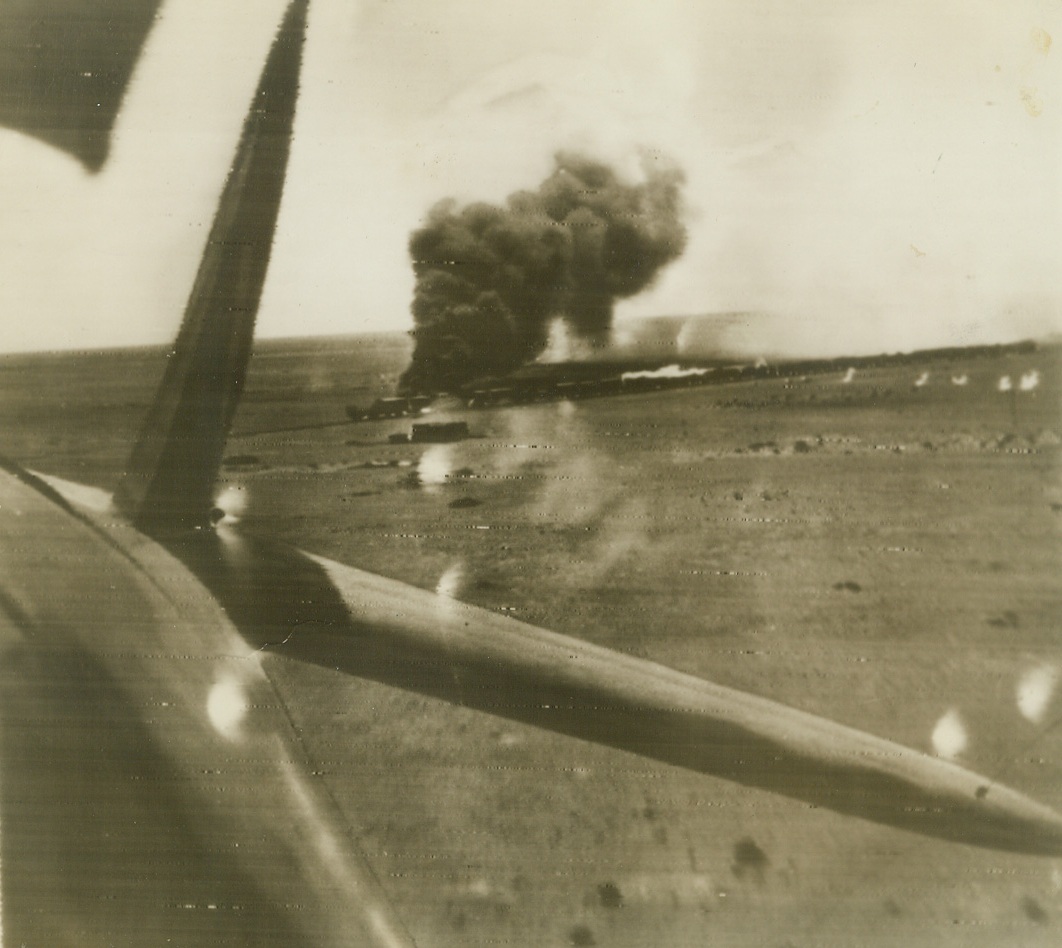
Axis Desert Supply Train Shattered, 10/16/1942. This remarkable picture of an enemy supply train ablaze after an attack by long range RAF fighters and South African Air Force light bombers was taken backward over the tail of one of the attacking planes. An ammunition car was blown to pieces and the locomotive set afire by low flying fighters which raked the train with cannon fire. Twenty six cars were left shattered. Photo was flashed to New York from Cairo today by radio. Credit (ACME radio photo);
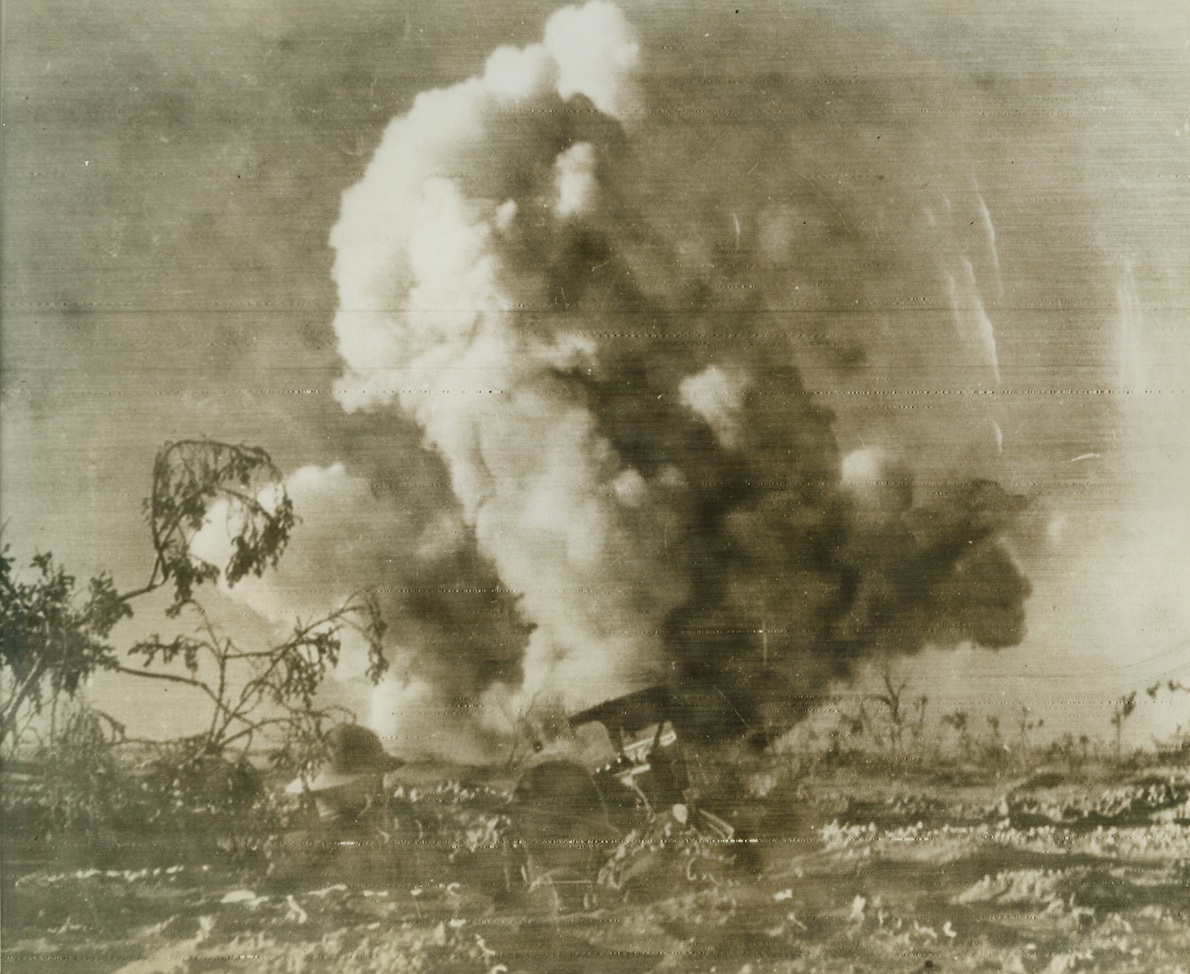
British Mortar Stands Heavy Fire, 10/28/1942. Western Desert – Heavy enemy fire harasses this British mortar in a newly taken position in the present allied offensive against Rommel in the Western desert. The cameraman was close enough to catch the ear-splitting noise of the blast. Photo radioed from Cairo to New York today. Credit line (ACME radio photo;
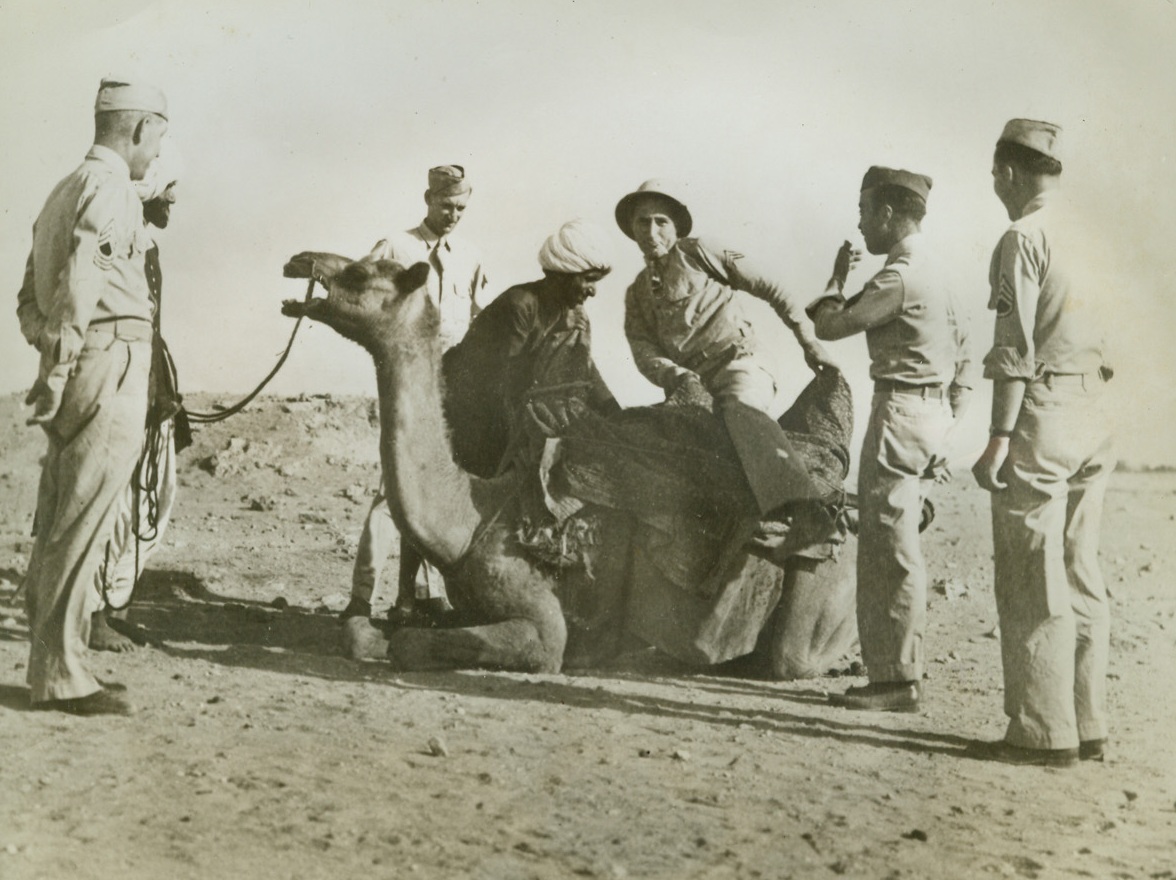
“Ride ‘Em Cowboy!”, 10/21/1942. This photo just released by the War Department in Washington, shows U.S. soldiers stationed in India as they try out a novel form of transportation. From the expression on the camel’s face, the ride is going to be a tough one!Credit: U.S. Army photo from ACME.;
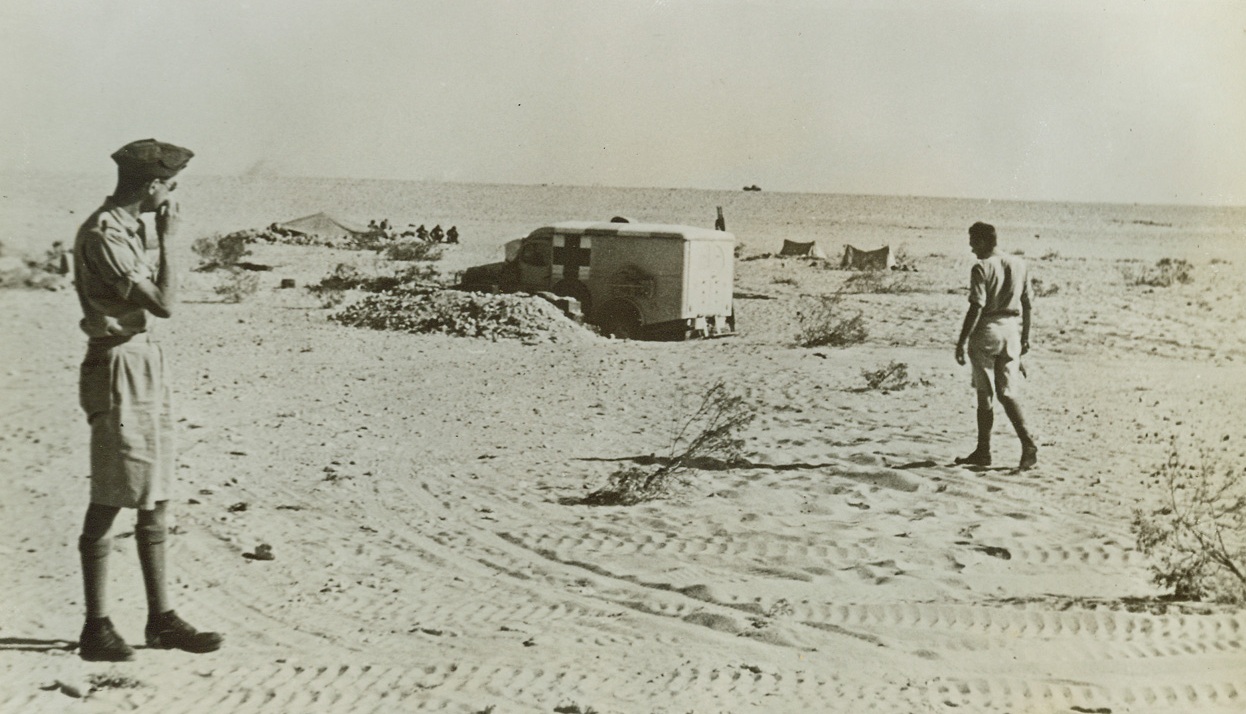
First Aid in North Africa, 10/25/1942. North Africa—A regimental aid post, a med unit with Allied forces, is parked on the front line where it will do the most good in the desert war. Frederick W. Hoeing, (left), of Rochester, N.Y., is a volunteer ambulance driver. In the far background on a tank patrol. Credit: ACME.;
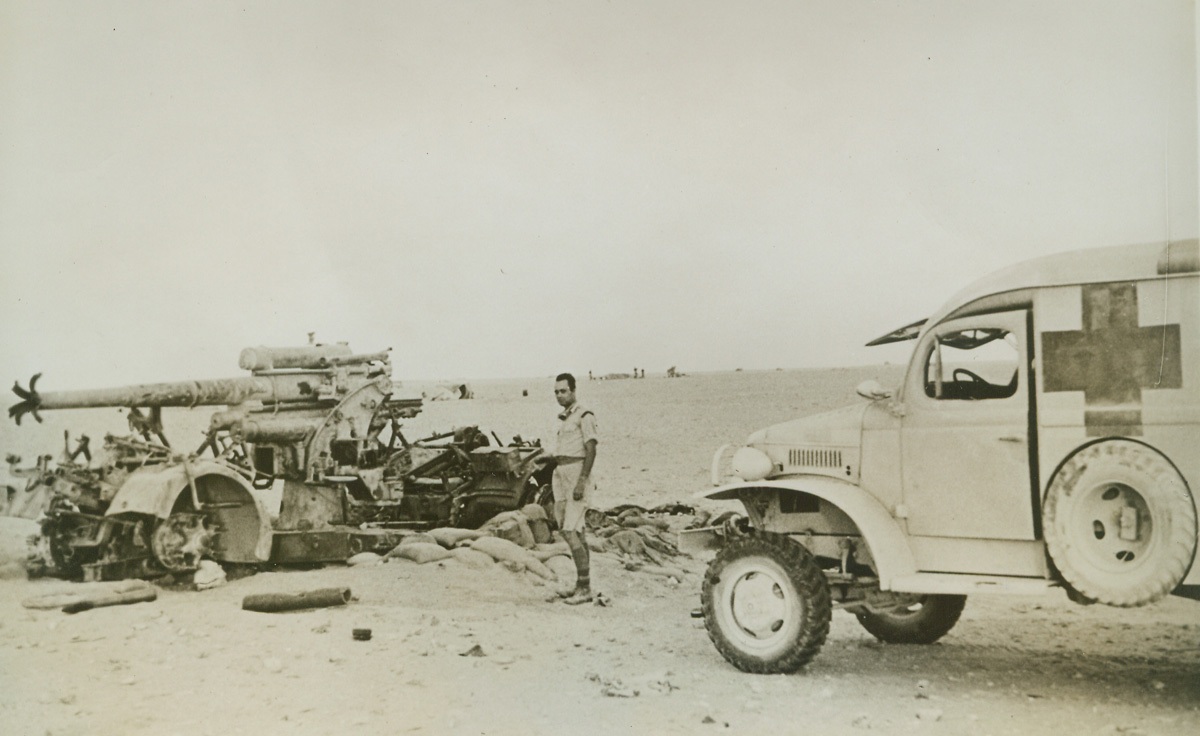
He Found No Wounded, 10/25/1942. North Africa—A volunteer ambulance driver with the American Field Service finds no wounded as he drives up to the Nazi gun, destroyed by Allied forces in the Middle East.Credit: ACME.;
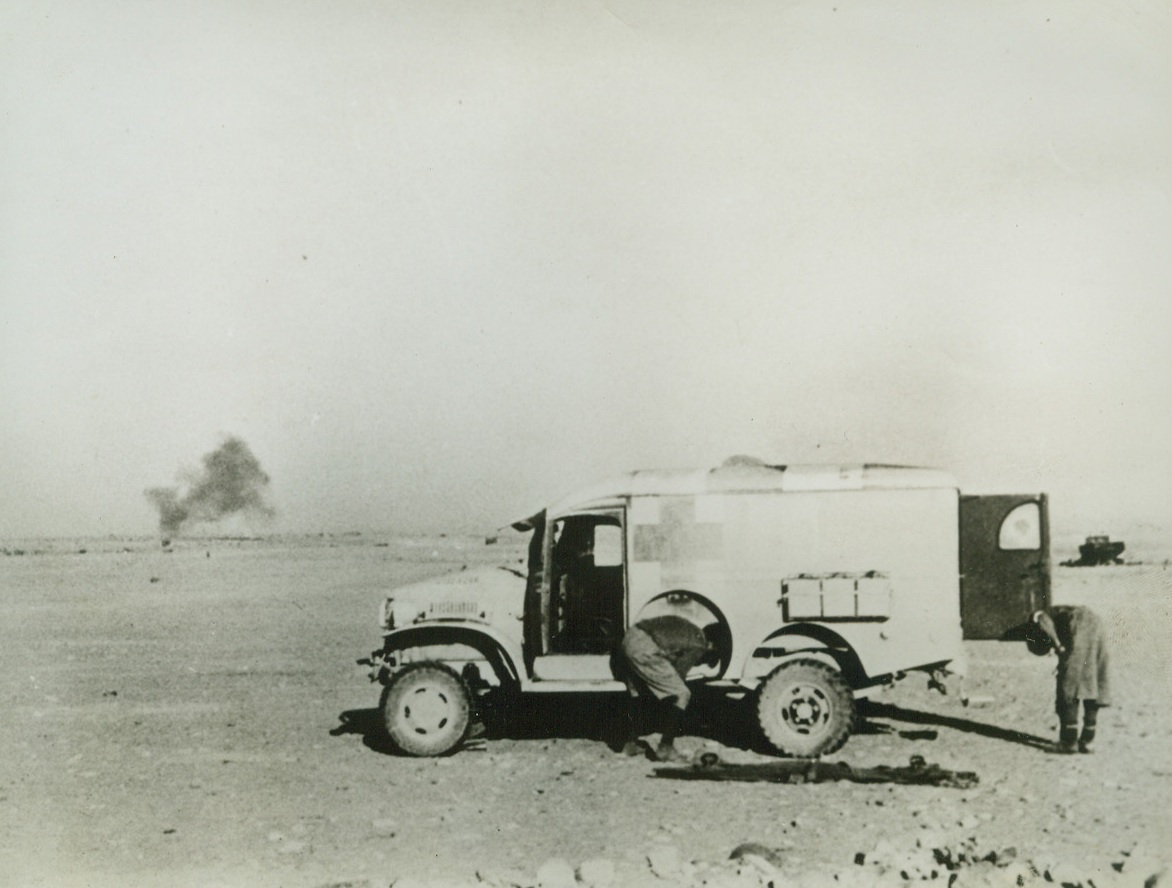
Ducking Shrapnel, 10/25/1942. North Africa—Edward J. Sullivan, ambulance driver from Kansas City, crouches beside his vehicle as shells burst nearby. A New Zealander takes refuge behind the open door as they wait for a lull in the fire to go out and pick up possible wounded. Both are with the American Field Service, which provides ambulances for Allied forces in Africa. Credit: ACME.;
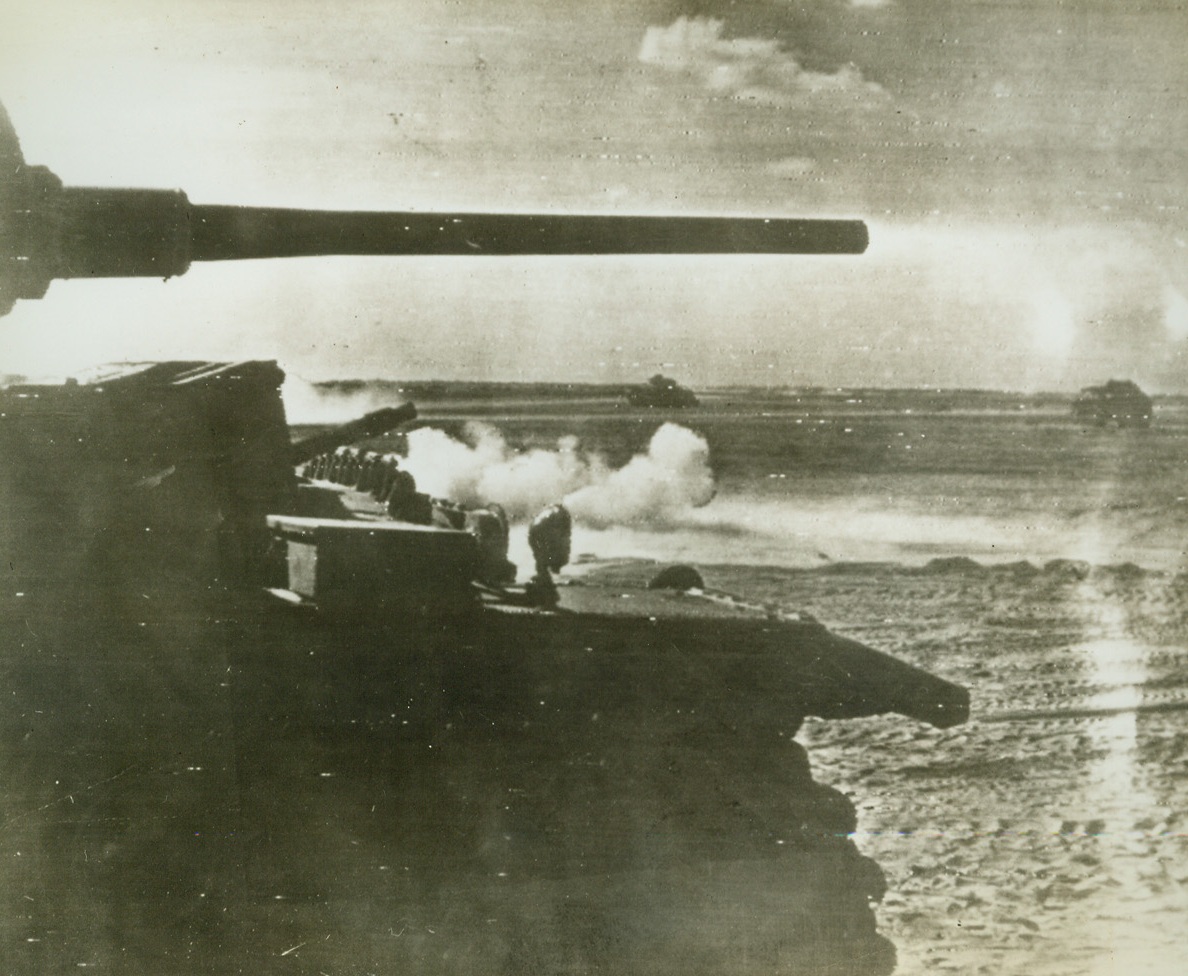
Allies Forge Ahead in Desert, 10/29/1942. Egyptian front—In this photo flashed from Cairo to New York, Oct. 29, a British tank rolls past two German armored vehicles, smashed and left immobile after a recent tank battle. United Nations forces are forging ahead in their offensive against German General Rommel’s forces, in spite of Axis counter attacks. (Passed by censors);
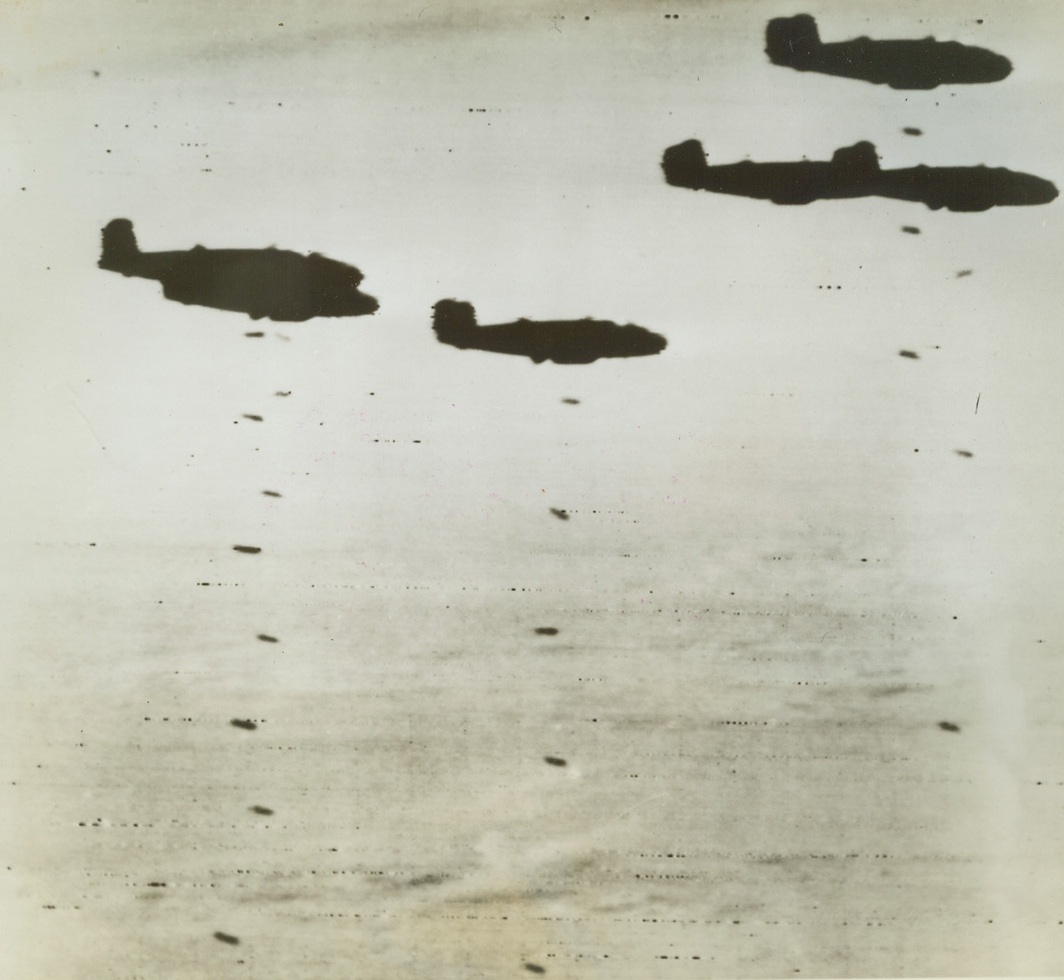
Laying “Eggs” Over Axis Positions, 10/28/1942. Western Desert—A formation of U.S.-built Mitchell (B-52) bombers drop their loads of bombs over the enemy in the Western Desert as the RAF continues its fierce “shuttle service” air attacks. Photo radioed from Cairo to New York today. Credit: ACME radiophoto.;
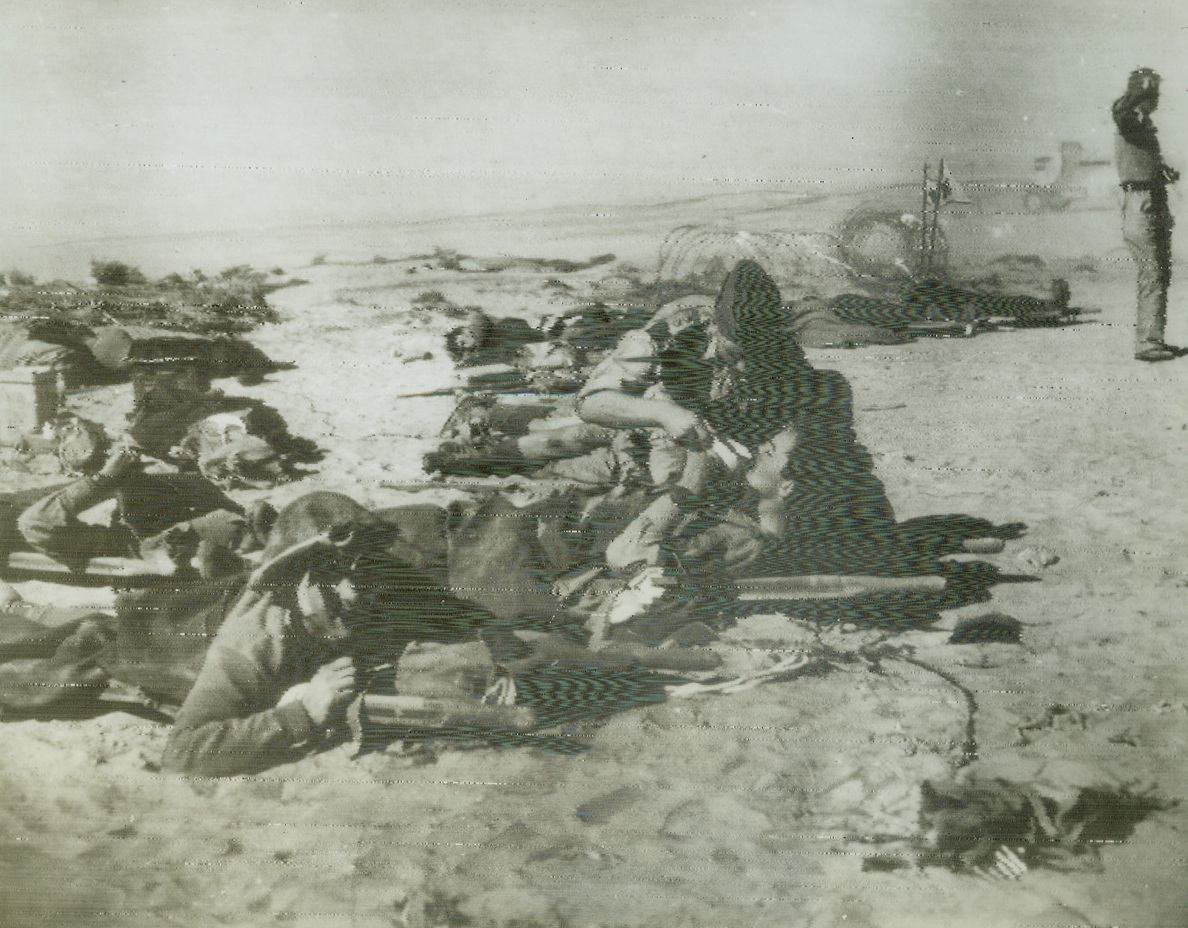
British Casualties in Desert War, 10/27/1942. Cairo—Wounded men of the Highland Division, the first British casualties in renewed warfare in the Western desert, are being tended by the Royal Army Medical Corps at an advanced field dressing station. In view of heavy fighting that has occurred in the past 48 hours, it is expected that casualties have been fairly heavy on both sides. Credit: ACME radiophoto.;
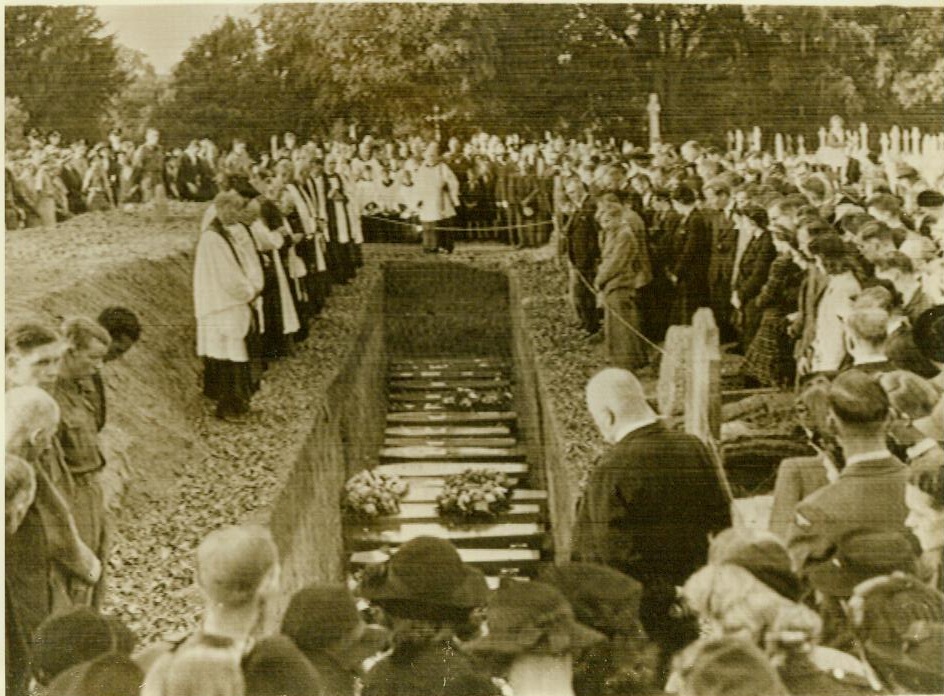
Mass funeral of English schoolchildren, 10/3/1942. ENGLAND - Solemn crowds attend the funeral (above) of 30 victims of a daylight raid on a school in southern England. The headmaster, Charles Stephenson, and a teacher, Charlotte Marshall, were killed together when a German bomb struck the school.;
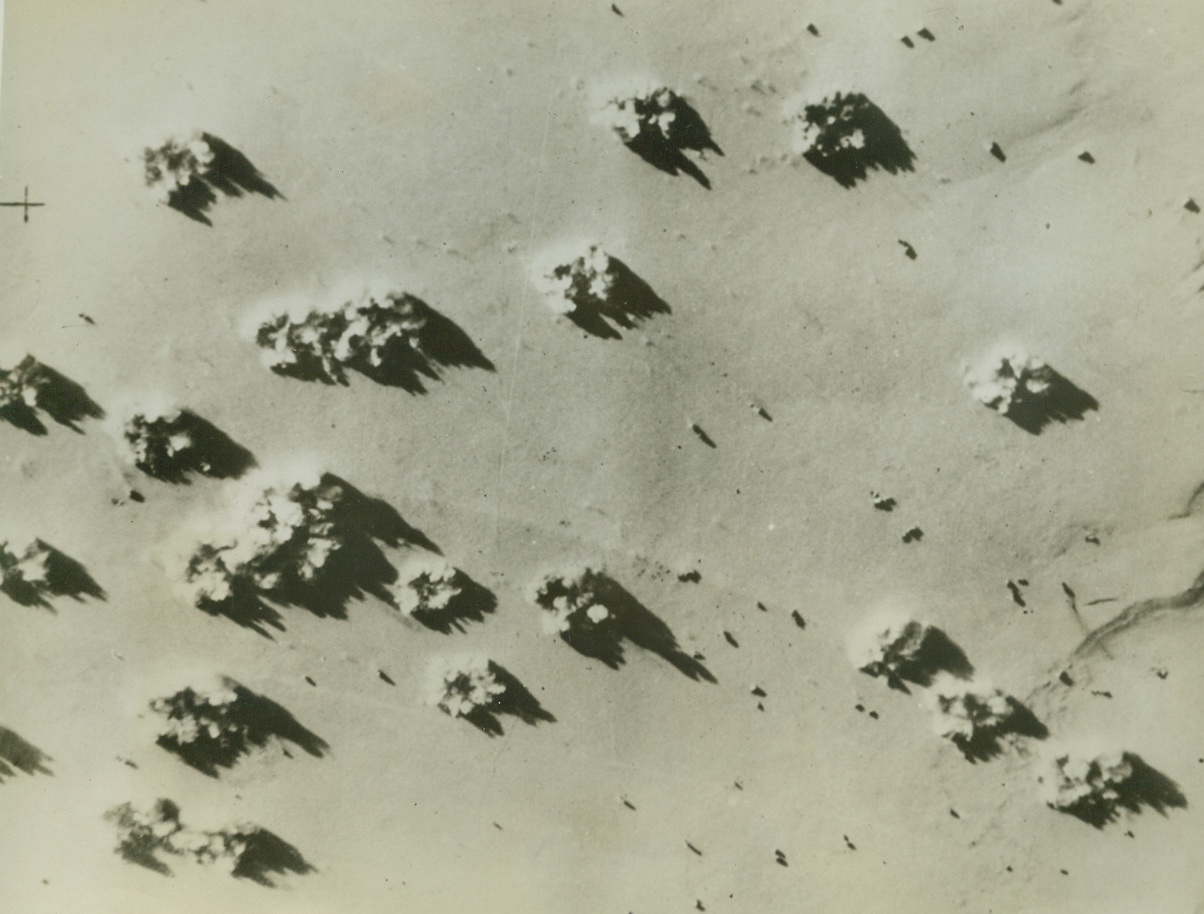
Blasting Rommel’s Motor Transport, 10/2/1942. Egypt—More than a score of bombs burst on a concentration of Nazi Field Marshal Erwin Rommel’s motor transport units on the Western Desert during an attack by light bombers of the Allied air force. Passed by British censor. Credit: ACME.;
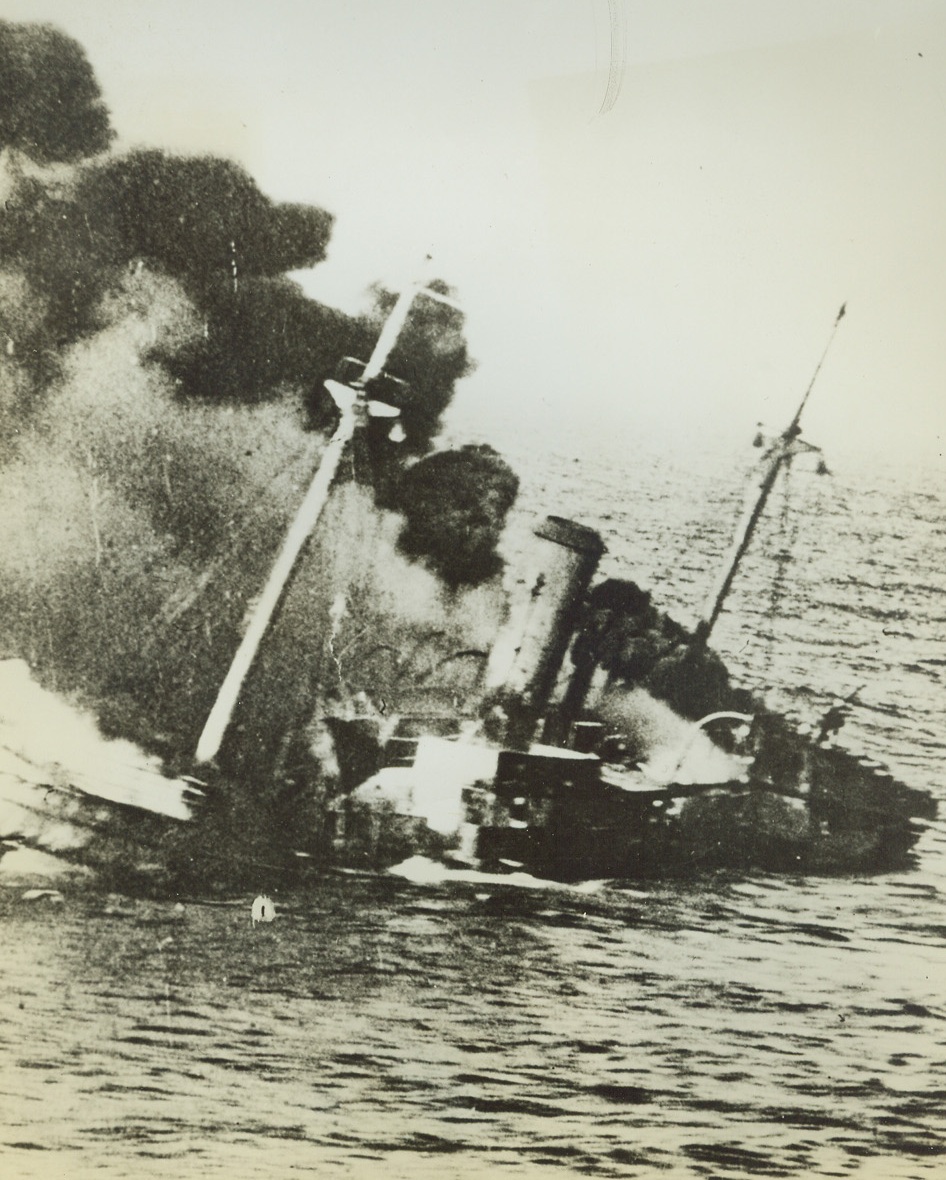
Destination: The Bottom of the Mediterranean, 10/3/1942. Here’s an Axis vessel that didn’t get to North Africa with supplies for Field Marshal Erwin Rommel. Ablaze from stem to stern and listing badly to port, she heads for the bottom of the eastern Mediterranean after being hit by RAF planes. Passed by British censor. Credit: ACME.;
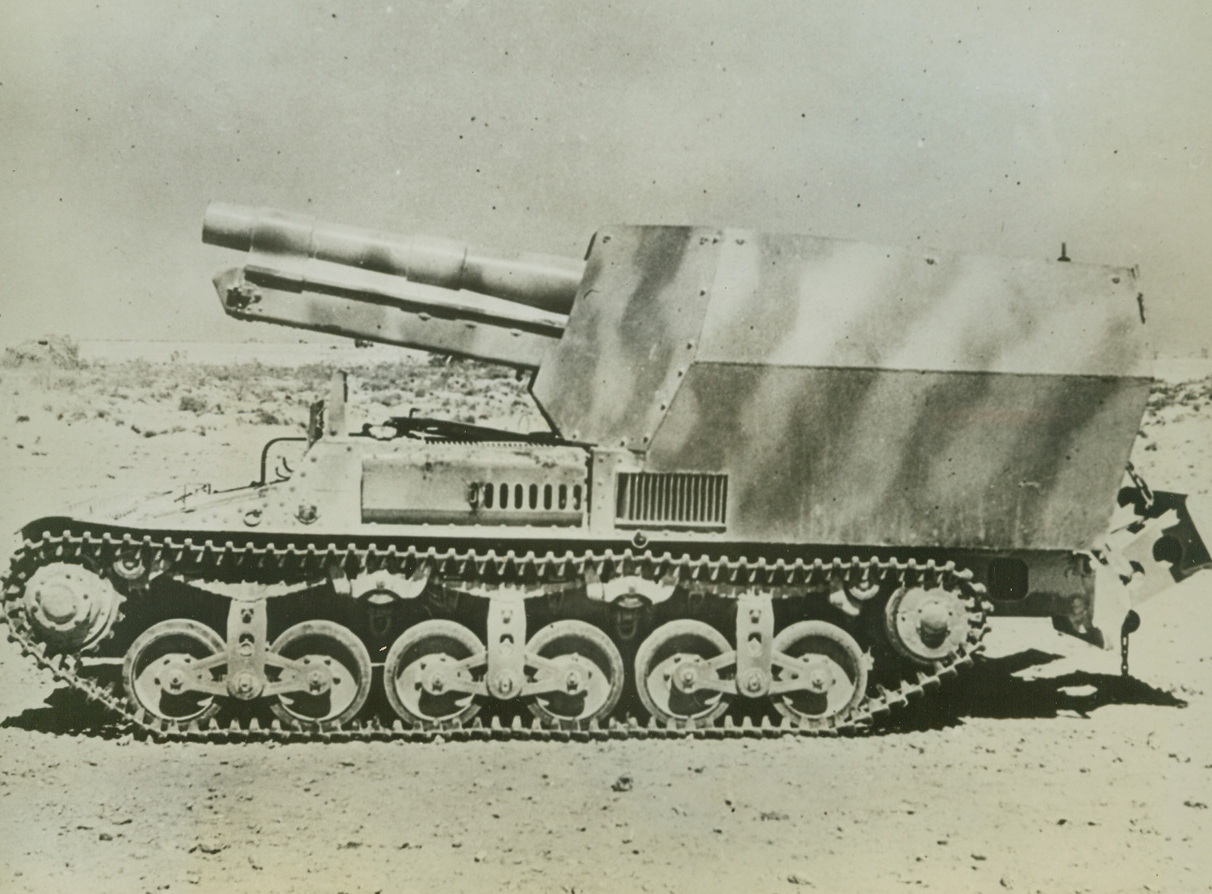
German Mobile Gun Taken in Desert, 10/3/1942. Egypt—This 15-centimeter mobile gun was captured intact from the Axis recently in the Western Desert. Chassis is of French manufacture, possibly having been made in the Renault works which the RAF shattered this summer. Less than 1,000 kilometers were registered on the speedometer when the machine was captured. Passed by British censor. Credit: ACME.;
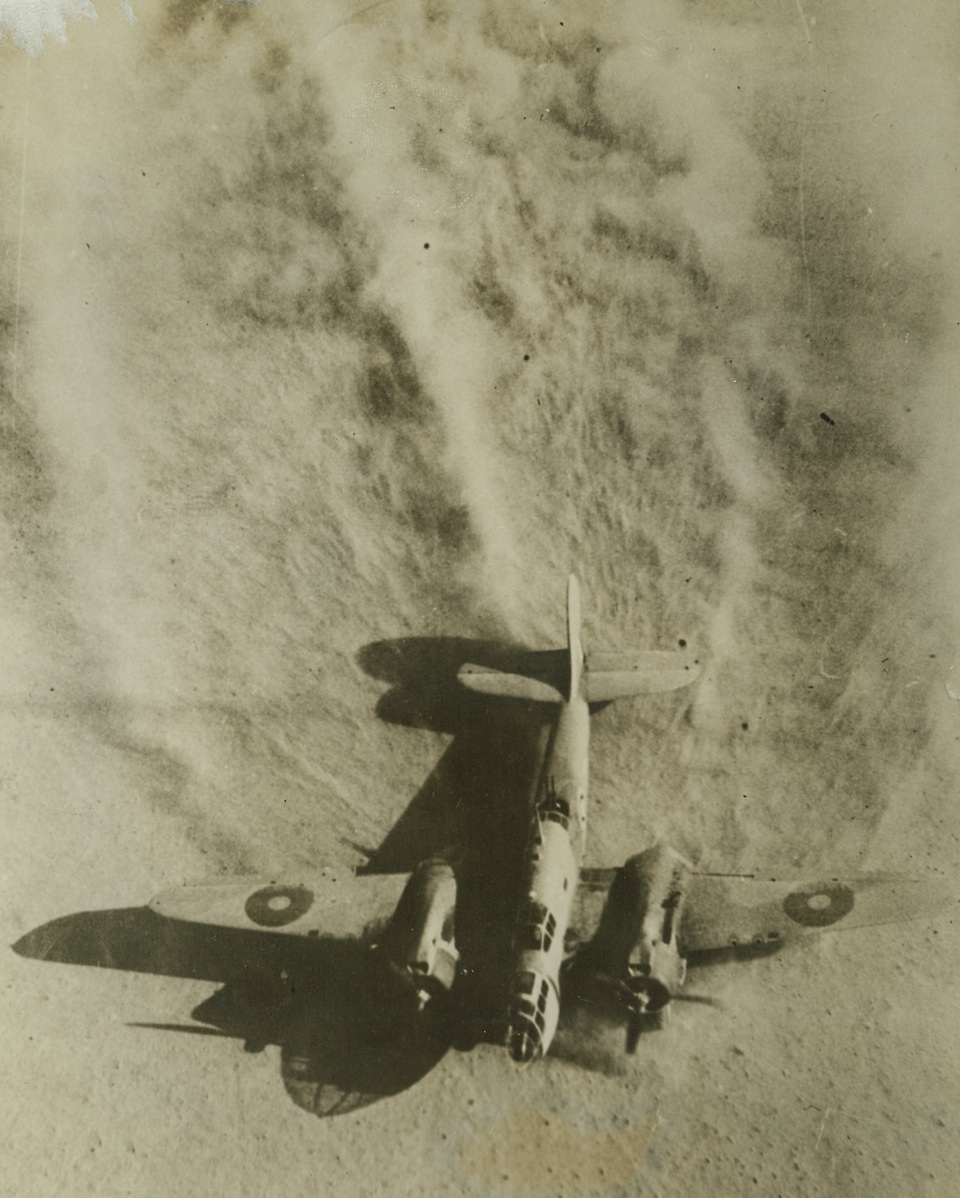
U.S. Desert Bird Takes Off, 10/19/1942. North Africa—Leaving a trail like a graceful ostrich feather, this martin medium bomber takes off in the dust of the Western Desert, to make a raid on Rommel’s supply lines. For the past weeks light and medium bombers of the Allied air forces have been hitting Axis positions hard. Passed by censor Credit: ACME.;
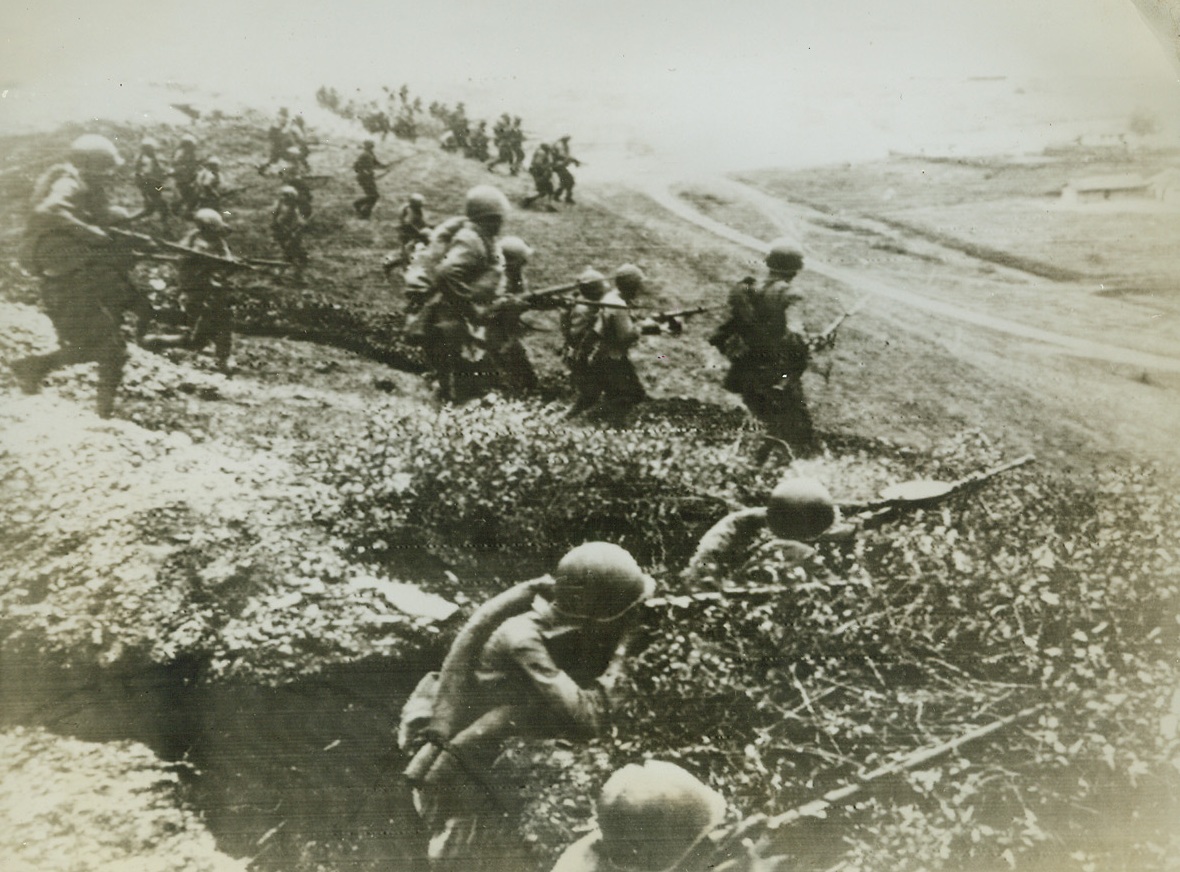
Nazi Spearhead Blunted in Caucasus, 10/28/1942. New York, N.Y.—In this photo, flashed by radio from Moscow to New York, Oct. 28, Red Guardsmen are shown attacking the Nazis in the Nozdok area of the northern Caucasus. Today’s information from the area, indicates that Nazis driving toward valuable Caucasus oil fields have been pushed back from Tuapse in heavy mountain combat. Passed by censors. Credit: ACME radiophoto.;
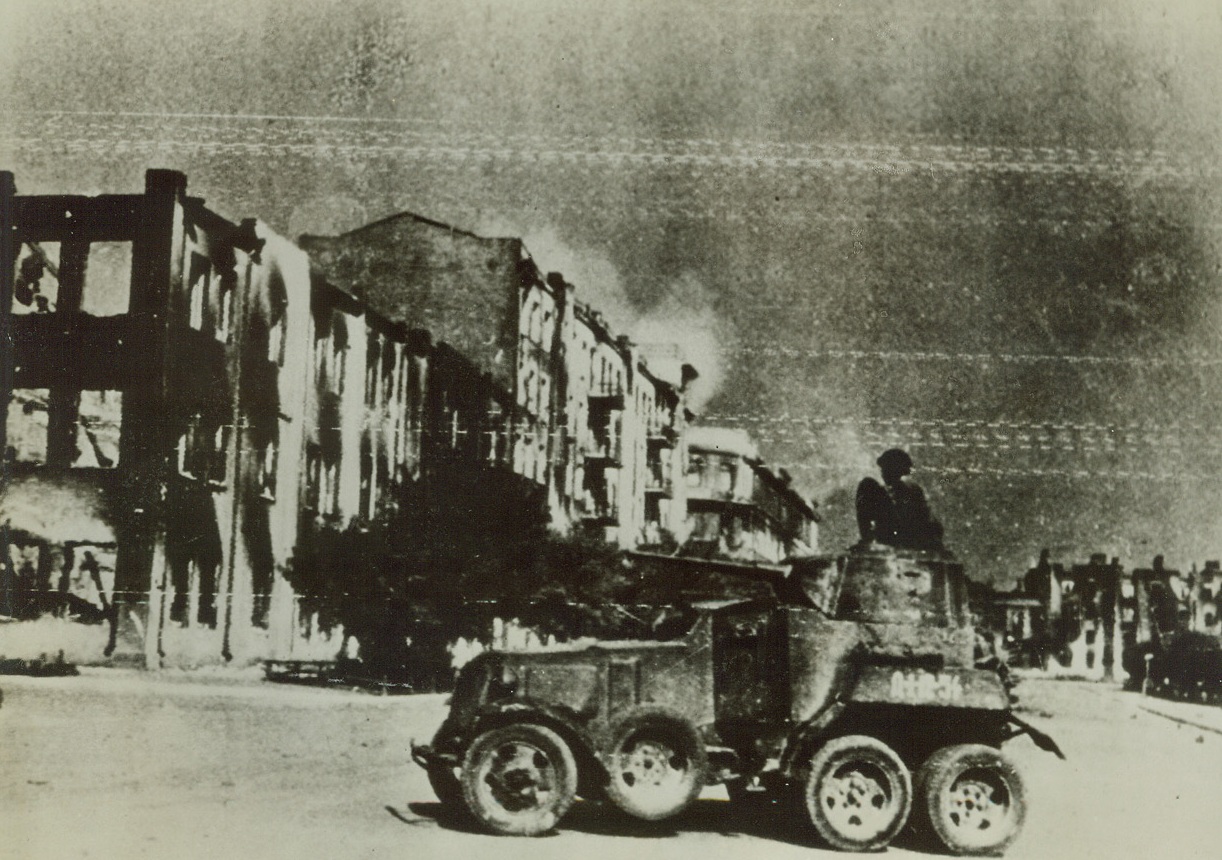
In Embattled Stalingrad, 10/19/1942. Stalingrad—A Russian armoured car patrols the deserted streets of Stalingrad. Note the wrecked, fire-scarred buildings that still stand in spite of the terrific pounding of Nazi bombs and gunfire. Credit: ACME.; Stalingrad—A Russian armoured car patrols the deserted streets of Stalingrad. Note the wrecked, fire-scarred buildings that still stand in spite of the terrific pounding of Nazi bombs and gunfire. Credit: ACME.;
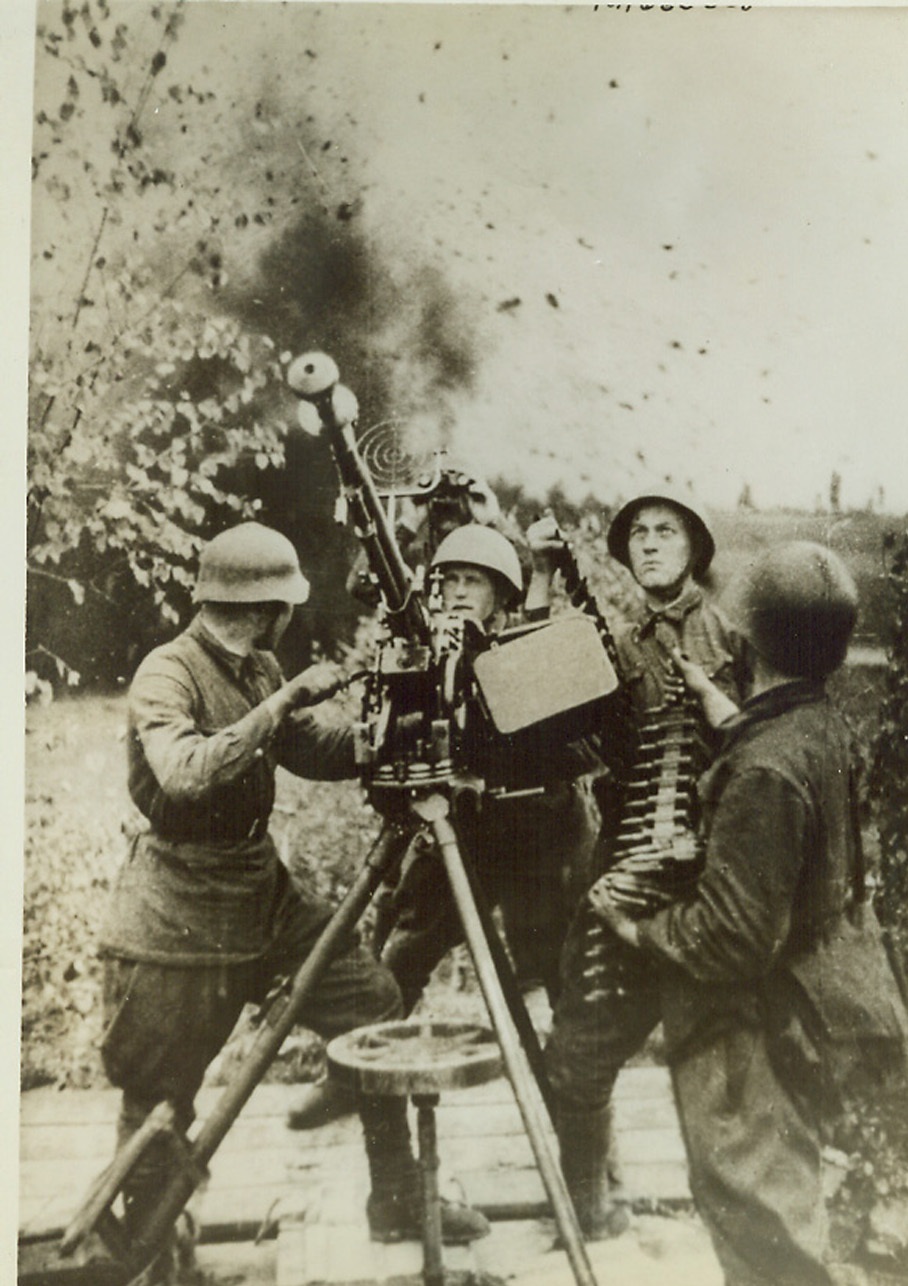
Soviet Ack-Ack Blast Nazi Bombers, 10/2/1942. Somewhere in Russia—A Red anti-aircraft crew keeps their aerial machine gun trained on German bombers that are attempting to blast the German battery. The Red crewman at the left appears to be gazing at a near Nazi bomb miss behind the group, while his companions’ attention is focused on the sky. Credit: ACME.;
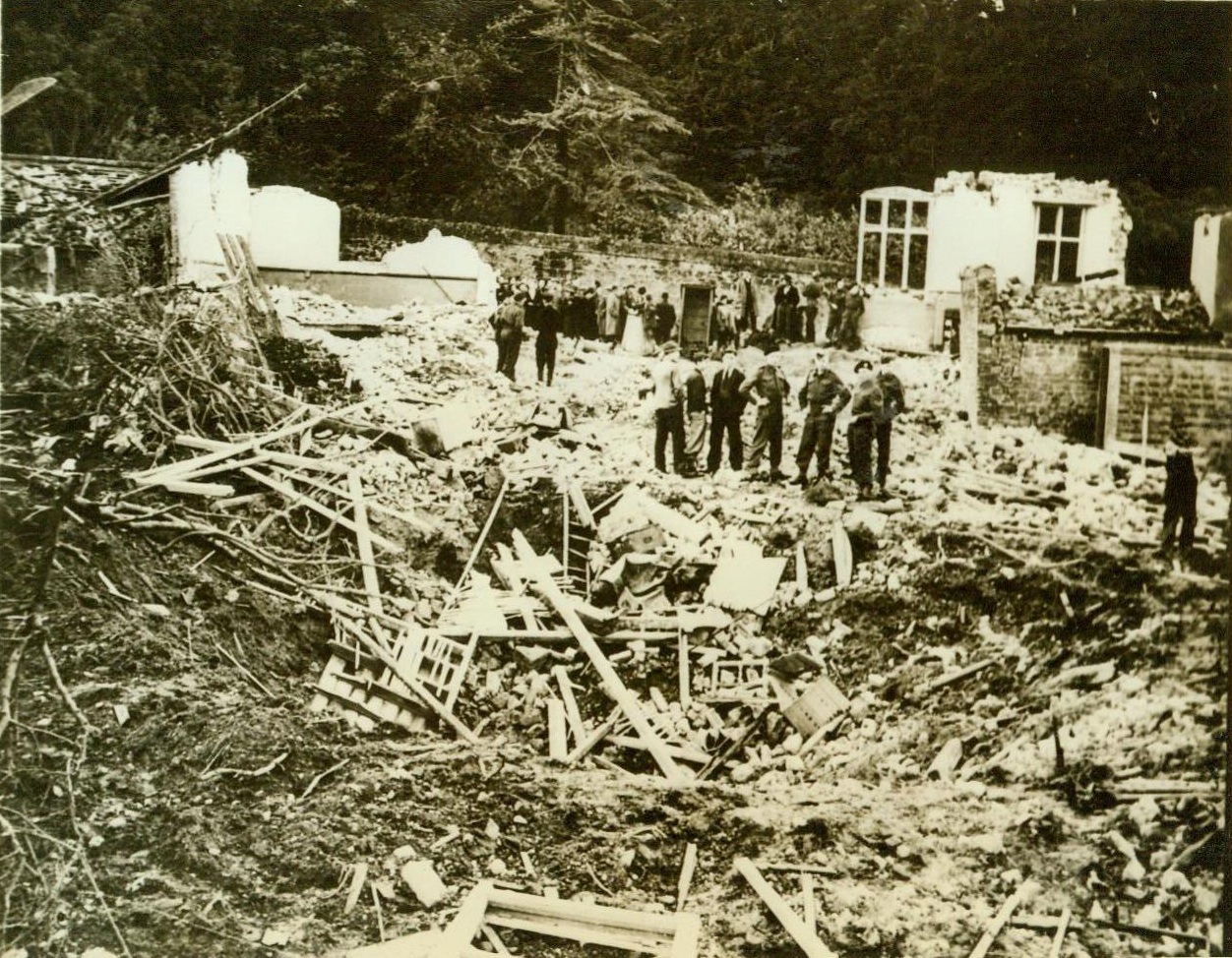
Death in the afternoon, 10/9/1942. ENGLAND – On Tuesday morning, Sept. 29th, this was a peaceful grade school in southern England. In the afternoon it became a slaughterhouse for its 74 young boys, as a lone Junkers 88 swept over it at stonesthrow height to kill 23 of the students. 34 were injured and 8 are missing. The headmaster, a teacher, and an organist were also killed, as well as four women in an adjacent laundr. CREDIT LINE (ACME) 10/9/42;

Eighteen officers and six sergeants, 10/8/1942. Eighteen officers and six sergeants of the U.S. Ranger troops wait for the command to move down the theoretically sniper-infested “course.” At the military equivalent of the word “Go,” the special detachment will practice house-to-house invasion tactics, blasting the enemy and taking the specialized inch-by-inch offensive. CREDIT LINE (ACME) 10/8/42;
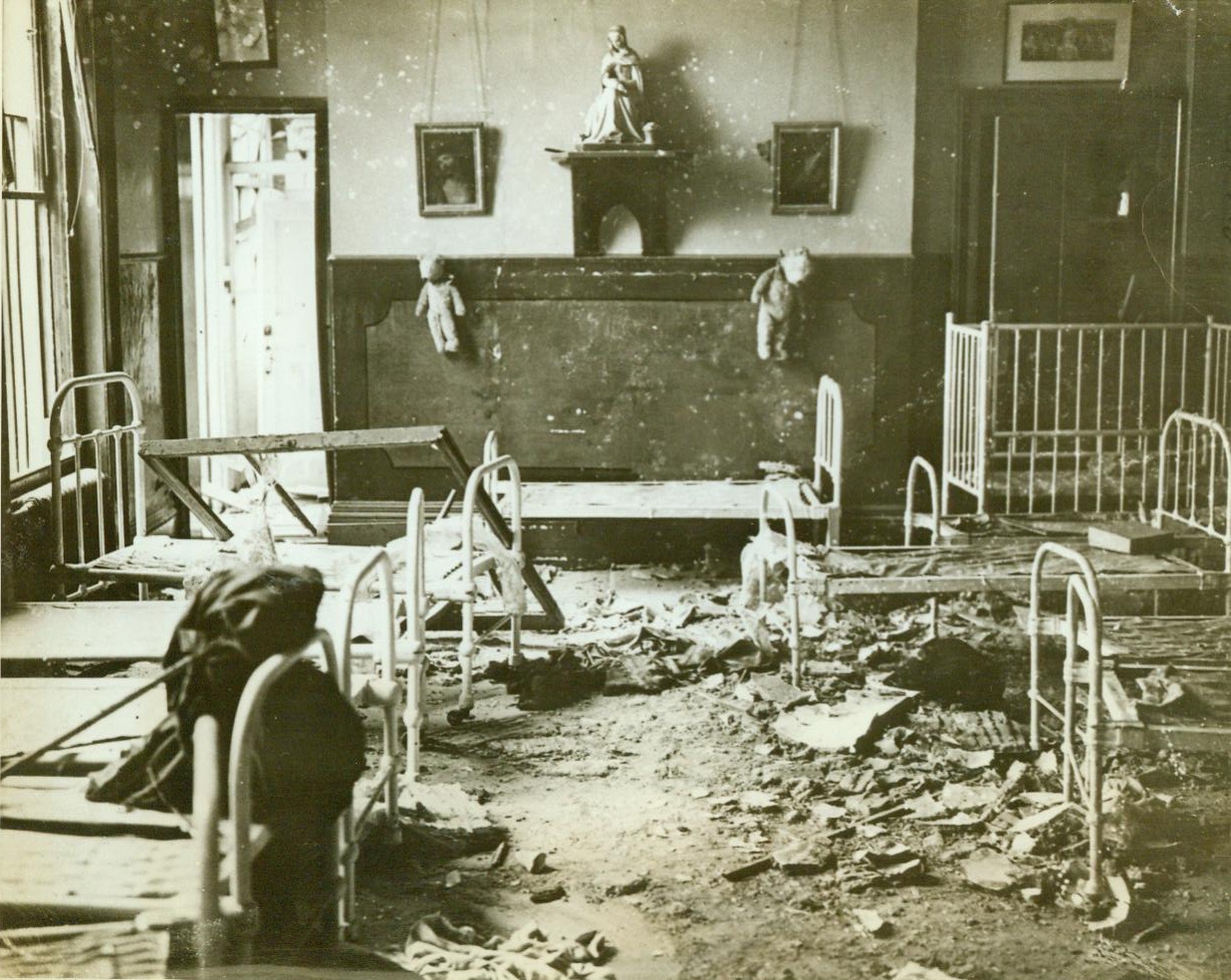
Crippled children’s home bombed, 10/21/1942. ENGLAND – One child was killed and five others injured when three Nazi sky raiders gunned and bombed a south coast convent and surrounding streets. Here are debris-covered cots in the dormitory of the convent that housed forty crippled children. Nuns braved the fire to carry them to safety in underground vaults. CREDIT LINE (ACME) 10/21/42;
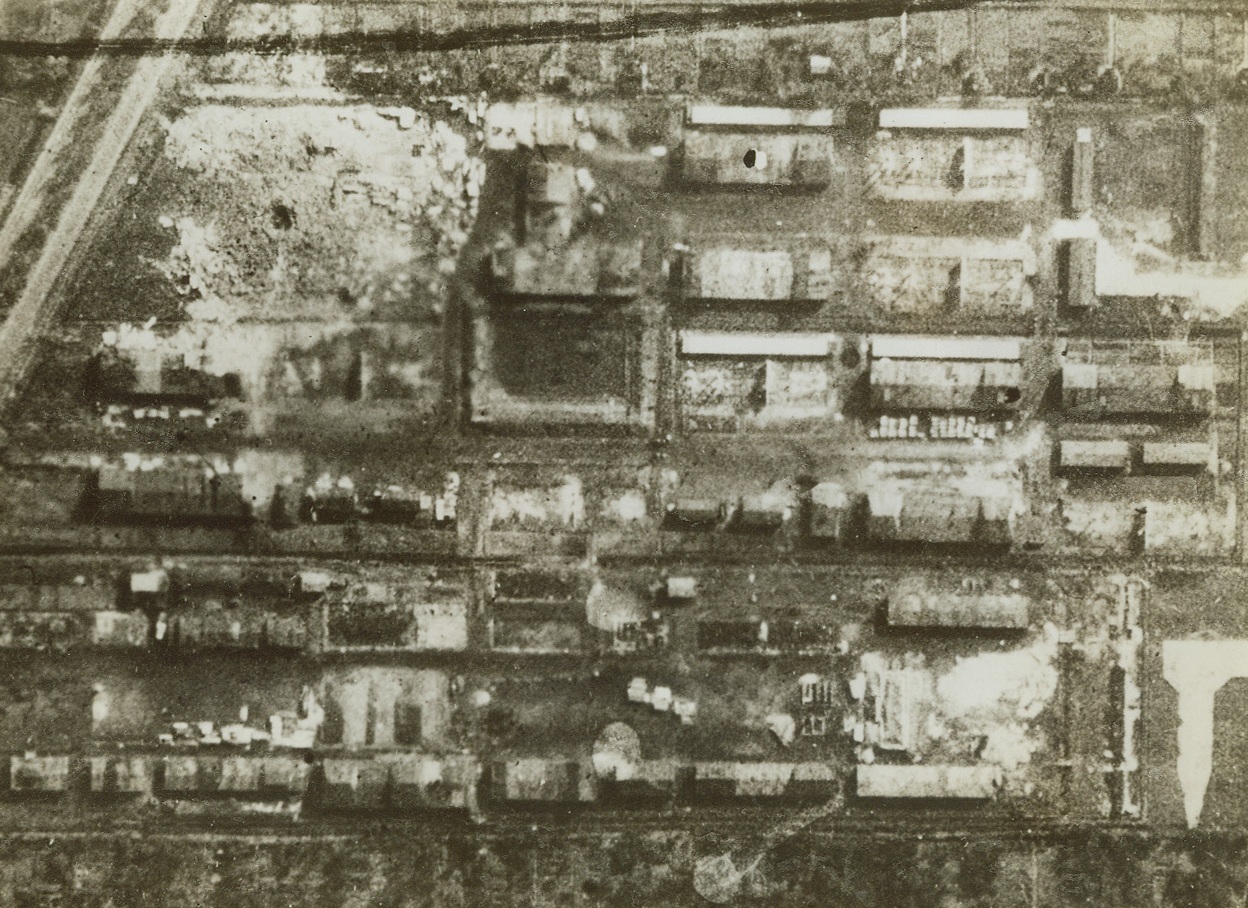
Focke-Wulf Works Blasted by R.A.F., 10/25/1942. London—A third of the 10-acre area covered by the Focke-Wulf aircraft works at Neuenland, near Bremen, was shattered by high explosives and R.A.F. bomb-ignited fires. The September 13 raid destroyed eighteen sheds, some of which measured 140-45 feet. The R.A.F. reconnaissance photo clearly indicates that British bombs hit their night-raid targets. (See photo PLA 665761). Credit: ACME.;
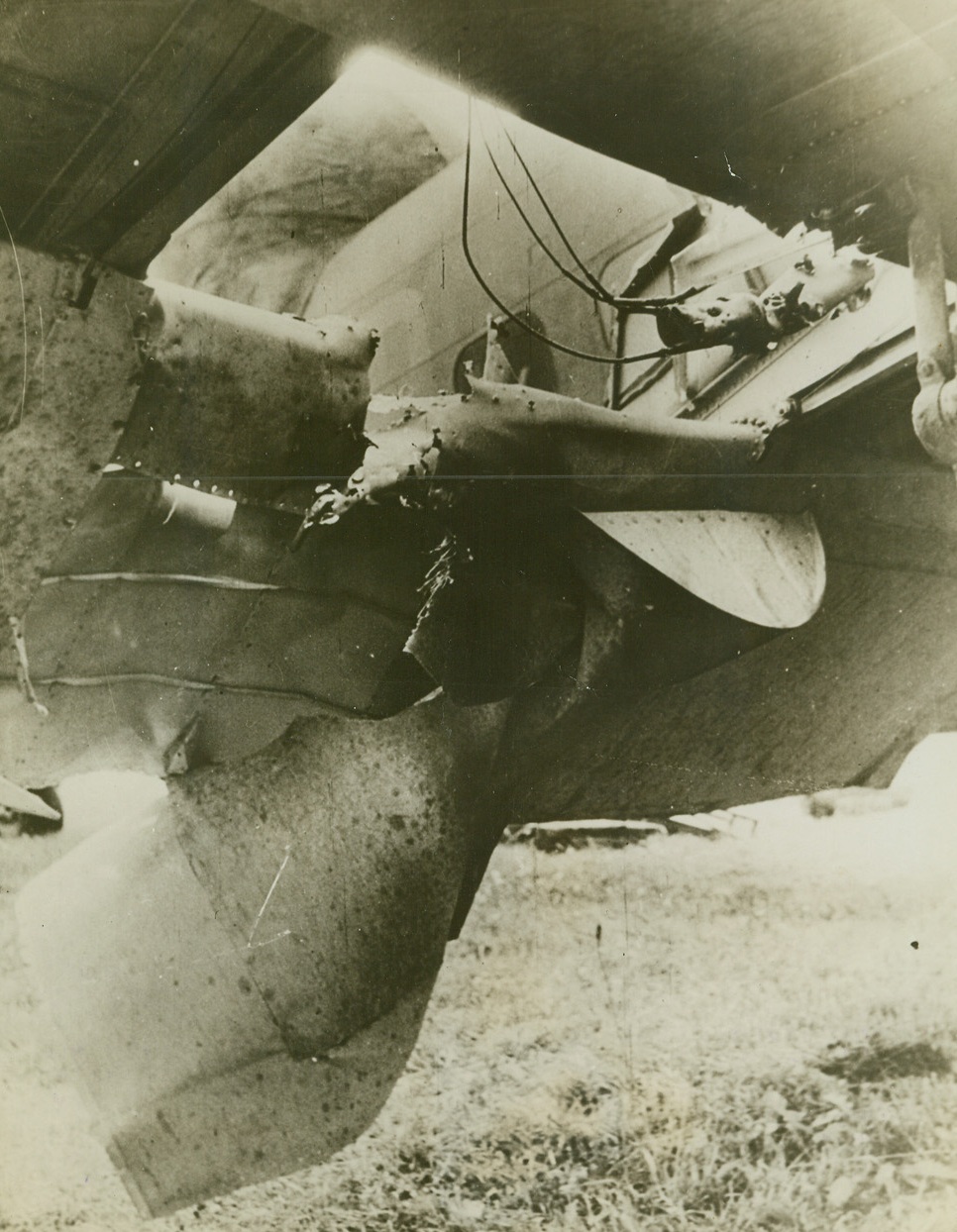
R.A.F. Bomber Flew Home With Hole in Wing, 10/4/1942. England—This gaping hole was torn in the wing of a Hudson Coastal Command bomber by a medium size shell while attaching a German convoy that was creeping in at night up the Dutch coast with supplies for Nazis on the German front. No one was wounded and despite the damage, the pilot brought the ship home safely. (Passed by censors). Credit: ACME.;
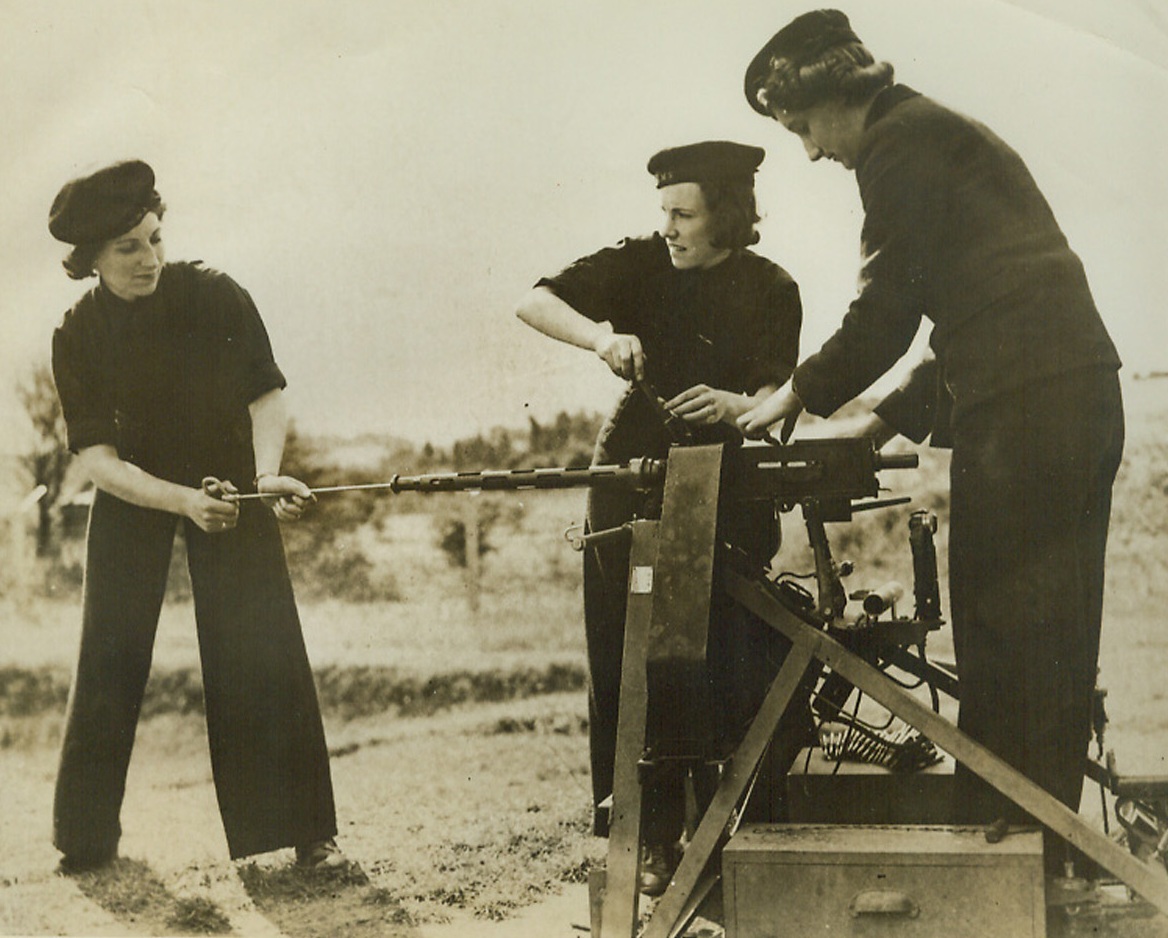
Wrens Service Machine Guns, 10/3/1942. England—Members of the Women’s Royal Naval Service, which operates with the Fleet Air Arm, clean a Browning machine gun at a Royal Naval Air Station in the south of England. Highly skilled, they work on radio equipment and service guns. (Passed by censor). Credit: ACME.;
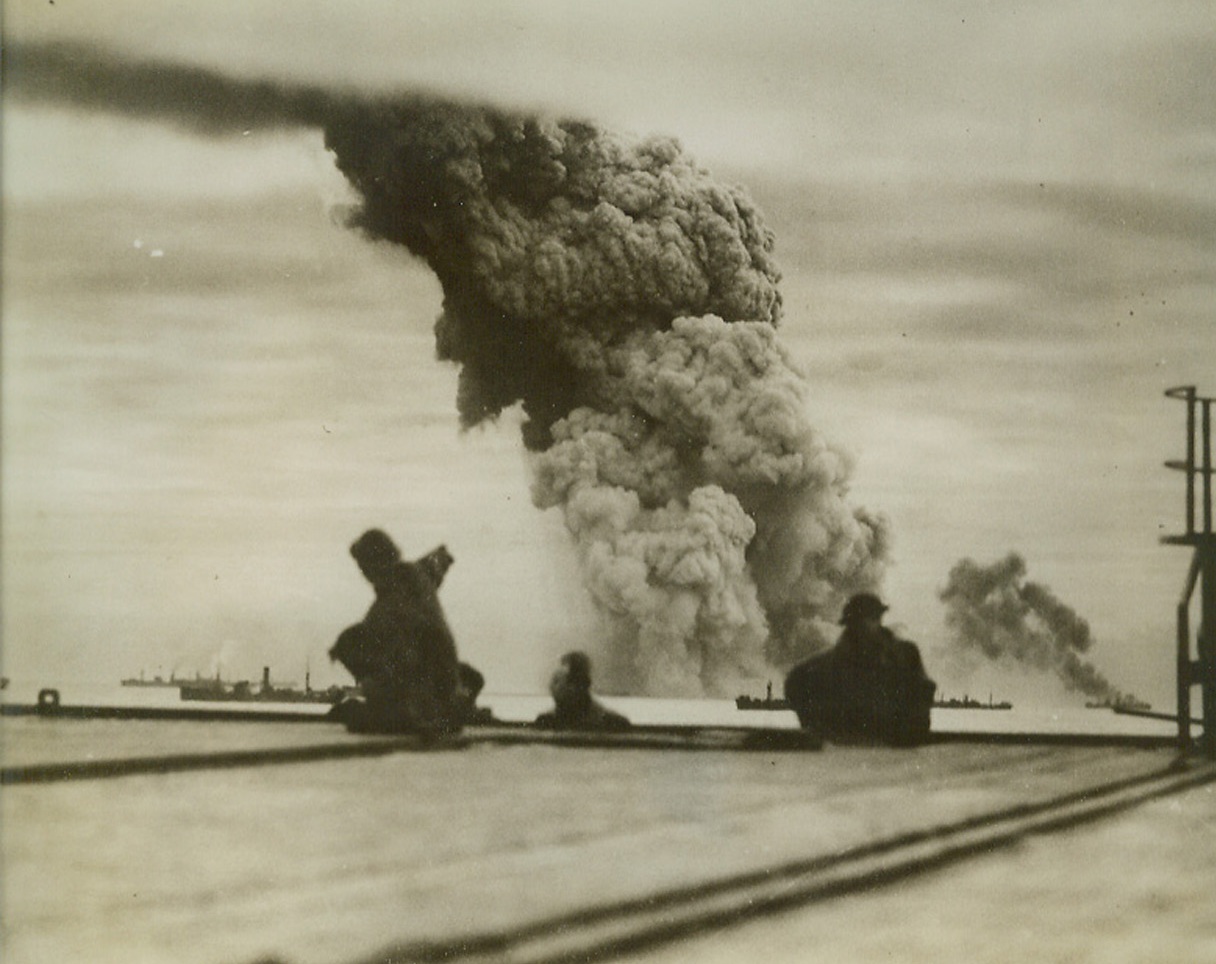
Wrens Service Machine Guns, 10/3/1942. England—Members of the Women’s Royal Naval Service, which operates with the Fleet Air Arm, clean a Browning machine gun at a Royal Naval Air Station in the south of England. Highly skilled, they work on radio equipment and service guns. (Passed by censor). Credit: ACME.;
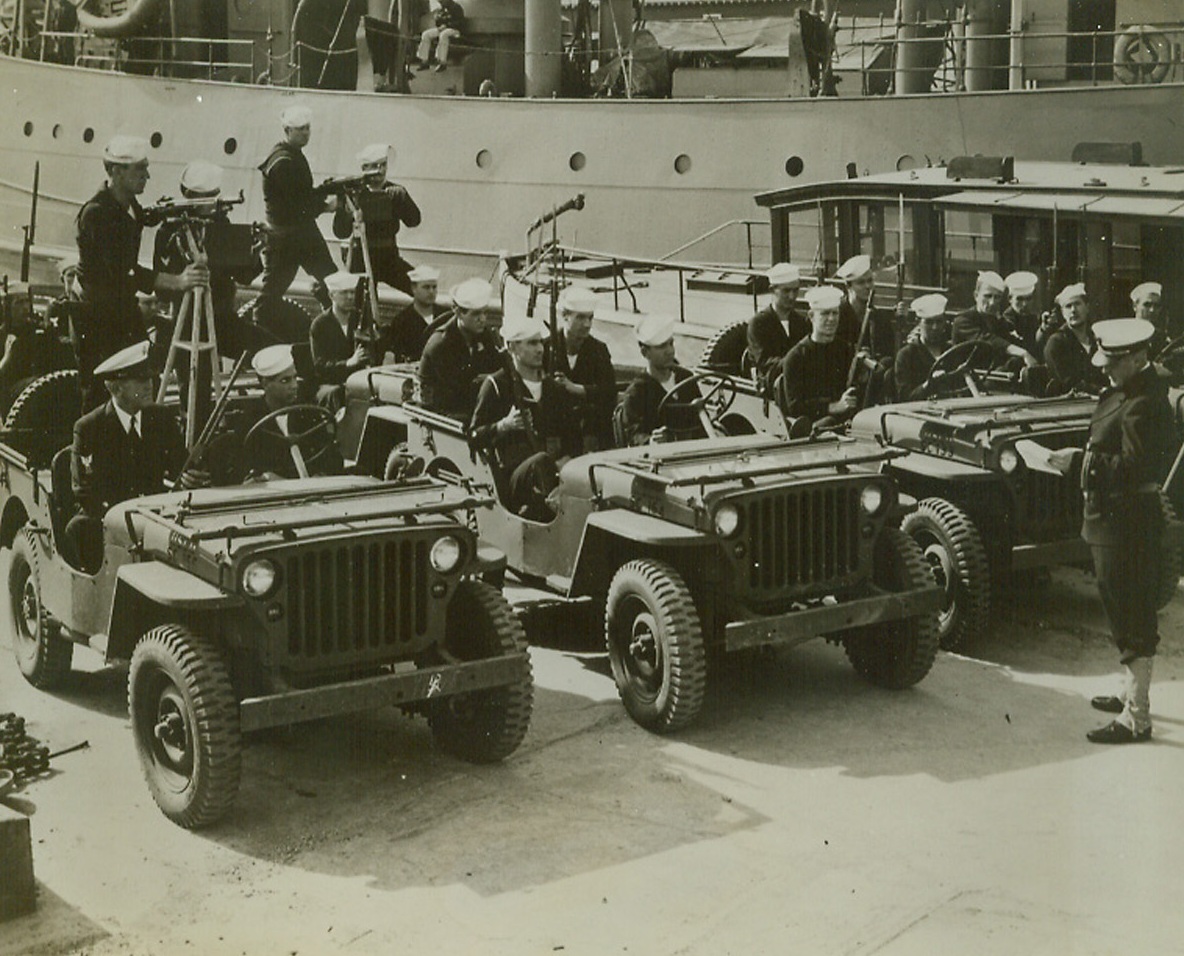
Anti-Saboteur Patrol, 10/20/1942. An East Coast Port—Vital cargoes of war supplies for America’s far flung battle lines must be protected on the docks as well as at sea. Here, Coast guardsmen of the anti-saboteur patrol receive their orders at “An East Coast Port” before starting out on patrol.Credit: U.S. Coast Guard photo from ACME.;
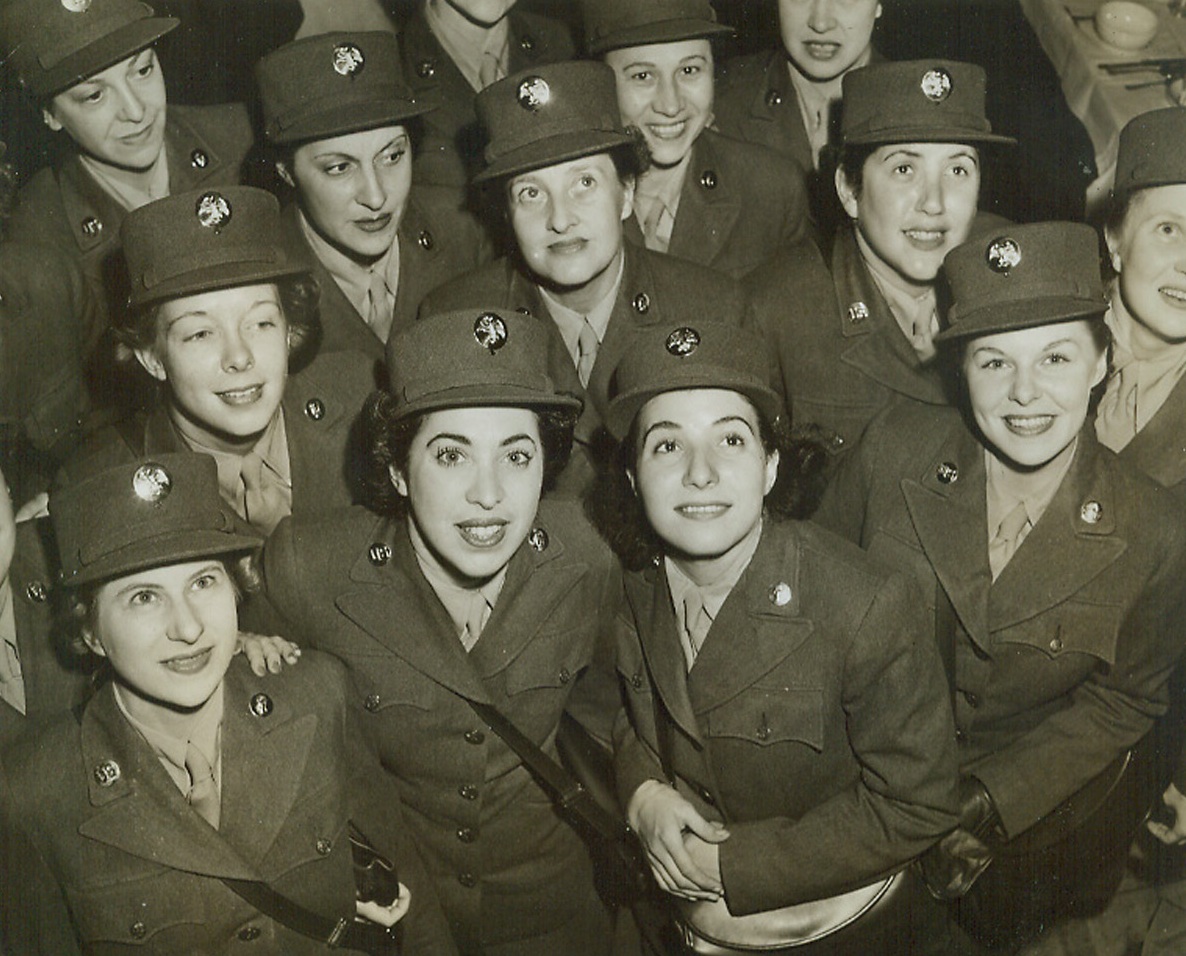
The WAACS Are Back, 10/16/1942. New York—Fresh out of Des Moines, the first contingent of war-trained WAACS hit New York City today. Trim in their caps and uniforms, about 100 military misses stepped forth in Grand Central Station, and gaily sang camp songs in the new Army Induction Center in the Grand Central Palace Building.Credit: ACME.;
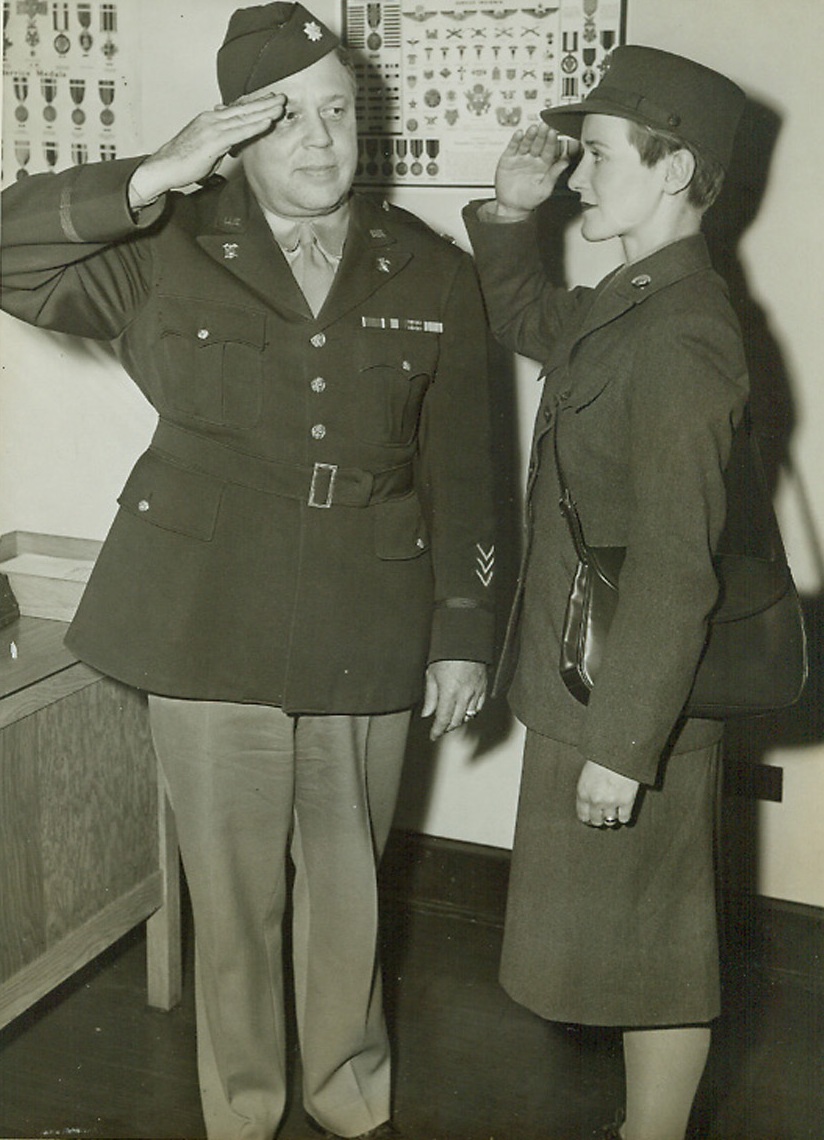
Hy, Pops!, 10/20/1942. Chicago—That may not be the way for a private to address a colonel, but that’s what miss Elizabeth Gage, a WAAC home from Fort Des Moines, Iowa, on furlough, said as she saluted her father Lt. Col. John Gage, executive officer of the Chicago Quartermaster Depot.Credit: ACME.;
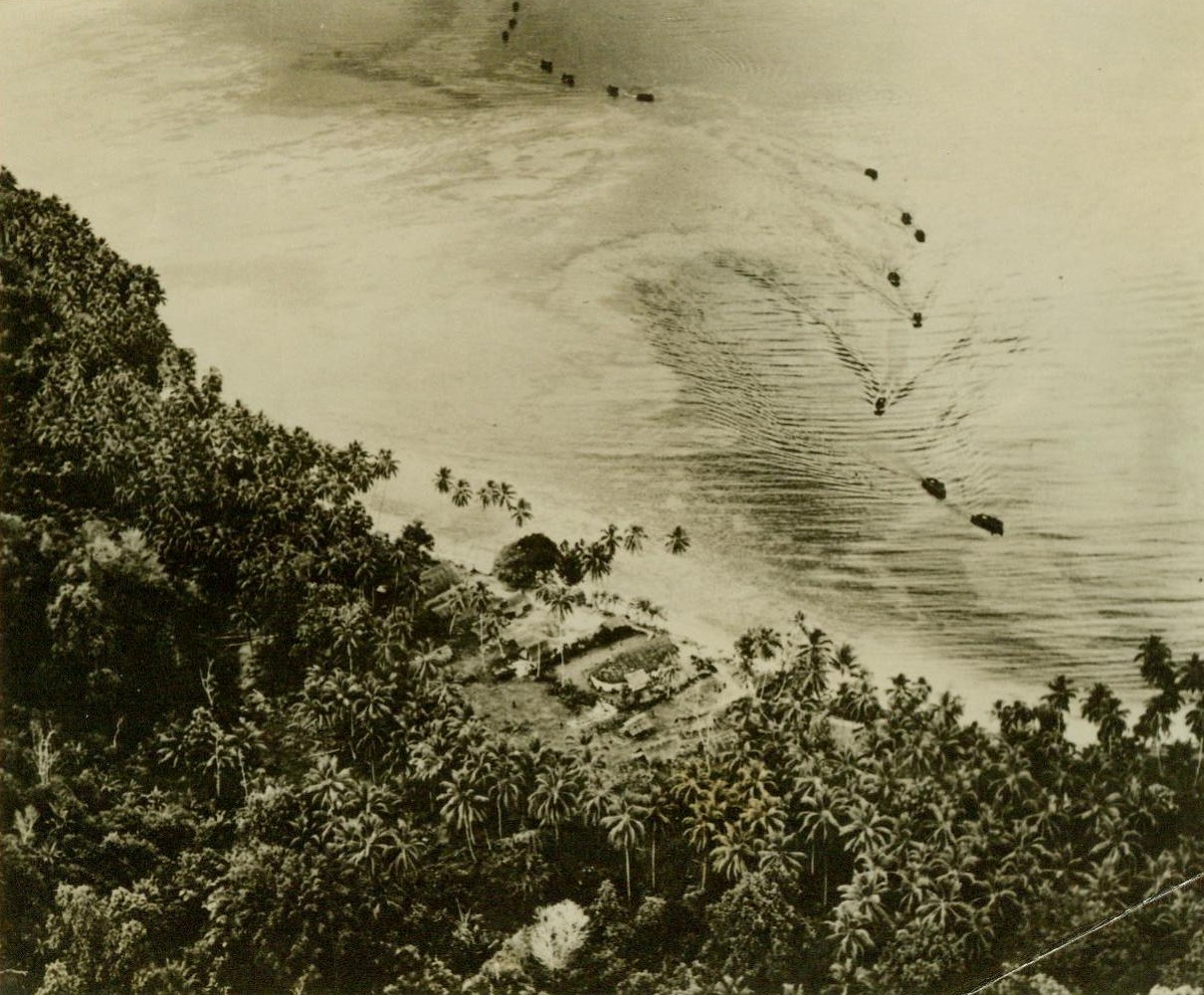
How the Marines landed, 10/17/1942. SOLOMON ISLANDS – Troop-carrying barges zig zag up to the beach of Florida Island to land the U.S. Marines in the initial stages of the Solomon Battle. The Marines occupied vital areas on both Florida and Guadalcanal and are now encountering heavy Jap attacks for the possession of the important Lunga Airport on Guadalcanal. CREDIT (Official US Navy photo from ACME) 10/17/42;
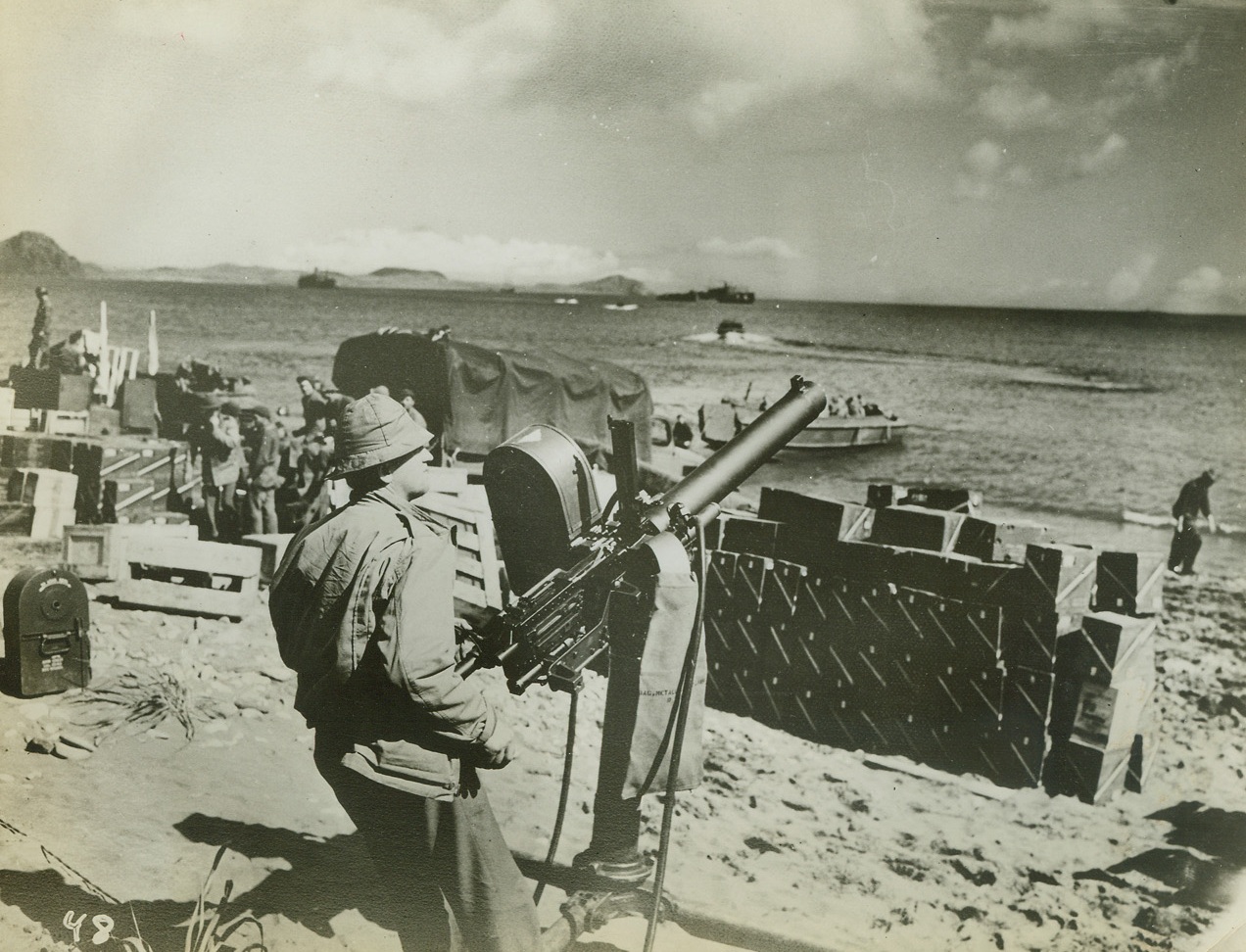
American Troops Land in the Aleutian Islands, 10/3/1942. Washington, D.C.—United States Army troops with Navy support have occupied the Andreanof Island group in the Aleutians, only 125 miles east of the Jap held Kiska it was announced by the Navy. Photo shows: a 50-caliber machine gun keeps a section of the beach well-guarded. The ammunition boxes in the background were removed shortly after this photo was taken.Credit: U.S. Signal Corps photo from ACME.;
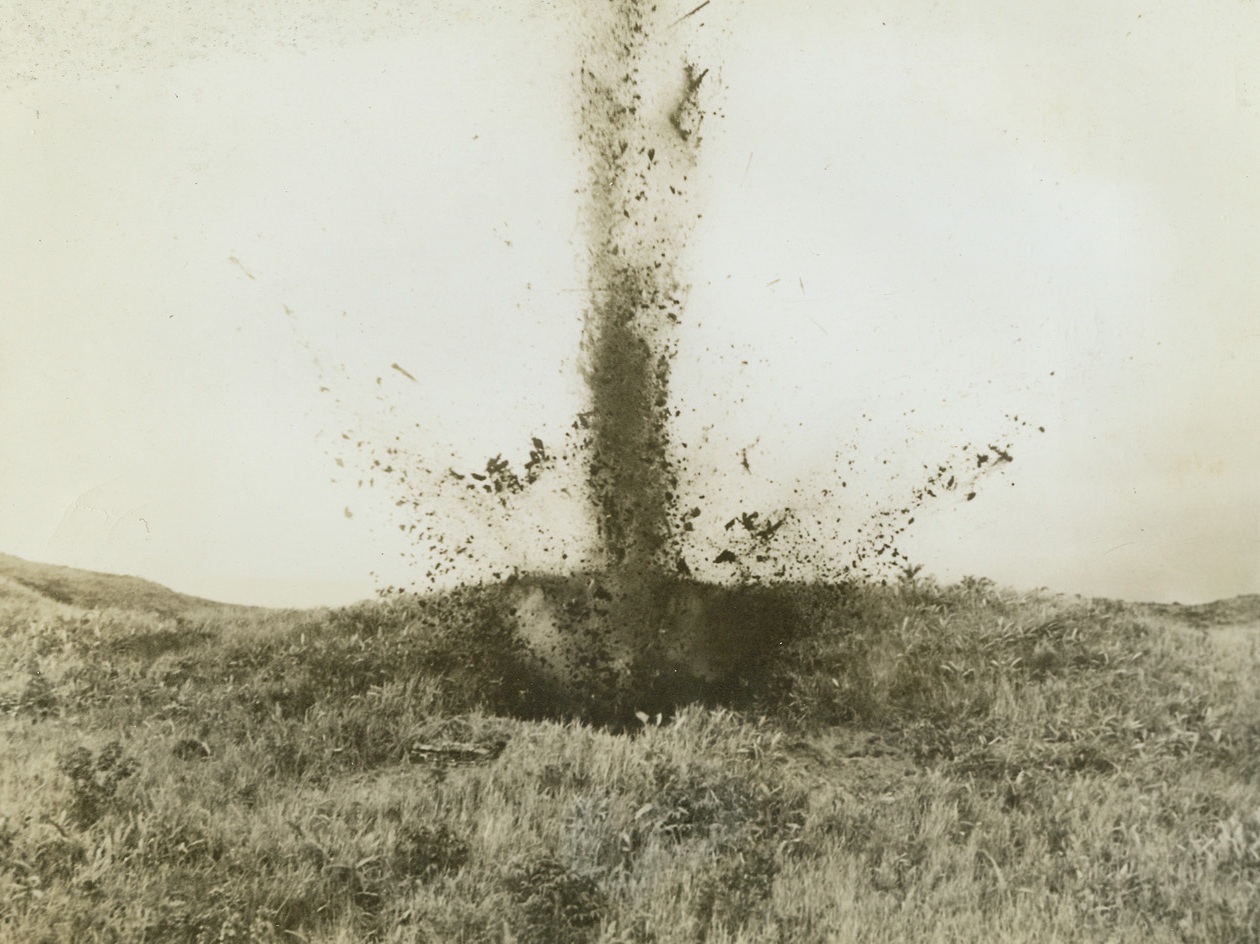
Fighting Engineers Blast Pillbox, 10/7/1942.
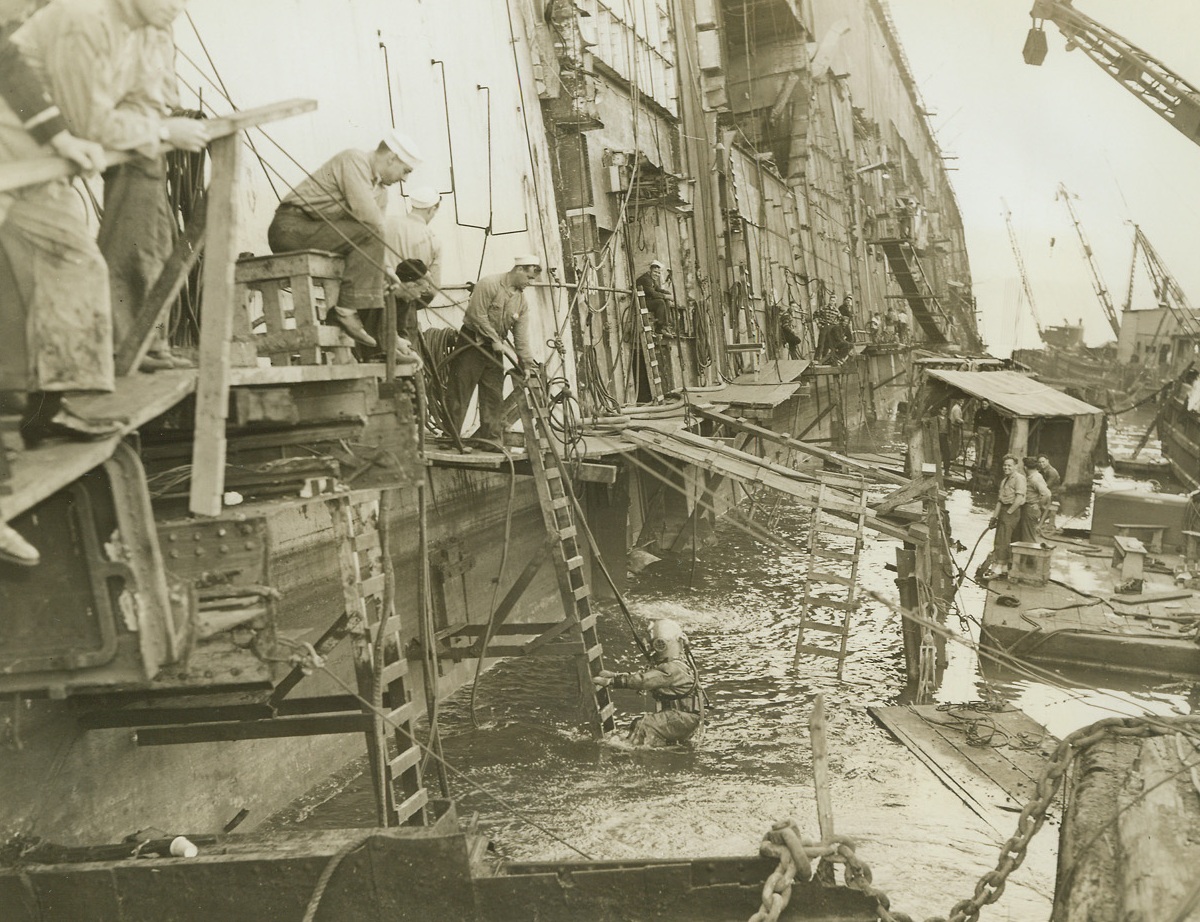
No Title. 10/9/1942. Many men are at work along the catwalk of the S.S. Lafayette, as a diver comes to the surface and is aided up a ladder to the walk. Cranes, rafts, and a maze of temporary structures surround the grey ship’s hulk.Credit: ACME.;
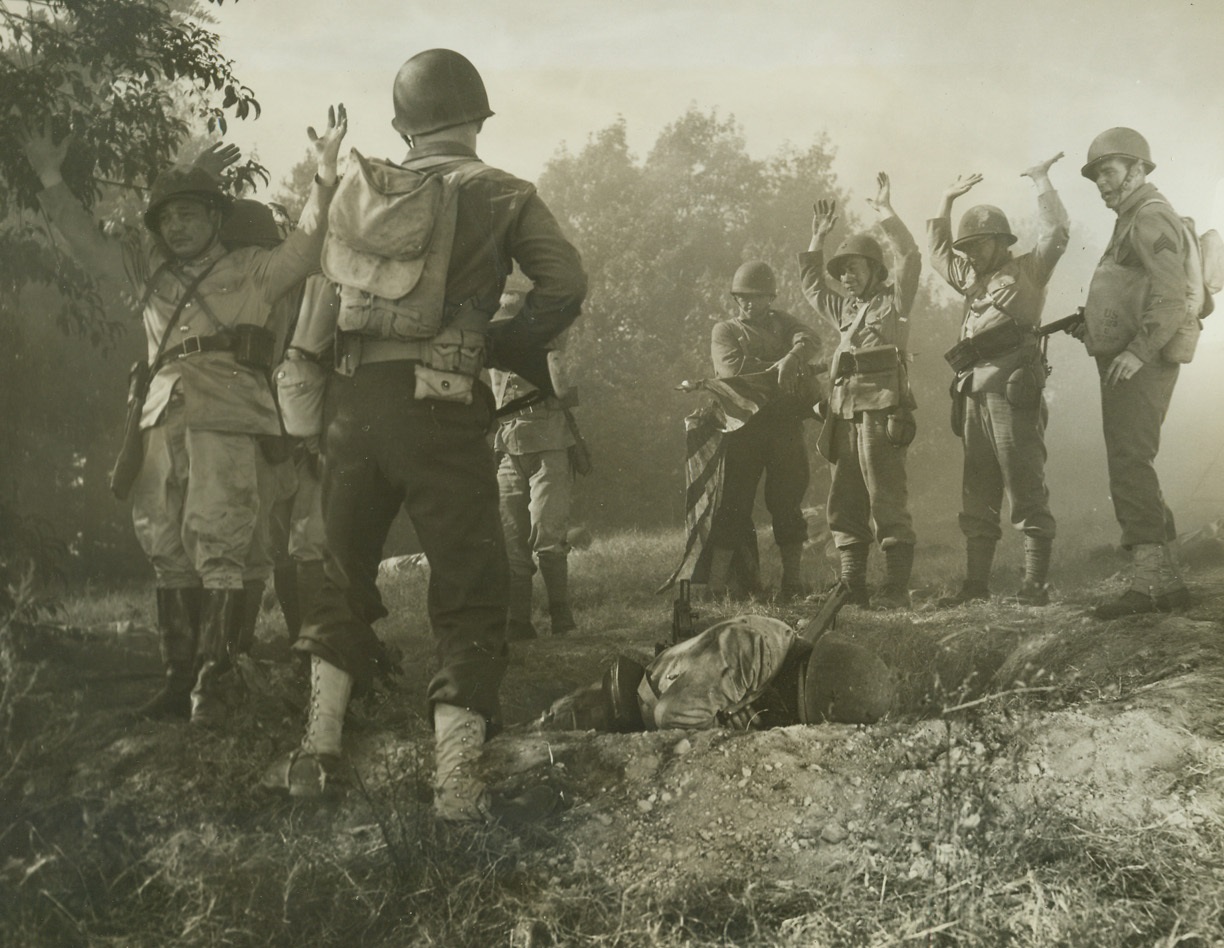
Yanks Get Taste of “The Big Show”, 10/12/1942. Fort Belvoir – Soldiers at Fort Belvoir got a taste of what’s ahead of them when Warner Bros. staged a battle there for the forthcoming government picture “The Fighting Engineers.” As Japanese, to play the part of Jap soldiers in the film, were a bit scarce in the neighborhood, 50 Filipinos were brought in to play the parts of the “enemy.” So realistic were the battle scenes and so well were the “Japs” made up that the U.S. soldiers had to be cautioned continually to go easy with their bayonets. To make it ever more realistic, battle scenes were staged in a section of Fort Belvoir that closely resembles the terrain of the Solomon Islands. The U.S. soldiers, of course, were the victors in the movie. Here, a series of photos taken during the filming is presented. New York Bureau The “battle” is over and some of the retreating “Japs” have been rounded up and brought back to watch the U.S. soldiers tear the Japanese flag from its standard. Credit: ACM;

Yanks Get Taste of “The Big Show”, 10/12/1942. Fort Belvoir – Soldiers at Fort Belvoir got a taste of what’s ahead of them when Warner Bros. staged a battle there for the forthcoming government picture “The Fighting Engineers.” As Japanese, to play the part of Jap soldiers in the film, were a bit scarce in the neighborhood, 50 Filipinos were brought in to play the parts of the “enemy.” So realistic were the battle scenes and so well were the “Japs” made up that the U.S. soldiers had to be cautioned continually to go easy with their bayonets. To make it ever more realistic, battle scenes were staged in a section of Fort Belvoir that closely resembles the terrain of the Solomon Islands. The U.S. soldiers, of course, were the victors in the movie. Here, a series of photos taken during the filming is presented. New York Bureau After violent fighting in one scene, the U.S. engineers storm up a hill and rout the “Japs.” Here, they are shown stepping past those “slain” in battle, in strong pursuit of fleeing “Japs.” Credit: ACM;
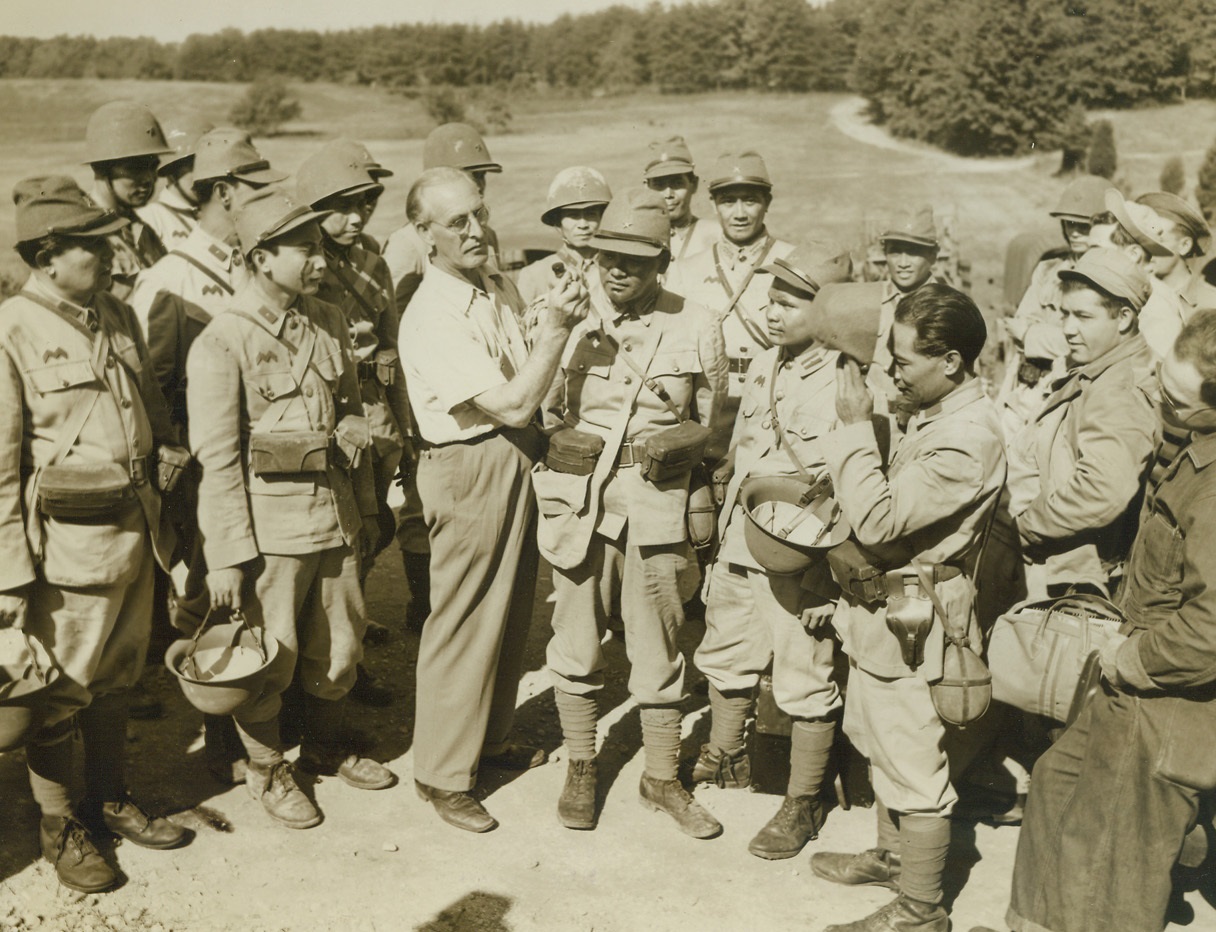
Yanks Get Taste of “The Big Show”, 10/12/1942. Fort Belvoir – Soldiers at Fort Belvoir got a taste of what’s ahead of them when Warner Bros. staged a battle there for the forthcoming government picture “The Fighting Engineers.” As Japanese, to play the part of Jap soldiers in the film, were a bit scarce in the neighborhood, 50 Filipinos were brought in to play the parts of the “enemy.” So realistic were the battle scenes and so well were the “Japs” made up that the U.S. soldiers had to be cautioned continually to go easy with their bayonets. To make it ever more realistic, battle scenes were staged in a section of Fort Belvoir that closely resembles the terrain of the Solomon Islands. The U.S. soldiers, of course, were the victors in the movie. Here, a series of photos taken during the filming is presented. New York Bureau Filipinos are made up for their roles as Jap soldiers. They are equipped with authentic Japanese uniforms and insignia and “wounds” are applied by a makeup man to make the scenes more realistic. Credit: ACM;

Canadian Paratroopers Train at U.S. School, 10/12/1942. Fort Benning, Georgia – Canadians, who will form the nucleus of the first paratroop unit in the Canadian army, are now in training in the U.S. Army school at Fort Benning. The men will serve as instructors in the school at Camp Shilo, Manitoba, Canada, as soon as they have finished the course here. In this photo, Canadian paratroopers float toward the ground after bailing out of huge transport planes. Credit: ACME;
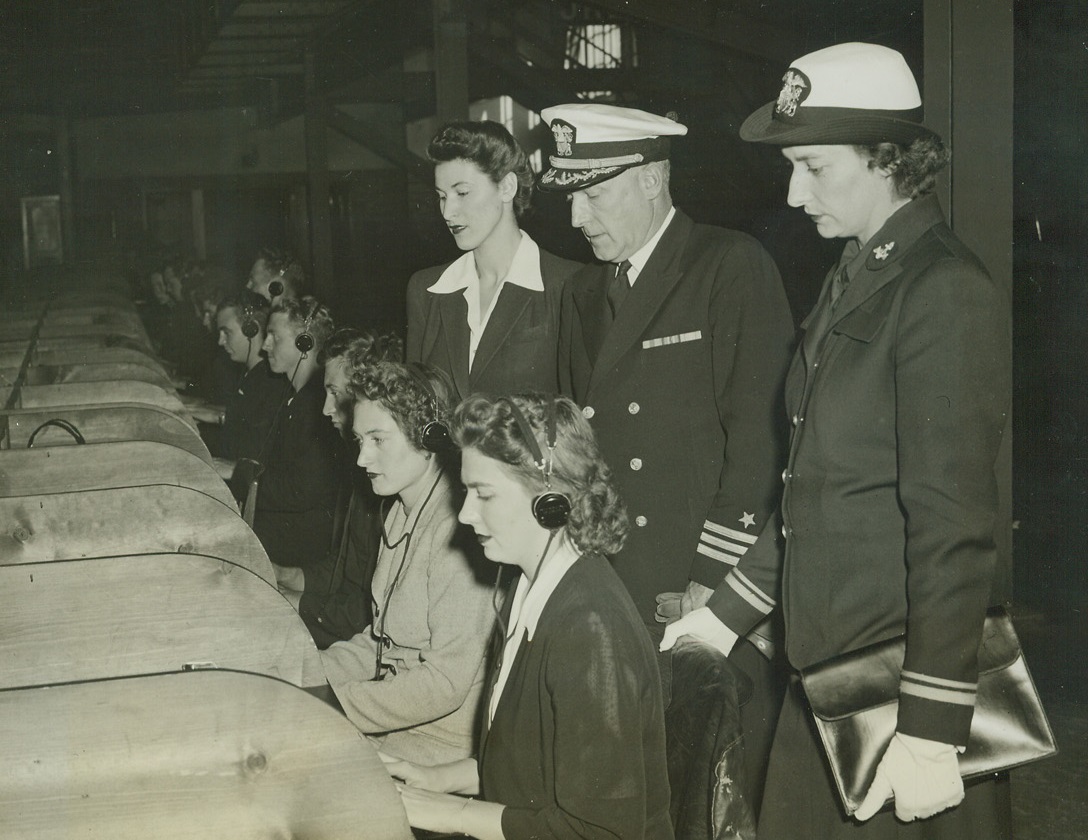
Noncommissioned WAVES Go Into Training, 10/11/1942. Madison, Wisc. – Comm. Charles P. Greene, U.S.N., former Assistant Chief of Staff of the 5th Naval District, Norfolk, Va., and new Commanding Officer of Naval Training Schools at the University of Wisconsin, Madison, Wisc., watching the first of 480 noncommissioned WAVES try their hands at typewriters and earphones in the radio classroom, where they will get a three-month course in radio communication. Left to right, standing: Miss Betty Kam, Clasonpoint, N.Y., a recruit; Commander Greene; Lt. Jenny Turnbull, Washington, D.C. Seated: Miss Jeanne Grey, Oakland, Calf.; Miss Lollie Catts, St. Louis, Mo. Credit: ACME;

Shell Tears Hole in R.A.F. Bomber, 10/4/1942. England – The pilot and two crew members stand in the hold torn by a Nazi shell in the starboard wing of their Hudson Bomber. The R.A.F. Coastal Command ship was hit while attacking an enemy convoy stealing up the Dutch coast at night with supplies for Nazis on the Russian front. Despite the damage the pilot brought the ship home safely. Passed by censor. Credit: ACME;
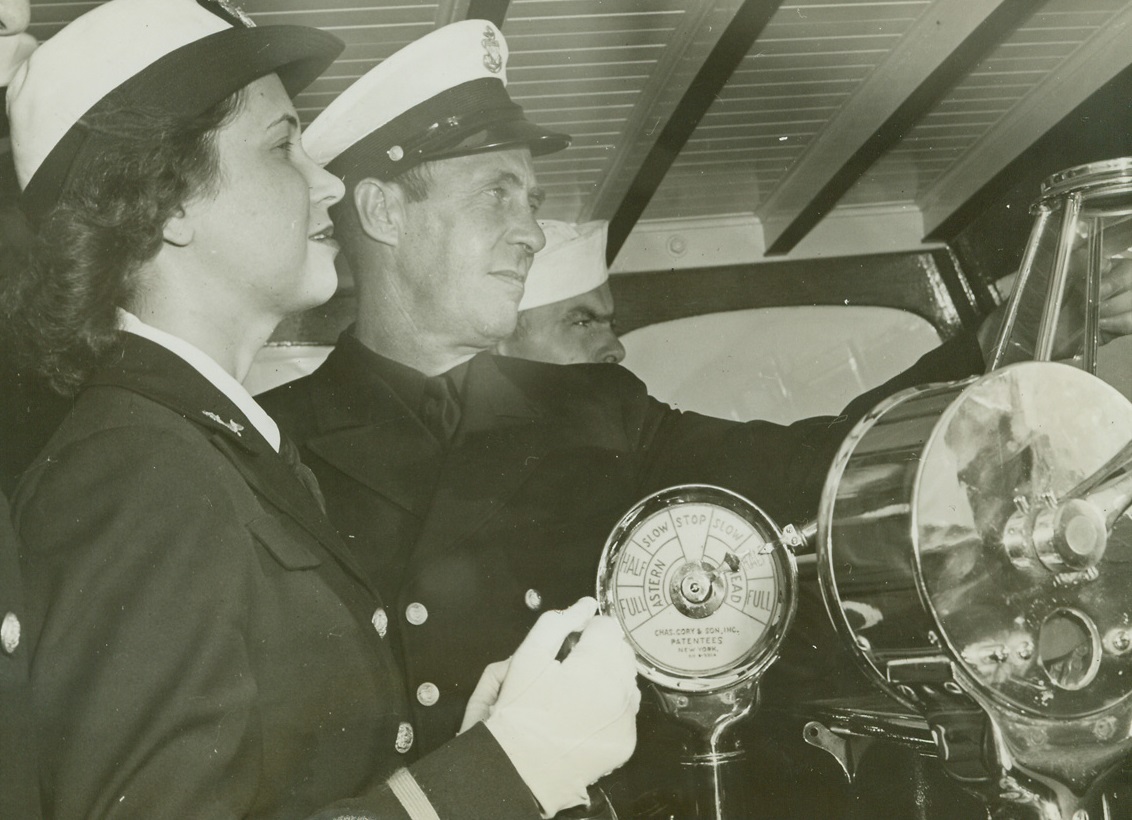
A Wave Goes to Sea, 10/6/1942. Chicago -- Ensign Elizabeth Landis, new WAVE officer and niece of Judge Kenesaw L. Landis, tries her hand at running a Coast Guard cutter on Lake Michigan off Chicago, under the watchful eye of Chief Boatswain’s Mate Gustave Peterson. Credit: ACME;
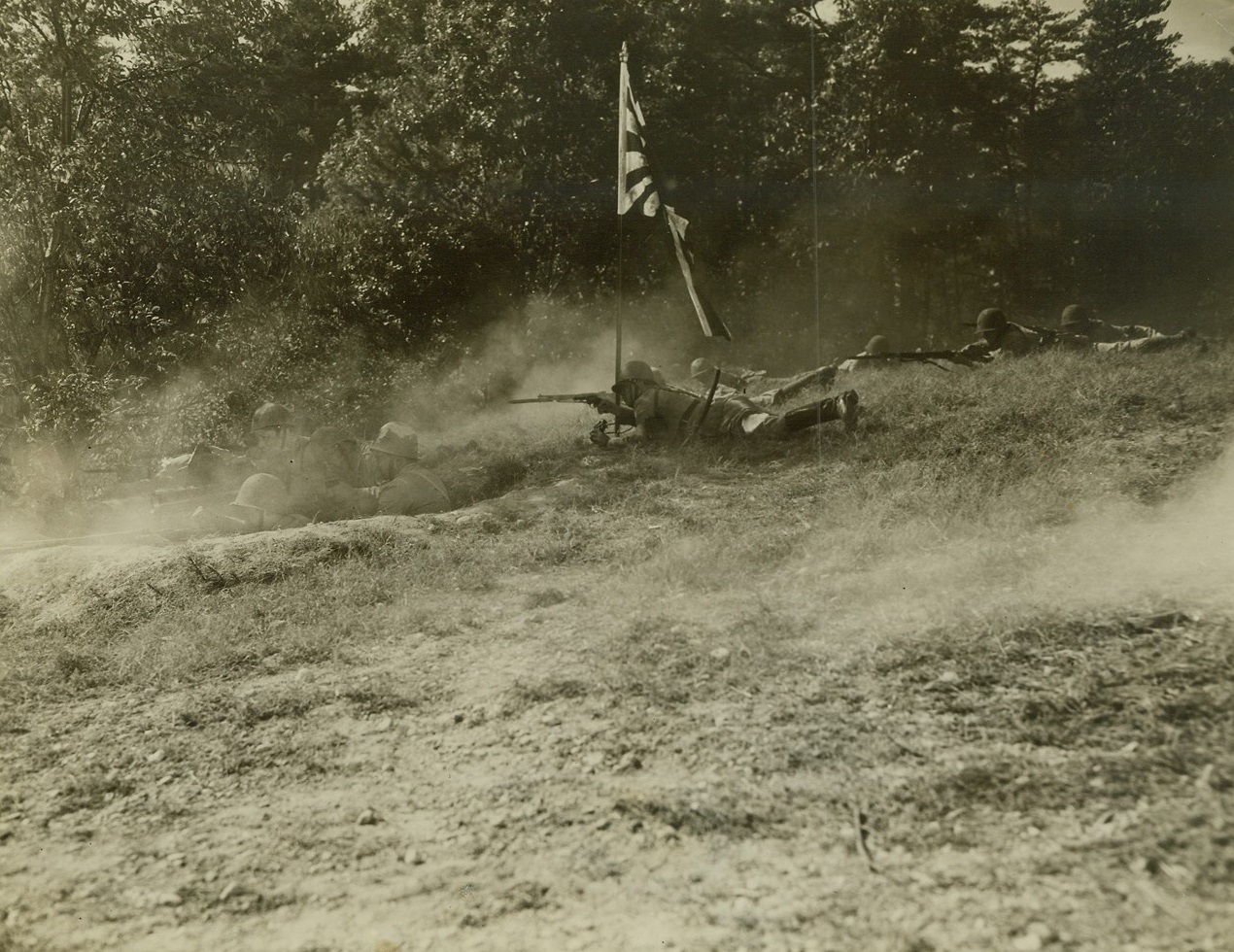
Yanks Get Taste of “The Big Show”, 10/12/1942. Fort Belvoir, Virginia -- Soldiers at Fort Belvoir got a taste of what’s ahead of them when Warner Bros. staged a battle scene for the forthcoming government picture “The Fighting Engineers.” As Japanese to play the part of Japs were a bit scarce in the neighborhood, 50 Filipinos were brought in to play the parts of the “enemy.” So realistic were the battle scenes that the U.S. soldiers had to be cautioned continually to go easy with their bayonets. To make it even more realistic, battle scenes were staged in a section of Fort Belvoir that closely resembles the terrain of the Solomon Islands. The U.S. soldiers were, of course, the victors in the movie. Here, a series of photos taken during the filming is presented. Passed by Army censors. New York Bureau The battle is on and “enemy” machine gunners train their weapon on the U.S. Engineers. A real Japanese machine gun was used in this scene. Several “takes” were ruined because it was continually jamming. Credit: ACM;
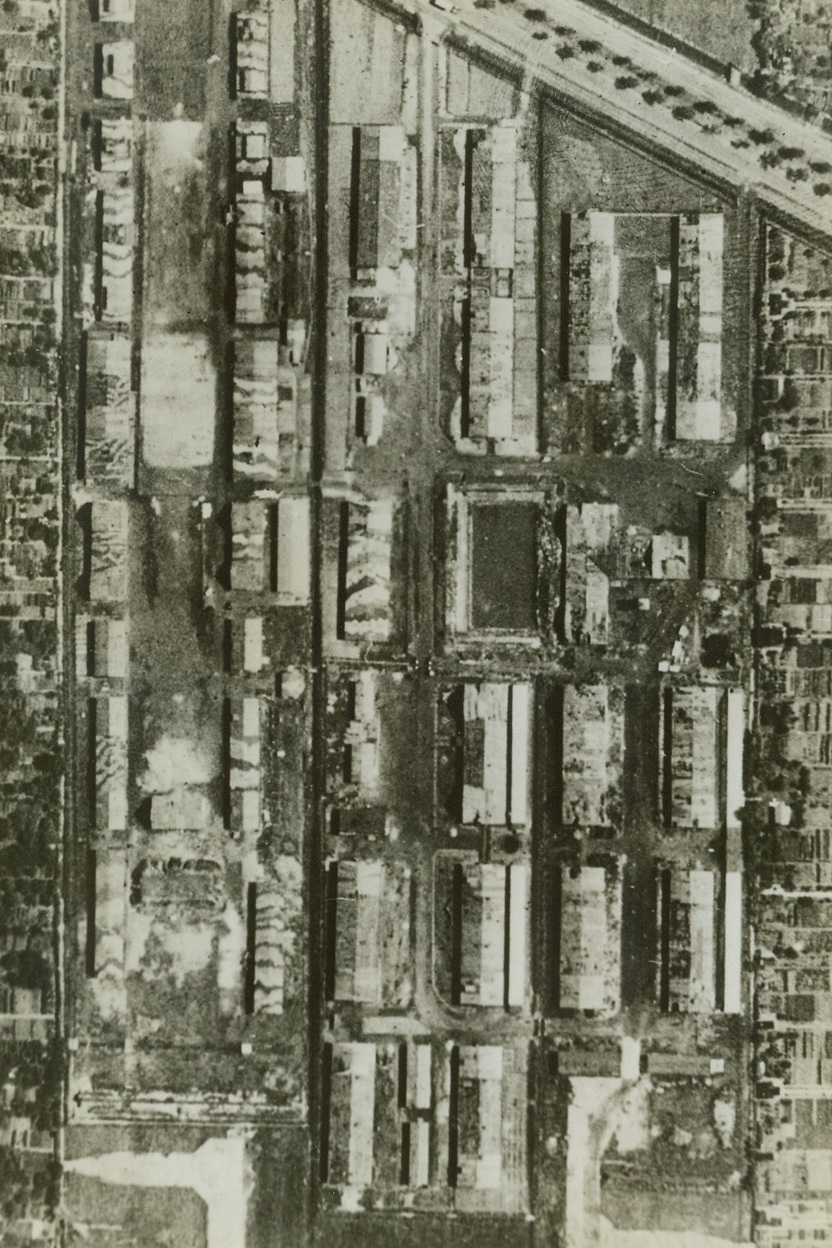
FOCKE-WULF WORKS BLASTED BY R.A.F….#1, 10/25/1942. LONDON – Before the R.A.F. attack on the Focke-Wulf works at Neu England near Bremen, photographic reconnaissance shows single storey sheds probably used to store materials. The September 13 bomber command raid caused extensive damage to the axis plane manufacturing center. Credit: Acme;
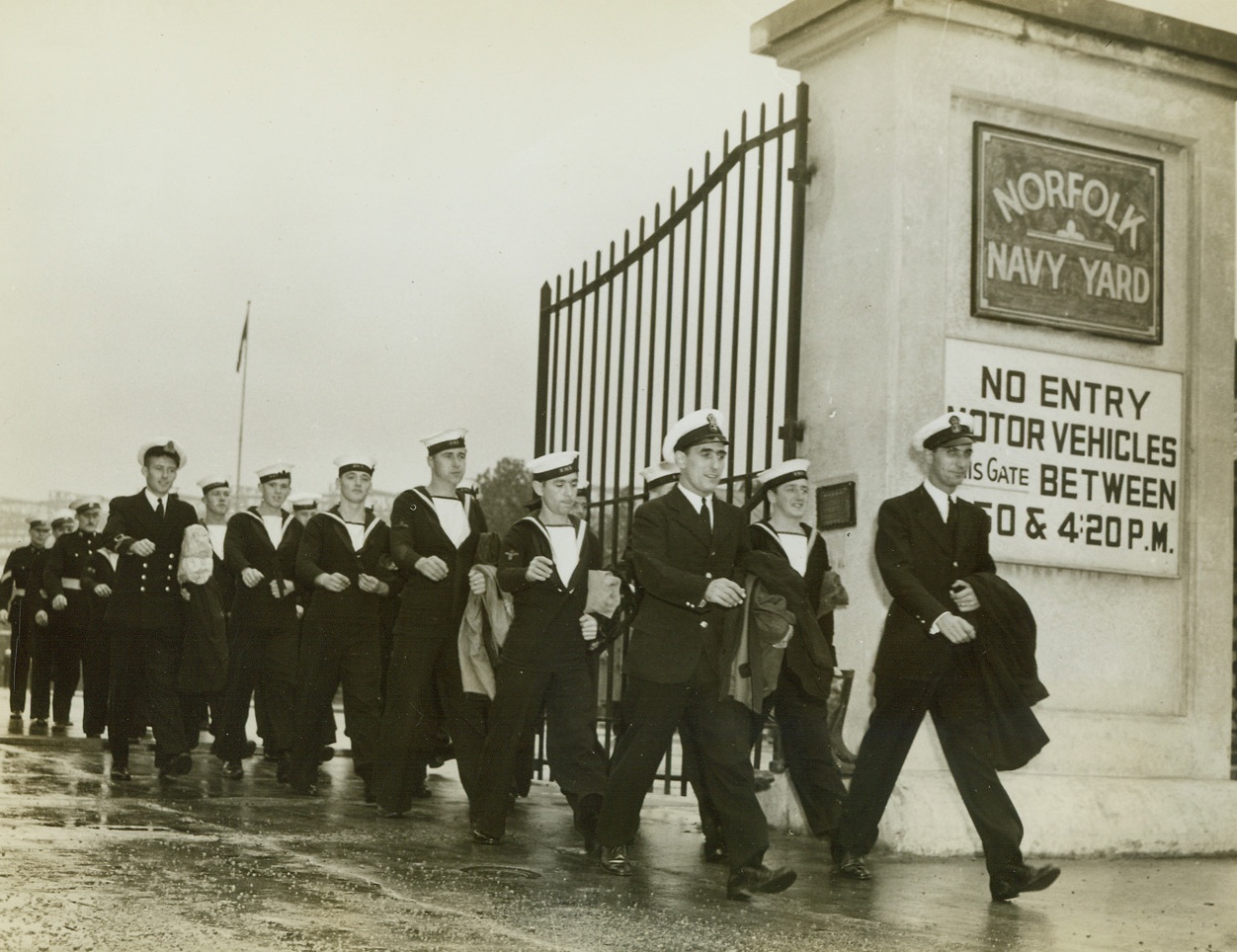
BRITISH SAILORS HARVEST AMERICAN CORPS, 10/23/1942. English sailors on leave from a British man o’war in a U.S. Navy Yard for refitting, lend a hand to Virginia truck and dairy farmers beset by a shortage of manpower. Here a group of sailors march from the Navy Yard en route to do their bit of farm work.Credit: Acme;
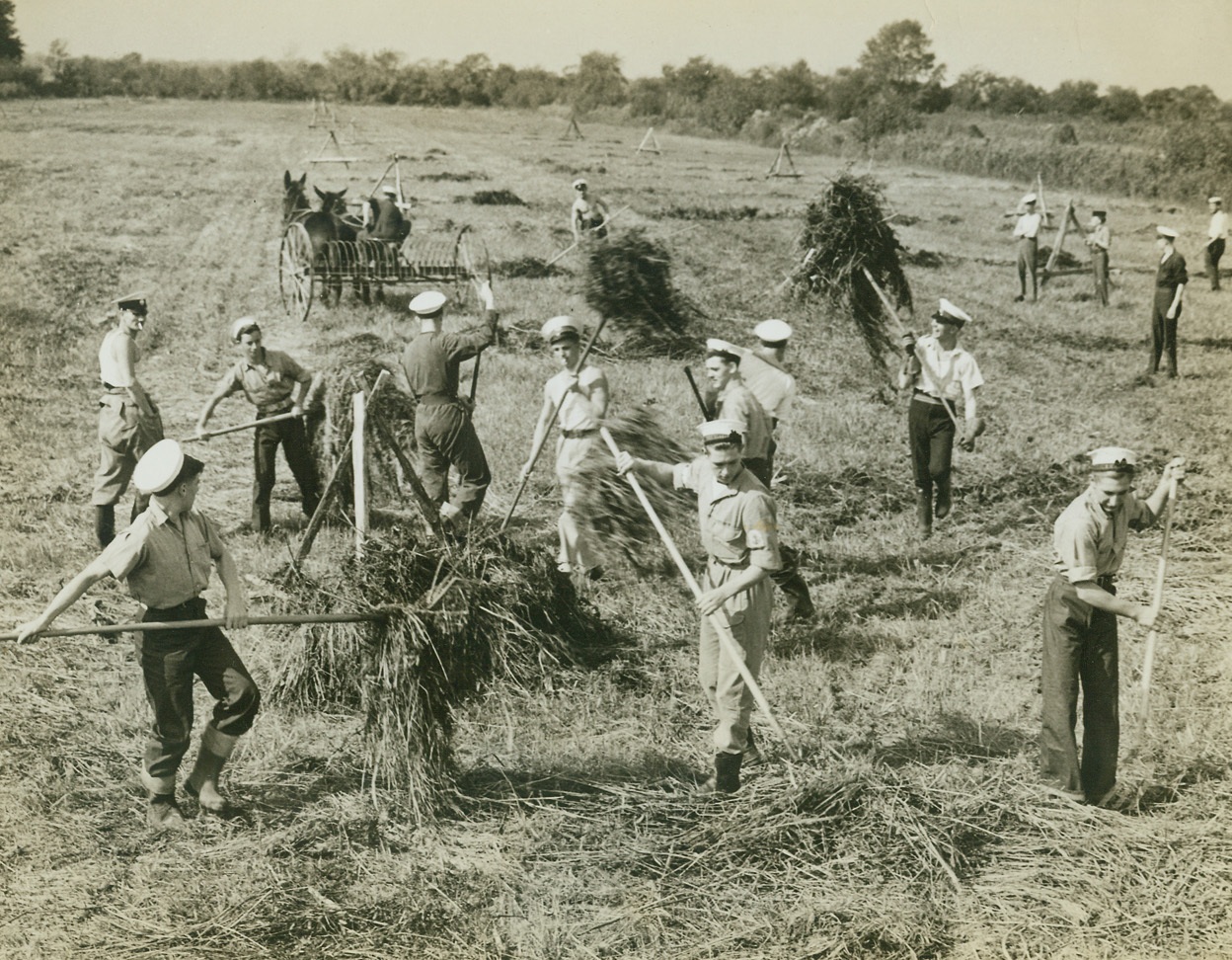
BRITISH SAILORS HARVEST AMERICAN CROPS, 10/23/1942. English sailors, on leave from a British man o’war in a U.S. Navy yard for refitting, lend a hand by harvesting hay on a Virginia farm, where farm labor is at a premium. The British Navy would not allow them to accept pay, but they were royally treated as they spent their leave in American country homes.Credit: Acme;
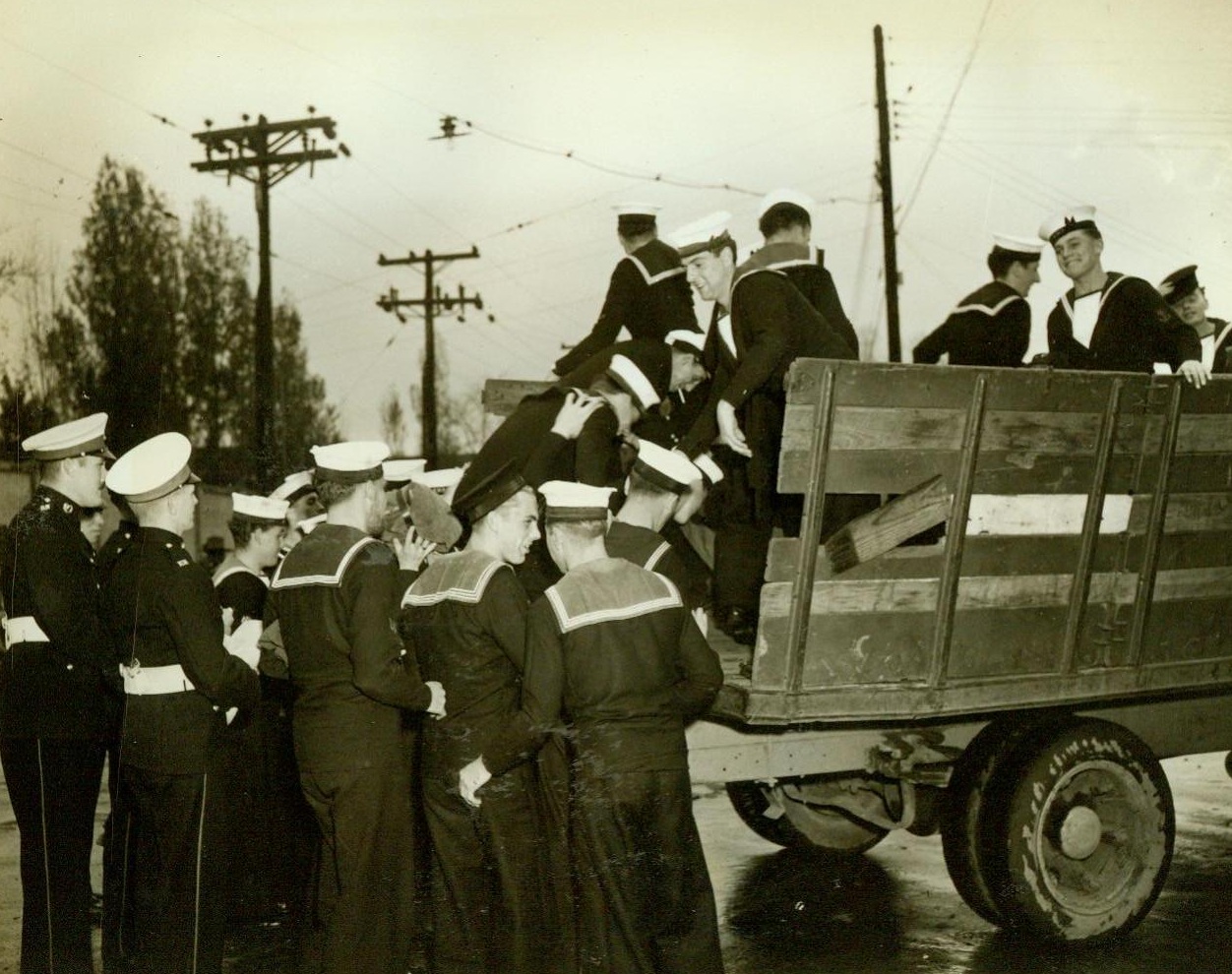
British Sailors Harvest American Crops, 10/23/1942. English sailors on leave from a British Man o’ War that is in a U.S. Navy yard for refitting lend a hand to Virginia truck and dairy farmers sorely in need of farm manpower. Shore leave became a new kind of holiday in the country with the British lads pitching in to help harvest hay and soybean crops. Many of these sailors have been at sea for two years, and found it a real treat to be ashore again. The British Navy would not let them accept pay for their work, but there was no objection to spending their leave in American country homes and, in return, being royally entertained. Here, sailors board a truck en route to a farm. Credit: ACME;
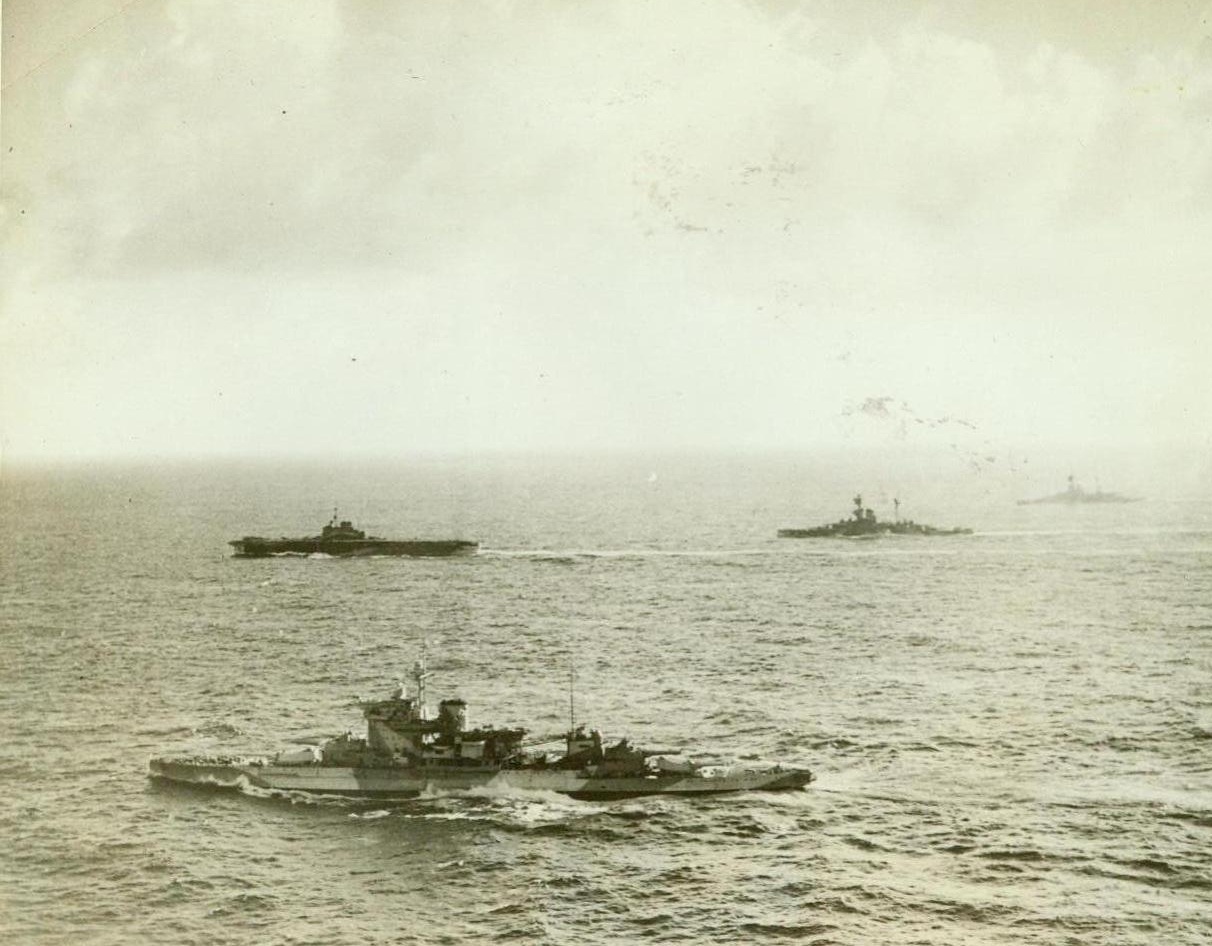
British Fleet in Indian Ocean, 10/23/1942. London -- The powerful British battle squadron in the Indian Ocean includes H.M.S. Warspite (nearest camera); H.M.S. Illustrious; H.M.S. Resolution and H.M.S. Royal Sovereign, viewed from a Fleet Air Arm Fighter. The announcement of the fleet’s presence in the eastern waters follow Gen. Sir Archibald P. Wavell’s declaration that Burma must be retaken from the Japs. Credit: ACME;
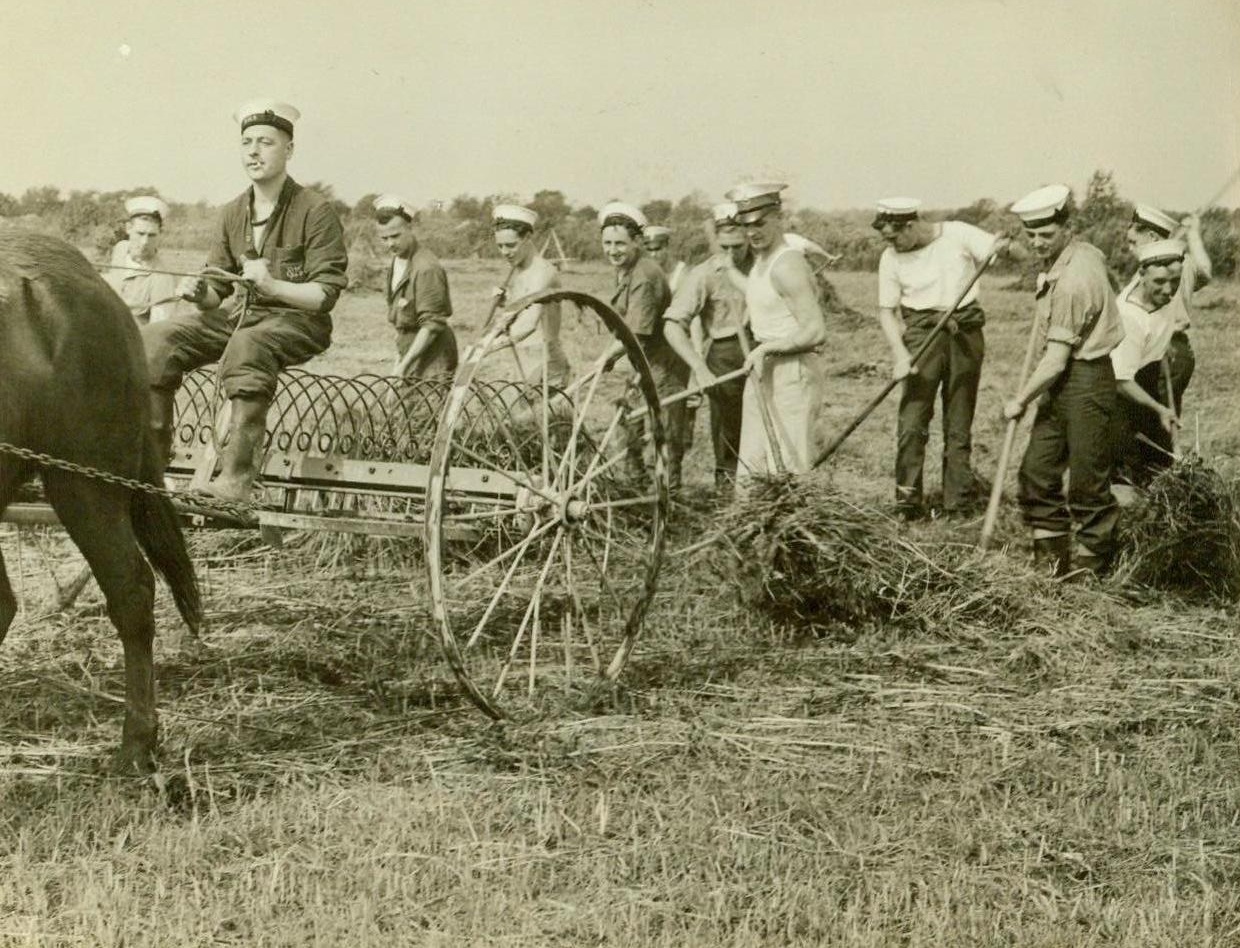
BRITISH SAILORS HARVEST AMERICAN CROPS, 10/23/1942. English sailors, on leave from a British Man o’ War that is in a U.S. Navy shipyard for refitting, harvest hay as they lend a hand to a Virginia farmer sorely in need of farm labor. Many of the sailors had been at sea for two years and found it a real treat to be ashore again. Credit: ACME;
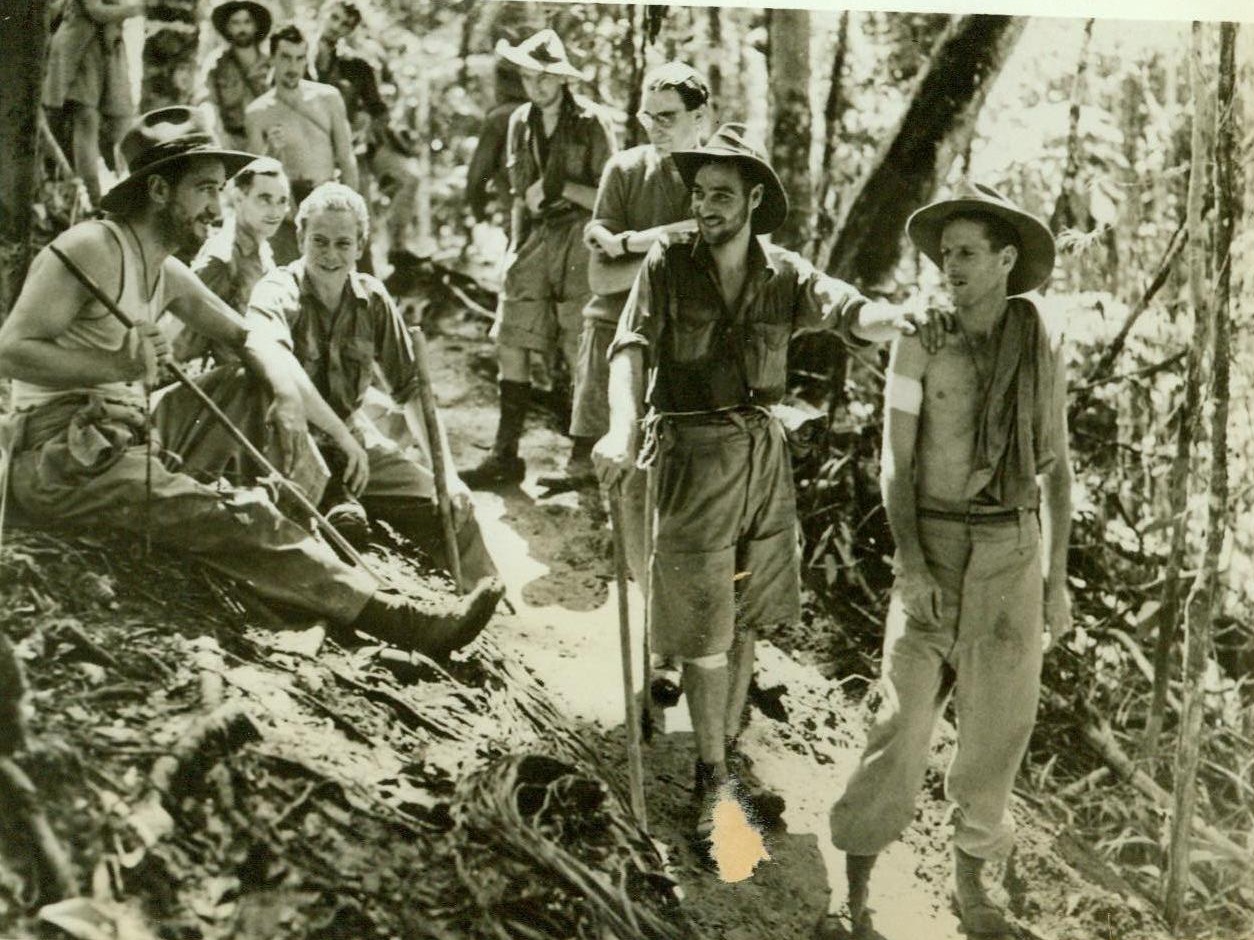
Wounded Aussies on way to rear area, 10/7/1942. NEW GUINEA – Wounded Australian soldiers on their way back from the front lines after engaging the Japanese in the Kokoda area. This is one of the first photos of the men wounded in that section. The men had to walk for almost six days through dense jungle and mountain valleys to reach the base hospital. CREDIT LINE (ACME) 10-7-42;
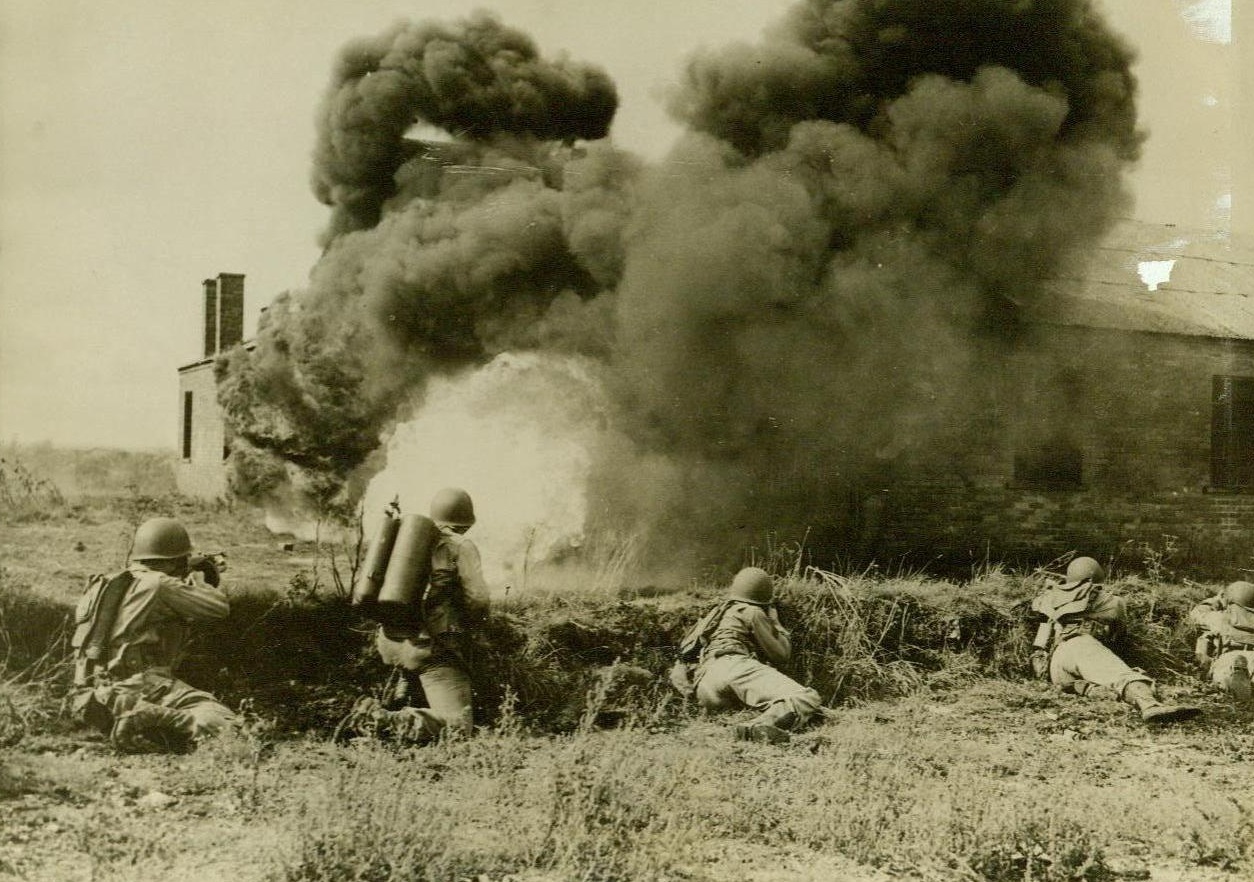
Uncle Sam's fighters holding maneuvers in England, 10/13/1942. Field, N. J, Keeps his flame-thrower pouring liquid fire at an “enemy” strongpoint. His fellow soldiers keep their tommy guns chattering. These men- Uncle Sam’s fighters holding maneuvers in England- were given intensive training in modern warfare and stressed, for the first time in maneuvers in Britain- the use of Chemicals as offensive and defensive weapons. Credit Line (Acme) 10/13/42;
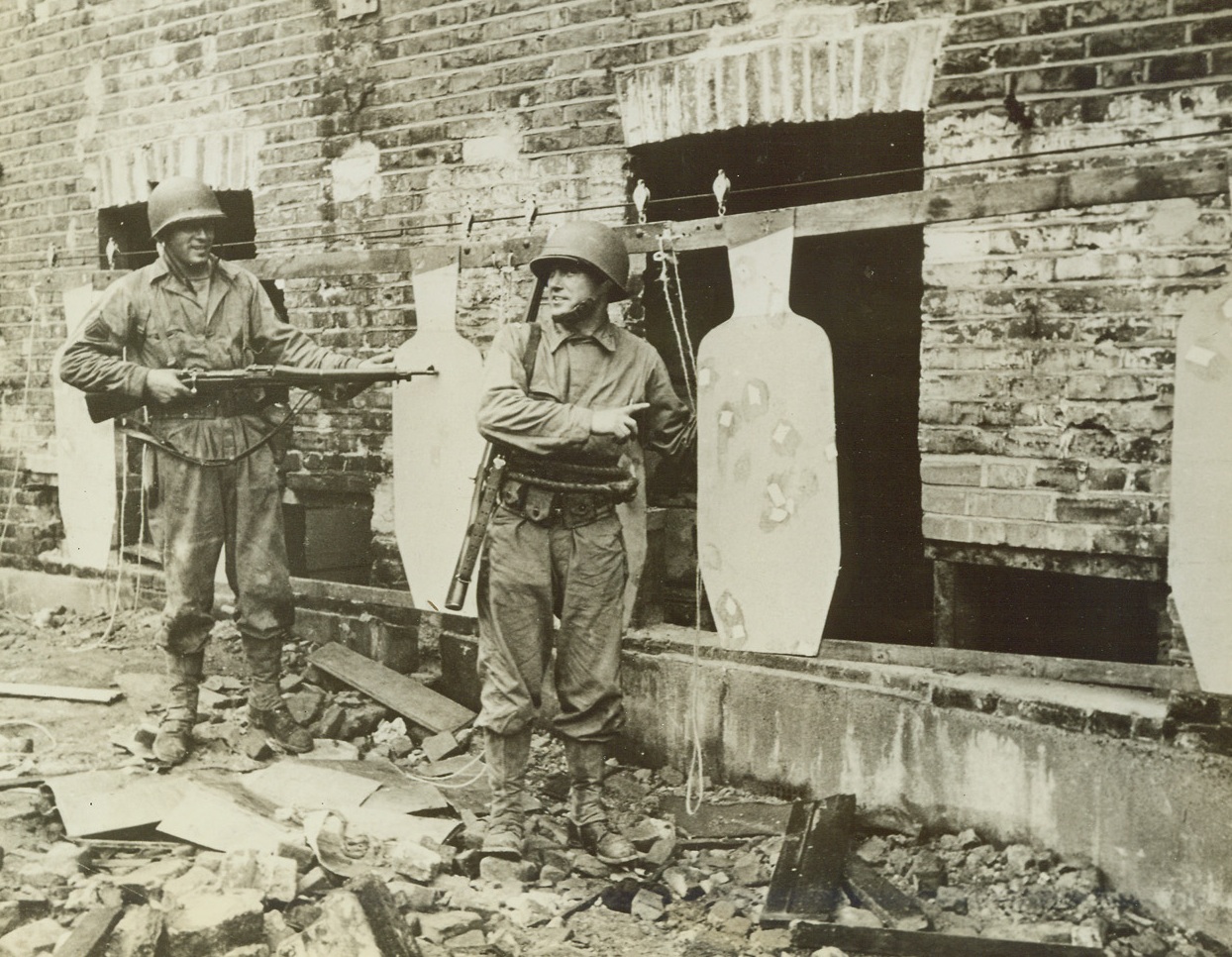
American Rangers Learn Street Fighting, 10/8/1942. London – With the blitzed areas of London a realistic city battleground, American Ranger Troops are mastering the technique of the brand of street fighting that now holds Stalingrad. Peppering targets while on the run, sniping, dodging, scaling ruined walls and using high explosives with lightning speed are now added to the long list of combat methods which make the United States Rangers ready for anything. (Passed by Censors) These bullet-riddled “snipers” were peppered by American Rangers 100 yards away on the run. Stationary and movable targets are blasted by combat units learning to take crack-aim from every conceivable shooting position. Credit: ACME;
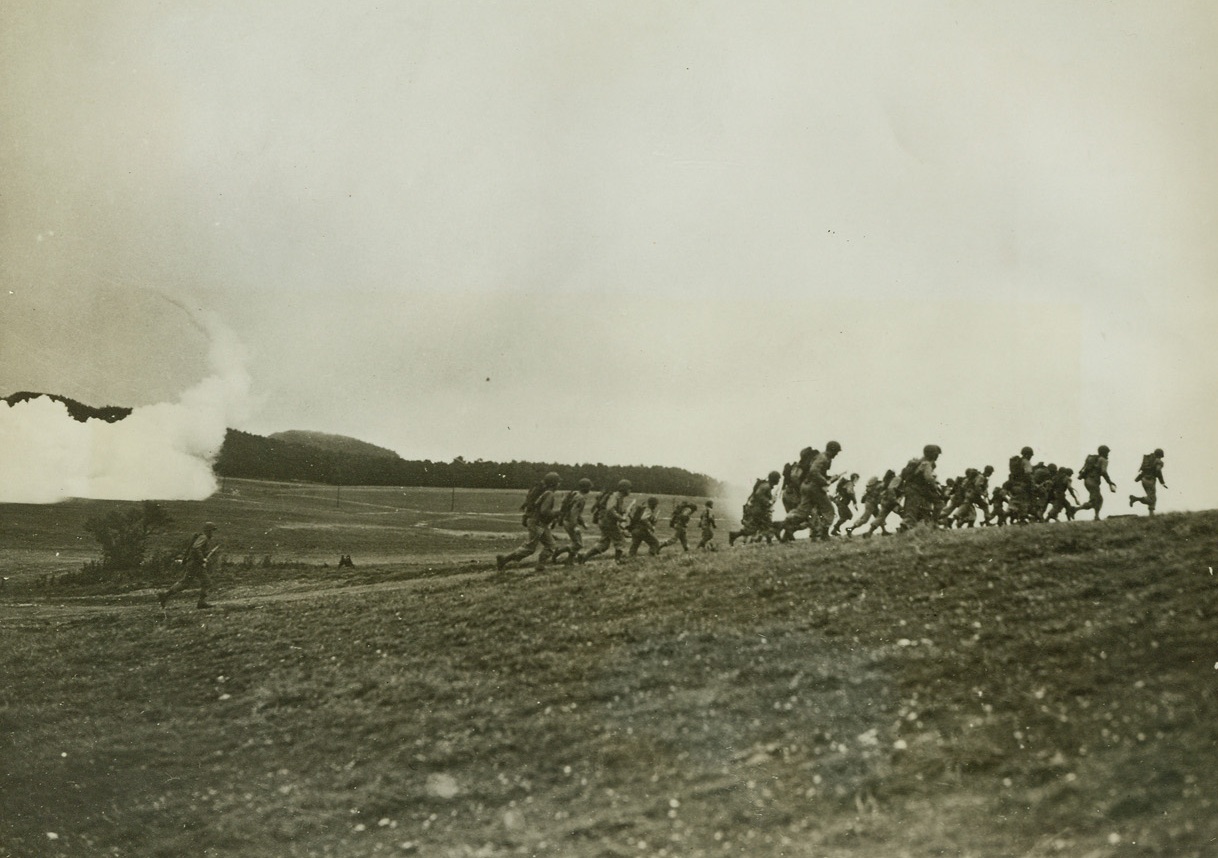
Smoke Screen Hides Advance, 10/13/1942. England – Troops advancing to the crest of a hill make splendid targets for the defenders when they are silhouetted against the sky. To prevent this, low-flying planes lay smoke screens enabling the attackers to meet the foe on a more even plane. U.S. forces in Britain, holding their first maneuvers that stressed the use of chemical warfare, are shown making an advance under such condition. During the maneuvers, an infantry unit was “attacked” by “enemy” planes that dropped smoke bombs to break up their fire-power, and also simulated mustard gas. Mechanized jeeps and scout cars were thrown into the attack, and flame-throwers were used to clean out strong points to give the soldiers a taste of modern fighting. Passed by censor. Credit: ACME;
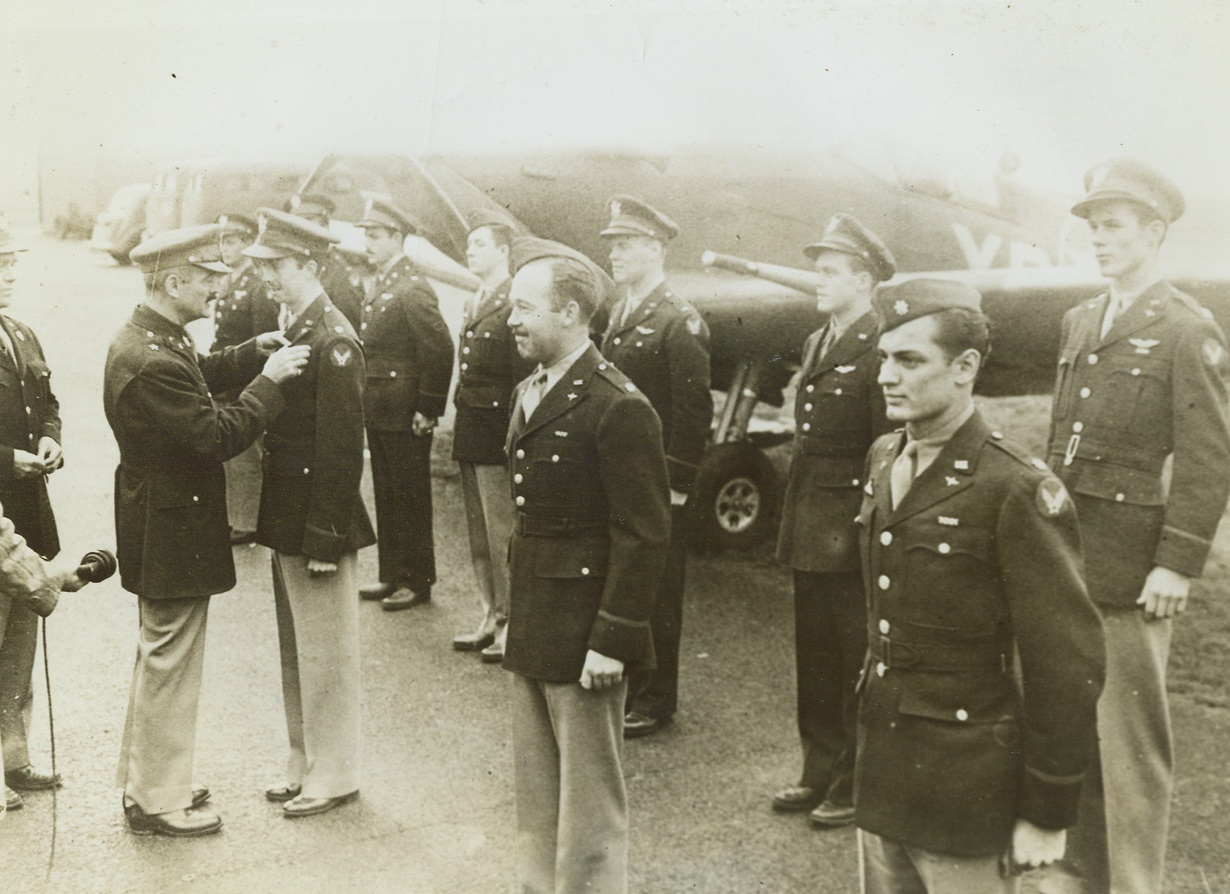
“Eagles” Get Second Pairs of Wings, 10/10/1942. Britain – Brig. Gen. Hunter, commander of the Fighter Command of the U.S. Army Air Forces in Britain, pins a pair of U.S. Air Force wings on Maj. G.A. Daymond of Burbank, California, famed U.S. ace of the RAF’s American Eagle Squadron and holder of the Distinguished Flying Cross and Bar, during a ceremony in which the Eagle Squadron was transferred to the U.S. Army Air Force. Other “Eagles” in front row are Maj. C.W. McColpin, of Buffalo, New York, and Maj. W.J. Daley, DFC, of Amarillo, Texas. Passed by Army censor. Credit: ACME;
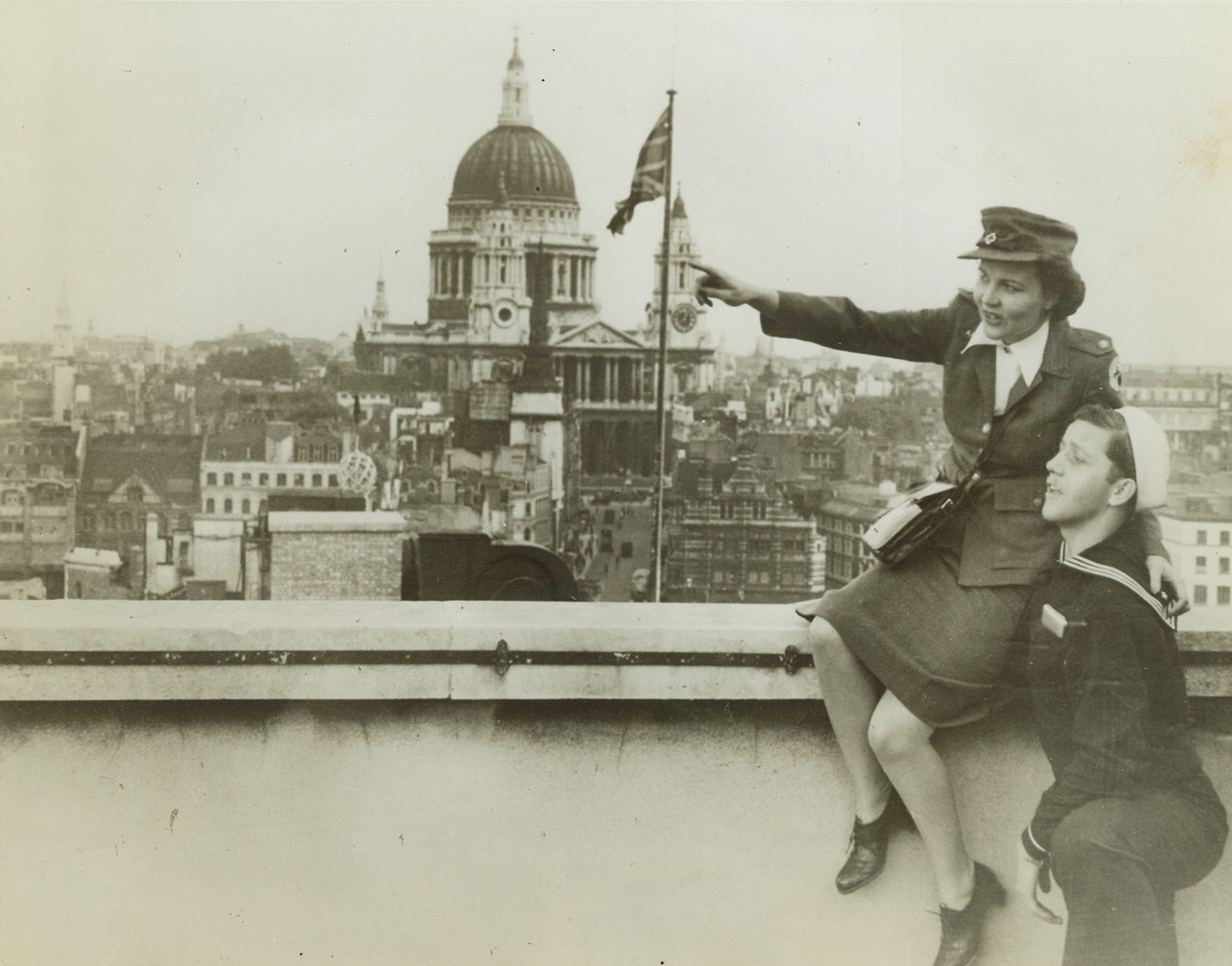
A Roof with a View, 10/2/1942. London – Whatever the American Red Cross worker is pointing out to the American sailor, it leaves him open-mouthed with interest, as they view London from the roof of the Daily Telegraph building on famed Fleet Street. St. Paul’s Cathedral is seen in the distance. Credit: ACME;





 Trash & Recycling
Trash & Recycling
 Online Payments
Online Payments
 City Documents
City Documents
 Parks
Parks
 Traffic Court
Traffic Court
 CITY PARKS
CITY PARKS
 Outdoor Recreation
Outdoor Recreation
 Volunteer
Volunteer
 Home
Home TRANSLATE
TRANSLATE
